Exhibit 99.1
Results for Announcement to the Market
James Hardie Industries N.V.
ARBN 097 829 895
Appendix 4D – Half Year Ended 30 September 2006
| |
|
|
|
|
|
|
|
|
|
|
|
|
|
|
|
|
|
|
|
|
| Key Information |
|
Half Year Ended 30 September |
| |
|
2006 |
|
2005 |
|
|
| |
|
US$M |
|
US$M |
|
Movement |
Net Sales From Ordinary Activities |
|
|
826.9 |
|
|
|
736.0 |
|
|
up |
|
|
|
|
|
|
12 |
% |
Operating Profit After Tax Attributable
to Shareholders |
|
|
56.6 |
|
|
|
103.5 |
|
|
down |
|
|
|
|
|
|
45 |
% |
Operating Profit Attributable to Shareholders |
|
|
56.6 |
|
|
|
103.5 |
|
|
down |
|
|
|
|
|
|
45 |
% |
Net Tangible Assets per Ordinary Share |
|
US$ |
0.30 |
|
|
US$ |
1.54 |
|
|
|
|
|
|
|
|
|
|
|
|
|
Dividend Information
| • |
|
A dividend of US5.0 cents per share/CUFS is payable to share/CUFS holders on 8 January 2007. A dividend of US 4.0 cents
per share/CUFS was paid on 6 July 2006. |
| |
| • |
|
Record Date is 15 December 2006 to determine entitlements to this dividend (ie, on the basis of proper instruments of
transfer received by the Company’s registrar, Computershare Investor Services Pty Ltd, Level 3, 60 Carrington Street,
Sydney NSW 2000, Australia, by 5:00pm if securities are not CHESS approved, or security holding balances established by
5:00pm or such later time permitted by ASTC Operating Rules if securities are CHESS approved). |
| |
| • |
|
This dividend and future dividends will be unfranked for Australian taxation purposes. |
| |
| • |
|
This dividend is subject to Dutch withholding tax of 25%. Many Australian resident holders may reduce the withholding tax
rate to 15% deduction if they are eligible and have completed and lodged a current special Form A before dividend record
date with the Company’s registrar, Computershare Investor Services Pty Ltd, Level 3, 60 Carrington Street, Sydney NSW
2000, Australia. Holders with 25% withholding tax may be eligible to reclaim a portion of the tax after payment date.
For withholding tax information see: www.Jameshardie.com (select Investor Relations, then Shareholder services then Tax
Information) or contact Computershare. |
| |
| • |
|
The Australian currency equivalent amount of dividend to be paid to CUFS holders will be announced to the ASX on 6 December
2006. |
| |
| • |
|
No dividend reinvestment plans are available for this dividend. |
| |
| |
|
Movements in Controlled Entities during the half year ended 30 September
2006 |
| |
| |
|
The following entities were liquidated: RIS Irrigation (Portugal) SA (22 June
2006), Harflex Ltd (16 August 2006) |
| |
| |
|
Review |
| |
| |
|
The results and financial information included within this half year report
have been prepared using USGAAP and have been subject to an independent review by
external auditors. |
Results
for the 2nd Quarter and half year ended 30 September 2006
Contents
| |
1. |
|
Media Release |
| |
| |
2. |
|
Management’s Analysis of Results |
| |
| |
3. |
|
Consolidated Financial Statements |
| |
| |
4. |
|
Management Presentation |
| |
|
James Hardie Industries N.V. is incorporated in
The Netherlands with corporate seat in Amsterdam. The liability of members is
limited The information contained in the above documents comprise the information
required by ASX Listing Rule 4.2A and should be read in conjunction with the
James Hardie 2006 Annual Report which can be found on the company website at
www.jameshardie.com |
| |
|
|
13 November 2006
|
|
Analyst and Media enquiries about results,
please contact Steve Ashe on
Tel: 61 2 8274 5246; Mob: 61 408 164 011 |
2nd quarter and half year net operating profit up 43% and 27% to
US$68.3 million and US$131.0 million, respectively – excluding
asbestos provision
James Hardie today announced that for the three months ended 30 September 2006, net operating
profit, excluding adjustments to the asbestos provision, increased 43% compared to the same quarter
last year, to US$68.3 million from US$47.6 million.
The asbestos provision was increased by A$55.9 million (US$41.8 million) to reflect the results of
the most recent actuarial estimate prepared by KPMG Actuaries Pty Ltd (KPMG Actuaries) and to
adjust for payments made to claimants during the half year. Additionally, the provision was
adjusted for the effect of foreign exchange leading to a charge of US$5.4 million for the quarter.
These adjustments (with no current cash impact) reduced net operating profit to US$21.1 million,
down 56% compared to the same quarter last year.
For the half year, net operating profit excluding adjustments to the asbestos provision increased
27% to US$131.0 million from US$103.5 million. Including the adjustments to the asbestos provision
of US$74.4 million (of which US$32.6 million related to the effect of foreign exchange for the half
year), net operating profit decreased 45% to US$56.6 million.
The asbestos provision is based on an estimate of future Australian asbestos-related liabilities in
accordance with the Final Funding Agreement (FFA) that was signed with the New South Wales (NSW)
Government on 1 December 2005.
Operating performance
The 2nd quarter highlights include a 9% lift in net sales to US$411.4 million and a 13%
increase in gross profit to US$155.2 million. EBIT decreased 46% from US$76.4 million to US$41.0
million. EBIT for the quarter includes an expense of US$47.2 million related to adjustments to the
asbestos provision. EBIT excluding adjustments to asbestos provision increased by 15% to US$88.2
million.
The USA Fibre Cement business was again the standout performer, lifting 2nd quarter net
sales 10% and EBIT 14% compared to the same period last year, in a softer US housing market and a
period of higher input costs. For the half year, net sales increased 16% and EBIT was up 12%
compared to the same period last year.
In this Media Release, James Hardie may present the financial measures, sales volume terms,
financial ratios, and Non-US GAAP financial measures included in the Definitions section of this
document starting on page 9. The company presents financial measures that it believes are
customarily used by its Australian investors. Specifically, these financial measures include
“EBIT”, “EBIT margin”, “Operating profit” and “Net operating profit”. The company may also present
other terms for measuring its sales volumes (“million square feet (mmsf)” and “thousand square feet
(msf)”); financial ratios (“Gearing ratio”, “Net interest expense cover”, “Net interest paid
cover”, “Net debt payback”, “Net debt/cash”); and Non-US GAAP financial measures (“EBIT and EBIT
margin excluding adjustments to asbestos provision”, “EBIT and EBIT margin excluding adjustments to
asbestos provision, and SCI and other related expenses”, “Net operating profit excluding
adjustments to asbestos provision”, “Net operating profit excluding adjustments to asbestos
provision, SCI and other related expenses and make-whole payment”, “Effective tax rate excluding
the adjustments to asbestos provision and write-back of tax provision”, “Diluted earnings per share
excluding adjustments to asbestos provision and tax provision write-back” and “EBITDA”). Unless
otherwise stated, results are for comparisons are of the 2nd quarter and 1st
half of the current fiscal year versus the 2nd quarter and 1st half of the
prior fiscal year.
The 2nd quarter saw no improvement in market conditions for the Asia Pacific Fibre
Cement businesses. Sales volumes increased in the Australia and New Zealand and the Philippines
businesses, but the impact of lower prices in Australia and unfavourable foreign exchange movements
resulted in EBIT for the second quarter being 4% lower, compared to the same period last year. For
the half year, net sales and EBIT were down 2% and 11%, respectively.
Diluted earnings per share for the quarter decreased to US4.5 cents in the second quarter from
US10.2 cents, and to US12.1 cents from US22.3 cents for the half year, compared to the same periods
last year.
Diluted earnings per share excluding adjustments to the asbestos provision and a tax provision
write-back of US$7.4 million increased by 28% from US10.2 cents to US13.1 cents for the quarter and
by 19% from US22.3 cents to US26.5 cents for the half year.
2nd Quarter and First Half at a Glance
| |
|
|
|
|
|
|
|
|
|
|
|
|
|
|
|
|
|
|
|
|
|
|
|
|
| US$ Million |
|
Q2 FY07 |
|
Q2 FY06 |
|
%+ (-) |
|
HY FY07 |
|
HY FY06 |
|
%+ (-) |
Net sales |
|
$ |
411.4 |
|
|
$ |
376.6 |
|
|
|
9 |
|
|
$ |
826.9 |
|
|
$ |
736.0 |
|
|
|
12 |
|
|
|
|
|
|
|
|
|
|
|
|
|
|
|
|
|
|
|
|
|
|
|
|
|
|
Gross profit |
|
|
155.2 |
|
|
|
137.3 |
|
|
|
13 |
|
|
|
312.9 |
|
|
|
282.6 |
|
|
|
11 |
|
|
|
|
|
|
|
|
|
|
|
|
|
|
|
|
|
|
|
|
|
|
|
|
|
|
SCI and other related expenses |
|
|
(3.2 |
) |
|
|
(4.7 |
) |
|
|
(32 |
) |
|
|
(5.6 |
) |
|
|
(9.9 |
) |
|
|
(43 |
) |
| |
EBIT excluding adjustments to
asbestos provision |
|
|
88.2 |
|
|
|
76.4 |
|
|
|
15 |
|
|
|
184.3 |
|
|
|
163.3 |
|
|
|
13 |
|
|
|
|
|
|
|
|
|
|
|
|
|
|
|
|
|
|
|
|
|
|
|
|
|
|
Adjustments to asbestos provision |
|
|
(47.2 |
) |
|
|
— |
|
|
|
— |
|
|
|
(74.4 |
) |
|
|
— |
|
|
|
— |
|
|
|
|
|
|
|
|
|
|
|
|
|
|
|
|
|
|
|
|
|
|
|
|
|
|
EBIT |
|
|
41.0 |
|
|
|
76.4 |
|
|
|
(46 |
) |
|
|
109.9 |
|
|
|
163.3 |
|
|
|
(33 |
) |
|
|
|
|
|
|
|
|
|
|
|
|
|
|
|
|
|
|
|
|
|
|
|
|
|
Net interest income (expense) |
|
|
1.0 |
|
|
|
(1.0 |
) |
|
|
— |
|
|
|
(1.0 |
) |
|
|
(1.7 |
) |
|
|
(41 |
) |
|
|
|
|
|
|
|
|
|
|
|
|
|
|
|
|
|
|
|
|
|
|
|
|
|
Income tax expense |
|
|
(20.9 |
) |
|
|
(27.8 |
) |
|
|
(25 |
) |
|
|
(53.2 |
) |
|
|
(58.1 |
) |
|
|
(8 |
) |
|
|
|
|
|
|
|
|
|
|
|
|
|
|
|
|
|
|
|
|
|
|
|
|
|
Net operating profit |
|
|
21.1 |
|
|
|
47.6 |
|
|
|
(56 |
) |
|
|
56.6 |
|
|
|
103.5 |
|
|
|
(45 |
) |
| |
The results include Special Commission of Inquiry (SCI) and other related expenses of US$3.2
million for the quarter and US$5.6 million for the half year (US$3.0 million and US$5.2 million
after tax, respectively), a tax provision write-back of US$7.4 million for the quarter and half
year, and for the half year only, a make-whole payment of US$6.0 million (US$5.6 million after tax)
resulting from the prepayment of US$-denominated debt in May 2006.
Net operating profit excluding adjustment to the asbestos provision, SCI and other related
expenses, the make-whole payment and the tax provision write-back, increased 23% for the quarter to
US$63.9 million and 19% to US$134.4 million for the half year as shown in the following table:
|
|
|
| |
|
|
| Media Release: James Hardie — 2nd Quarter and Half Year FY07
|
|
2 |
| |
|
|
|
|
|
|
|
|
|
|
|
|
|
|
|
|
|
|
|
|
|
|
|
|
| US$ Million |
|
Q2 FY07 |
|
Q2 FY06 |
|
% Change |
|
HY FY07 |
|
HY FY06 |
|
% Change |
Net operating profit |
|
$ |
21.1 |
|
|
$ |
47.6 |
|
|
|
(56 |
) |
|
$ |
56.6 |
|
|
$ |
103.5 |
|
|
|
(45 |
) |
|
|
|
|
|
|
|
|
|
|
|
|
|
|
|
|
|
|
|
|
|
|
|
|
|
Adjustments to asbestos provision |
|
|
47.2 |
|
|
|
— |
|
|
|
— |
|
|
|
74.4 |
|
|
|
— |
|
|
|
— |
|
| |
|
|
|
|
|
|
|
|
|
|
|
|
|
|
|
|
|
|
|
|
|
|
|
|
|
|
|
Net operating profit excluding adjustments
to asbestos provision |
|
|
68.3 |
|
|
|
47.6 |
|
|
|
43 |
|
|
|
131.0 |
|
|
|
103.5 |
|
|
|
27 |
|
|
|
|
|
|
|
|
|
|
|
|
|
|
|
|
|
|
|
|
|
|
|
|
|
|
SCI and other related expenses (net of tax) |
|
|
3.0 |
|
|
|
4.4 |
|
|
|
(32 |
) |
|
|
5.2 |
|
|
|
9.3 |
|
|
|
(44 |
) |
|
|
|
|
|
|
|
|
|
|
|
|
|
|
|
|
|
|
|
|
|
|
|
|
|
Debt make-whole payment (net of tax) |
|
|
— |
|
|
|
— |
|
|
|
— |
|
|
|
5.6 |
|
|
|
— |
|
|
|
— |
|
|
|
|
|
|
|
|
|
|
|
|
|
|
|
|
|
|
|
|
|
|
|
|
|
|
Tax provision write-back |
|
|
(7.4 |
) |
|
|
— |
|
|
|
— |
|
|
|
(7.4 |
) |
|
|
— |
|
|
|
— |
|
| |
|
|
|
|
|
|
|
|
|
|
|
|
|
|
|
|
|
|
|
|
|
|
|
|
|
|
|
Net operating profit excluding adjustments
to asbestos provision, SCI and other
related expenses, make-whole payment and
tax provision write-back |
|
$ |
63.9 |
|
|
$ |
52.0 |
|
|
|
23 |
|
|
$ |
134.4 |
|
|
$ |
112.8 |
|
|
|
19 |
|
| |
Commentary
James Hardie’s Chief Executive Officer, Louis Gries said: “Our USA Fibre Cement business continued
to perform strongly in a much softer US housing market, delivering good top-line and bottom-line
growth for the 2nd quarter and half year.
“We expect US housing conditions to soften further and remain challenging, at least in the
short-term, although the fundamental drivers of housing demand suggest the longer-term outlook is
encouraging.
“We remain well positioned to continue outperforming the market overall and generate good returns
through our ability to grow market share and maintain attractive margins.
“An important milestone in the implementation of our voluntary asbestos compensation funding
proposal was passed late last week with the receipt of favourable taxation rulings from the
Australian Taxation Office. We are now seeking to finalise an amended FFA and related agreements
with the NSW Government and hope to hold a shareholder meeting in February 2007 when we will ask
shareholders to consider the proposal.” said Mr Gries.
Dividend
The company today announced an interim dividend of US5.0 cents a share. The dividend was declared
in United States currency and will be paid on 8 January 2007, with a record date of 15 December
2006. The Australian currency equivalent of the dividend to be paid to CUFS holders will also be
announced to the ASX on that date. ADR holders will receive their dividend in United States
currency.
USA Fibre Cement
Despite a much softer US housing market, further penetration of our targeted markets helped
increase net sales 10% compared to the same quarter last year to US$339.0 million. Sales volume
increased 3% to 573.4 million square feet, and the average net sales price was 7% higher at US$591
per thousand square feet.
In our exterior products segment, sales volumes were flat in both our emerging and established
geographic markets compared to the same quarter last year, with further market penetration against
alternative siding such as wood and vinyl providing a buffer against the impact of the softer
market.
|
|
|
| |
|
|
| Media Release: James Hardie — 2nd Quarter and Half Year FY07
|
|
3 |
Sales of all value-added, differentiated products including Heritage® panels, ColorPlus®
pre-painted siding, Hardiebacker 500® and XLD® trim grew strongly during the quarter.
The increase in net sales was partly offset by higher raw material costs, including pulp which was
at its highest level for many years, and higher SG&A expenses. EBIT for the quarter was up 14% to
US$97.8 million. The EBIT margin was 28.8%.
For the half year, net sales increased by 16% to US$687.9 million driven by a 9% increase in sales
volumes, to 1,179.1 million square feet, and a 6% increase in the average net selling price to
US$583 per thousand square feet. EBIT for the six months increased by 12% to US$201.1 million and
the EBIT margin was 29.2%.
Australia and New Zealand (ANZ) Fibre Cement
Despite sales volumes increasing 4% for the quarter compared to the same period last year, net
sales were down by 2% to US$56.8 million compared to US$57.8 million in the same period last year.
In Australian dollars, net sales were 1% lower due to the impact of competition on the average net
sales price.
The new housing and renovations markets remained soft during the quarter but the business lifted
demand through market initiatives designed to grow primary demand for its products, including
providing more value-added, differentiated products. A new premium-branded Scyon™ suite of
value-added, differentiated products was launched during the quarter including proprietary Scyon™
Wet Area Flooring; Scyon™ Trim; Scyon™ Cavity Trim; Scyon™ Axon™ cladding; and Scyon™ Matrix
cladding. These products are expected to help demand continue to grow faster than the market
overall.
EBIT was 2% lower for the quarter at US$11.1 million due to lower net sales, increased
manufacturing costs, partially offset by a reduction in SG&A costs. The EBIT margin was 19.5%.
For the half year, sales fell 3% to US$110.2 million compared to US$113.9 million in the same
period last year. EBIT was down 11% to US$20.0 million. The EBIT margin for the half year was
18.1%.
Philippines – EBIT positive
Net sales increased for the quarter and half year compared to the same periods last year as the
business improved its market penetration in the new residential and commercial segments. The
business recorded a small positive EBIT for the quarter and half year.
USA Hardie Pipe – Progress continuing
Net sales for the quarter and half year increased compared to the same periods last year. The
business is continuing to focus on growing sales in its core markets and improving profitability
and recorded a small positive EBIT for the quarter and the half year.
Europe Fibre Cement – Sales increasing
The business is continuing to grow sales and is building awareness of its backer and siding
products among distributors, builders and contractors.
Income tax
The company’s effective tax rate of 49.8% for the quarter and 48.9% for the half year were affected
by adjustments to the asbestos provision and the write-back of a tax provision of US$7.4 million
that is no
|
|
|
| |
|
|
| Media Release: James Hardie — 2nd Quarter and Half Year FY07
|
|
4 |
longer required. The effective tax rate excluding adjustments to the asbestos provision and the
tax provision write-back was 31.7% for the quarter and 33.1% for the half year.
Disputed Amended Australian Tax Assessment
As announced on 22 March 2006, RCI Pty Ltd (RCI), a wholly owned subsidiary of the company,
received an amended assessment from the Australian Taxation Office (ATO) in respect of RCI’s income
tax return for the year ended 31 March 1999. The amended assessment relates to the amount of net
capital gains arising as a result of an internal corporate restructure carried out in 1998 and was
issued pursuant to the discretion granted to the Commissioner of Taxation under Part IVA of the
Income Tax Assessment Act 1936. The original amended assessment issued to RCI was for a total of
A$412.0 million. However, after a subsequent remission of general interest charges by the ATO, the
total was changed to A$378.0 million comprising A$172.0 million of primary tax after allowable
credits, A$43.0 million of penalties (representing 25% of primary tax) and A$163.0 million of
general interest charges.
RCI is appealing the amended assessment. On 5 July 2006, pursuant to the agreement negotiated with
the ATO and in accordance with the ATO Receivable Policy, the company made a payment of A$189.0
million (US$141.4 million). The company also agreed to guarantee the payment of the remaining 50%
of the amended assessment in the event the appeal is unsuccessful and to pay general interest
charges accruing on the unpaid balance of the amended assessment in arrears on a quarterly basis.
However, the company has not recorded any liability at 30 September 2006 for the remainder of the
amended assessment because, at this time, the company believes RCI’s view of its tax position will
be upheld on appeal, therefore no such liability is probable in accordance with US accounting
standards.
The company has treated the payment on 5 July 2006 as a deposit in the financial statements and it
intends to treat any future payments as a deposit pending resolution of this matter.
Asbestos Compensation Funding Agreement
The FFA is subject to a number of as yet unfulfilled conditions precedent. The company considers
that the principal outstanding condition to be fulfilled before the FFA becomes effective is
receiving the approval of James Hardie’s lenders and shareholders.
On 23 June 2006, the ATO advised the company that it declined to endorse the SPF as a tax
concession charity, arguing that, in its opinion, the scope of its activities under the Trust Deed
and the FFA did not meet current legislative requirements for such an endorsement.
On 29 June 2006, the ATO issued a ruling to the company to the effect that James Hardie’s
contributions to the SPF would be tax deductible over the anticipated life of the arrangements in
accordance with “black hole expenditure” Federal Legislation enacted in April 2006.
In mid-October James Hardie submitted to the ATO a revised draft FFA and other draft transaction
documents, together with private ruling applications relating to the tax treatment of the proposed
revised arrangements.
On 9 November 2006, James Hardie announced that it, the SPF and others had received private binding
rulings that the company believes will deliver an acceptable outcome for the proposed SPF. The
rulings have also been welcomed by the New South Wales Government and the Australian Council of
Trade Unions, with whom James Hardie settled the terms of the FFA and related agreements.
The company is now seeking to finalise an amended FFA and related agreements with the NSW
Government so that all relevant documents can be signed as soon as possible and lender and
shareholder approval sought. In order to do so, James Hardie and the NSW Government need to execute
an amended FFA in a form which reflects the changes which were the subject of the ruling
applications. In recent weeks the NSW Government and James Hardie have worked together to obtain
these rulings. Throughout this process, James Hardie has provided the NSW Government with copies
of submissions provided to the ATO, including relevant draft agreements, and copies of the private
rulings.
|
|
|
| |
|
|
| Media Release: James Hardie — 2nd Quarter and Half Year FY07
|
|
5 |
In order to implement the amended FFA, certain conditions precedent will need to be satisfied,
including the NSW Parliament passing facilitating legislation. The resolution of these issues
involves uncertainty and there can be no assurance that the obtaining of the ATO rulings will lead
to a finalisation of the amended FFA that is required to resolve the position, or that the NSW
Parliament will pass such facilitating legislation. It is possible that further amendments to the
FFA and related agreements or to such facilitating legislation may be sought or necessary in order
to achieve an arrangement which is fully acceptable to the NSW Government as well as James Hardie.
However, James Hardie believes (and understands that the NSW Government agrees) that the obtaining
of the ATO rulings is an important milestone towards implementing the funding proposal.
It is anticipated that an extraordinary general meeting of shareholders to approve the
implementation of the amended FFA could be convened within 10 weeks of James Hardie and the NSW
Government executing the amended FFA. Given the close proximity to the Christmas and New Year
holiday period and the difficulty of convening shareholder meetings during this period, the company
expects this meeting could be held in February 2007.
James Hardie and other relevant parties are well advanced in their work to secure lender approval,
obtain an independent experts’ report and prepare the Explanatory Memorandum for shareholders.
James Hardie has offered to provide interim funding to Amaca in the event that Amaca’s finances are
otherwise exhausted before the FFA is implemented in full. Negotiations to settle the commercial
terms of such funding have been held, and it is expected that James Hardie will enter into interim
funding documentation during November.
Readers are referred to Note 7 of the company’s 30 September 2006 Financial Report for further
information on the voluntary funding proposal, and for information on the SCI and other related
matters.
Adjustments to Asbestos Provision
At 30 September 2006, the asbestos provision was increased by A$55.9 million (US$41.8 million) to
reflect the results of the most recent actuarial estimate prepared by KPMG Actuaries and for
payments made to claimants by the Medical Research and Compensation Foundation during the half
year.
The asbestos provision is denominated in Australian dollars. The reported value of this liability
in the company’s condensed consolidated balance sheets in US dollars is therefore subject to
adjustment depending on the closing exchange rate between the two currencies at the balance sheet
date.
The effect of these adjustments is shown in the following table:
| |
|
|
|
|
|
|
|
|
|
|
|
|
| |
|
|
|
|
|
A$ to US$ |
|
|
| |
|
A$ millions |
|
rate |
|
US$ millions |
At 31 March 2006 |
|
|
A$1,000.0 |
|
|
|
1.3975 to 1 |
|
|
US$ |
715.6 |
|
Effect of foreign exchange for the half year |
|
|
— |
|
|
|
|
|
|
|
32.6 |
|
Other adjustments |
|
|
55.9 |
|
|
|
1.3365 to 1 |
|
|
|
41.8 |
|
| |
|
|
At 30 September 2006 |
|
|
A$1,055.9 |
|
|
|
1.3365 to 1 |
|
|
US$ |
790.0 |
|
| |
|
|
|
|
|
|
|
|
|
|
|
|
|
|
|
At 30 June 2006 |
|
|
A$1,000.0 |
|
|
|
1.3463 to 1 |
|
|
US$ |
742.8 |
|
Effect of foreign exchange for the second quarter |
|
|
— |
|
|
|
|
|
|
|
5.4 |
|
Other adjustments |
|
|
55.9 |
|
|
|
1.3365 to 1 |
|
|
|
41.8 |
|
| |
|
|
At 30 September 2006 |
|
|
A$1,055.9 |
|
|
|
1.3365 to 1 |
|
|
US$ |
790.0 |
|
| |
|
|
|
| |
|
|
| Media Release: James Hardie — 2nd Quarter and Half Year FY07
|
|
6 |
Cash flow
Operating cash flow for the half year fell from US$147.8 million to a utilisation of US$22.3
million, primarily due to the A$189.0 million (US$141.4 million) ATO deposit payment. Operating
cash flow also decreased as a result of an increase of US$5.7 million in investment in working
capital and US$7.8 million higher income tax payments.
Capital expenditure for the purchase of property, plant and equipment decreased from US$75.0
million to US$61.4 million for the half year.
Outlook
In North America, a further softening in demand for new residential housing is expected in the
short-term with the US-based National Association of Home Builders reporting that the heavy supply
of houses for sale points toward further declines in new starts in the months ahead.
The current weakened market conditions reflect lower housing affordability, a large inventory of
unsold homes and investors leaving the market. However, regional variances in the impact are
expected to continue.
Repair and remodelling activity is expected to remain ahead of activity levels in new residential
construction in the short-term.
Volume growth is likely to be affected further in the 3rd quarter, but the business
expects to continue outperforming the market overall by taking more market share from alternative
materials and by increasing the proportion of value-added differentiated products in its sales mix.
Input costs are expected to remain high in the short-term with the cost of raw materials,
particularly pulp, at very high levels. Attractive margins are expected to be maintained in the
short-term despite the higher costs.
In the Australia and New Zealand business, market conditions are expected to remain challenging
with no near-term improvement in sight. Further volume growth is expected due to initiatives to
grow primary demand, but the average selling price is expected to remain under pressure due to
price competition in Australia.
In the Philippines, the building and construction market is expected to remain under pressure for
the remainder of the year, but a small improvement in net sales is expected.
In addition, as discussed in Note 7 of the company’s 30 September 2006 Financial Report, the
asbestos provision will be updated annually, based on the most recent actuarial determinations and
claims experience, and quarterly, to reflect changes in foreign exchange rates. Such updates may
have a material impact on James Hardie’s consolidated financial statements.
The current range of analyst earnings estimates1 for the fiscal year ending 31 March
2007 is for net profit from continuing operations excluding all asbestos related expenses to be
US$206 million to US$237 million. While uncertainty surrounding the short to medium-term strength
of the US housing market remains at its highest level in recent years, the company’s current
projection for fiscal year 2007 is for net profit from continuing operations excluding asbestos
related expenses to fall within this range.
END
|
|
|
| 1. |
|
Includes: ABN Amro, Credit Suisse, Deutsche Bank, Goldman Sachs JB Were, Macquarie Research, Merill Lynch, UBS and JPMorgan |
|
|
|
| |
|
|
| Media Release: James Hardie — 2nd Quarter and Half Year FY07
|
|
7 |
Media/Analyst Enquiries:
Steve Ashe
Vice President Investor Relations
| |
|
|
Telephone:
|
|
61 2 8274 5246 |
Mobile:
|
|
61 408 164 011 |
Email:
|
|
[email protected] |
Facsimile:
|
|
61 2 8274 5218 |
This Media Release forms part of a package of information about the company’s results. It should
be read in conjunction with the other parts of the package, including Management’s Analysis of
Results, a Management Presentation, and a Financial Report.
These documents, along with a webcast of the management presentation on 13 November 2006, are
available from the Investor Relations section of James Hardie’s
website at: www.jameshardie.com
|
|
|
| |
|
|
| Media Release: James Hardie — 2nd Quarter and Half Year FY07
|
|
8 |
Definitions
Financial Measures – US GAAP equivalents
EBIT and EBIT margin – EBIT is equivalent to the US GAAP measure of operating income.
EBIT margin is defined as EBIT as a percentage of net sales. James Hardie believes EBIT and EBIT
margin to be relevant and useful information as these are the primary measures used by management
to measure the operating profit or loss of its business. EBIT is one of several metrics used by
management to measure the earnings generated by the company’s operations, excluding interest and
income tax expenses. Additionally, EBIT is believed to be a primary measure and terminology used by
its Australian investors. EBIT and EBIT margin should be considered in addition to, but not as a
substitute for, other measures of financial performance reported in accordance with accounting
principles generally accepted in the United States of America. EBIT and EBIT margin, as the company
has defined them, may not be comparable to similarly titled measures reported by other companies.
Operating profit – is equivalent to the US GAAP measure of income.
Net operating profit – is equivalent to the US GAAP measure of net income.
Sales Volumes
mmsf – million square feet, where a square foot is defined as a standard square foot
of 5/16” thickness.
msf – thousand square feet, where a square foot is defined as a standard square foot of
5/16” thickness.
Financial Ratios
Gearing Ratio – Net debt/cash divided by net debt/cash plus shareholders’ equity.
Net interest expense cover – EBIT divided by net interest expense.
Net interest paid cover – EBIT divided by cash paid during the period for interest, net of
amounts capitalised.
Net debt payback – Net debt/cash divided by cash flow from operations.
Net debt/cash – short-term and long-term debt less cash and cash equivalents.
Non-US GAAP Financial Measures
EBIT and EBIT margin excluding adjustments to asbestos provision – EBIT and EBIT
margin excluding adjustments to asbestos provision are not measures of financial performance under
US GAAP and should not be considered to be more meaningful than EBIT and EBIT margin. James Hardie
has included these financial measures to provide investors with an alternative method for assessing
its operating results in a manner that is focussed on the performance of its ongoing operations and
provides useful information regarding its financial condition and results of operations. The
company uses these non-US GAAP measures for the same purposes.
| |
|
|
|
|
|
|
|
|
|
|
|
|
|
|
|
|
| |
|
Q2 |
|
Q2 |
|
HY |
|
HY |
| US$ Million |
|
FY07 |
|
FY06 |
|
FY07 |
|
FY06 |
EBIT |
|
$ |
41.0 |
|
|
$ |
76.4 |
|
|
$ |
109.9 |
|
|
$ |
163.3 |
|
|
|
|
|
|
|
|
|
|
|
|
|
|
|
|
|
|
Adjustments to asbestos provision |
|
|
47.2 |
|
|
|
— |
|
|
|
74.4 |
|
|
|
— |
|
| |
|
|
EBIT excluding adjustments to asbestos provision |
|
|
88.2 |
|
|
|
76.4 |
|
|
|
184.3 |
|
|
|
163.3 |
|
|
|
|
|
|
|
|
|
|
|
|
|
|
|
|
|
|
Net Sales |
|
$ |
411.4 |
|
|
$ |
376.6 |
|
|
$ |
826.9 |
|
|
$ |
736.0 |
|
|
|
|
|
|
|
|
|
|
|
|
|
|
|
|
|
|
EBIT margin excluding adjustments to asbestos
provision |
|
|
21.4 |
% |
|
|
20.3 |
% |
|
|
22.3 |
% |
|
|
22.2 |
% |
| |
|
|
|
|
|
| |
|
|
| Media Release: James Hardie — 2nd Quarter and Half Year FY07
|
|
9 |
EBIT excluding adjustments to asbestos provision and SCI and other related expenses –
EBIT excluding adjustments to asbestos provision, and SCI and other related expenses is
not a measure of financial performance under US GAAP and should not be considered to be more
meaningful than EBIT. James Hardie has included this financial measure to provide investors with an
alternative method for assessing its operating results in a manner that is focussed on the
performance of its ongoing operations and provides useful information regarding its financial
condition and results of operations. The company uses this non-US GAAP measure for the same
purposes.
| |
|
|
|
|
|
|
|
|
|
|
|
|
|
|
|
|
| |
|
Q2 |
|
Q2 |
|
HY |
|
HY |
| US$ Million |
|
FY07 |
|
FY06 |
|
FY07 |
|
FY06 |
EBIT |
|
$ |
41.0 |
|
|
$ |
76.4 |
|
|
$ |
109.9 |
|
|
$ |
163.3 |
|
|
|
|
|
|
|
|
|
|
|
|
|
|
|
|
|
|
Adjustments to asbestos provision |
|
|
47.2 |
|
|
|
— |
|
|
|
74.4 |
|
|
|
— |
|
|
|
|
|
|
|
|
|
|
|
|
|
|
|
|
|
|
SCI and other related expenses |
|
|
3.2 |
|
|
|
4.7 |
|
|
|
5.6 |
|
|
|
9.9 |
|
| |
|
|
EBIT excluding adjustments to
asbestos provision and SCI and
other related expenses |
|
$ |
91.4 |
|
|
$ |
81.1 |
|
|
$ |
189.9 |
|
|
$ |
173.2 |
|
| |
|
|
Net operating profit excluding adjustments to asbestos provision – Net operating
profit excluding adjustments to asbestos provision is not a measure of financial
performance under US GAAP and should not be considered to be more meaningful than net income. The
company has included this financial measure to provide investors with an alternative method for
assessing its operating results in a manner that is focussed on the performance of its ongoing
operations. The company uses this non-US GAAP measure for the same purposes.
| |
|
|
|
|
|
|
|
|
|
|
|
|
|
|
|
|
| |
|
Q2 |
|
Q2 |
|
HY |
|
HY |
| US$ Million |
|
FY07 |
|
FY06 |
|
FY07 |
|
FY06 |
Net operating profit |
|
$ |
21.1 |
|
|
$ |
47.6 |
|
|
$ |
56.6 |
|
|
$ |
103.5 |
|
|
|
|
|
|
|
|
|
|
|
|
|
|
|
|
|
|
Adjustments to asbestos provision |
|
|
47.2 |
|
|
|
— |
|
|
|
74.4 |
|
|
|
— |
|
| |
|
|
Net operating profit excluding
adjustments to asbestos
provision |
|
$ |
68.3 |
|
|
$ |
47.6 |
|
|
$ |
131.0 |
|
|
$ |
103.5 |
|
| |
|
|
Diluted earnings per share excluding adjustments to asbestos provision and tax provision
write-back – Diluted earnings per share excluding adjustments to asbestos provision and tax
provision write-back is not a measure of financial performance under US GAAP and should not be
considered to be more meaningful than diluted earnings per share. The company has included this
financial measure to provide investors with an alternative method for assessing its operating
results in a manner that is focussed on the performance of its ongoing operations. The company’s
management uses this non-US GAAP measure for the same purposes.
| |
|
|
|
|
|
|
|
|
|
|
|
|
|
|
|
|
| |
|
Q2 |
|
Q2 |
|
HY |
|
HY |
| US$ Million |
|
FY07 |
|
FY06 |
|
FY07 |
|
FY06 |
Net operating profit |
|
$ |
21.1 |
|
|
$ |
47.6 |
|
|
$ |
56.6 |
|
|
$ |
103.5 |
|
|
|
|
|
|
|
|
|
|
|
|
|
|
|
|
|
|
Adjustments to asbestos provision |
|
|
47.2 |
|
|
|
— |
|
|
|
74.4 |
|
|
|
— |
|
|
|
|
|
|
|
|
|
|
|
|
|
|
|
|
|
|
Tax provision write-back |
|
|
(7.4 |
) |
|
|
— |
|
|
|
(7.4 |
) |
|
|
— |
|
| |
|
|
Net operating profit excluding
adjustments to asbestos provision and tax
provision write-back |
|
$ |
60.9 |
|
|
$ |
47.6 |
|
|
$ |
123.6 |
|
|
$ |
103.5 |
|
|
|
|
|
|
|
|
|
|
|
|
|
|
|
|
|
|
Weighted average common shares outstanding
- - Diluted (millions) |
|
|
465.1 |
|
|
|
466.8 |
|
|
|
466.0 |
|
|
|
465.0 |
|
|
|
|
|
|
|
|
|
|
|
|
|
|
|
|
|
|
Diluted earnings per share excluding
adjustments to asbestos provision and tax
provision write-back (US cents) |
|
|
13.1 |
|
|
|
10.2 |
|
|
|
26.5 |
|
|
|
22.3 |
|
| |
|
|
|
|
|
| |
|
|
| Media Release: James Hardie — 2nd Quarter and Half Year FY07
|
|
10 |
Effective tax rate excluding adjustments to asbestos provision and tax provision
write-back – Effective tax rate excluding adjustments to asbestos provision and tax
provision write-back is not a measure of financial performance under US GAAP and should not be
considered to be more meaningful than effective tax rate. The company has included this financial
measure to provide investors with an alternative method for assessing its operating results in a
manner that is focussed on the performance of its ongoing operations. The company’s management uses
this non-US GAAP measure for the same purposes.
| |
|
|
|
|
|
|
|
|
|
|
|
|
|
|
|
|
| |
|
Q2 |
|
Q2 |
|
HY |
|
HY |
| US$ Million |
|
FY07 |
|
FY06 |
|
FY07 |
|
FY06 |
Operating profit before income taxes |
|
$ |
42.0 |
|
|
$ |
75.4 |
|
|
$ |
108.9 |
|
|
$ |
161.6 |
|
|
|
|
|
|
|
|
|
|
|
|
|
|
|
|
|
|
Adjustments to asbestos provision |
|
|
47.2 |
|
|
|
— |
|
|
|
74.4 |
|
|
|
— |
|
| |
|
|
Operating profit excluding adjustments to asbestos
provision before income taxes |
|
$ |
89.2 |
|
|
$ |
75.4 |
|
|
$ |
183.3 |
|
|
$ |
161.6 |
|
| |
|
|
|
|
|
|
|
|
|
|
|
|
|
|
|
|
|
|
|
Income tax expense |
|
|
20.9 |
|
|
|
27.8 |
|
|
|
53.2 |
|
|
|
58.1 |
|
|
|
|
|
|
|
|
|
|
|
|
|
|
|
|
|
|
Tax provision write-back |
|
|
7.4 |
|
|
|
— |
|
|
|
7.4 |
|
|
|
— |
|
| |
|
|
Income tax expense excluding tax provision write-back |
|
$ |
28.3 |
|
|
$ |
27.8 |
|
|
$ |
60.6 |
|
|
$ |
58.1 |
|
| |
|
|
|
|
|
|
|
|
|
|
|
|
|
|
|
|
|
|
|
Effective tax rate excluding adjustments to asbestos
provision and tax provision write-back |
|
|
31.7 |
% |
|
|
36.9 |
% |
|
|
33.1 |
% |
|
|
36.0 |
% |
| |
|
|
EBITDA – is not a measure of financial performance under US GAAP and should not be
considered an alternative to, or more meaningful than, income from operations, net income or cash
flows as defined by US GAAP or as a measure of profitability or liquidity. Not all companies
calculate EBITDA in the same manner as James Hardie has and, accordingly, EBITDA may not be
comparable with other companies. The company has included information concerning EBITDA because it
believes that this data is commonly used by investors to evaluate the ability of a company’s
earnings from its core business operations to satisfy its debt, capital expenditure and working
capital requirements.
|
|
|
| |
|
|
| Media Release: James Hardie — 2nd Quarter and Half Year FY07
|
|
11 |
Disclaimer
This Media Release contains forward-looking statements. We may from time to time make
forward-looking statements in our periodic reports filed with or furnished to the United States
Securities and Exchange Commission on Forms 20-F and 6-K, in our annual reports to shareholders, in
offering circulars and prospectuses, in media releases and other written materials and in oral
statements made by our officers, directors or employees to analysts, institutional investors,
representatives of the media and others. Examples of forward-looking statements include:
| § |
|
expectations that the conditions precedent to the Final Funding Agreement will be satisfied; |
| § |
|
expectations about payments to a special purpose fund for the compensation of proven asbestos-related personal injury
and death claims; |
| § |
|
expectations concerning the Australian Tax Office amended assessment; |
| § |
|
expectations that our credit facilities will be extended or renewed; |
| § |
|
projections of our operating results or financial condition; |
| § |
|
statements regarding our plans, objectives or goals, including those relating to competition, acquisitions,
dispositions and our products; |
| § |
|
statements about our future performance; and |
| § |
|
statements about product or environmental liabilities. |
Words such as “believe,” “anticipate,” “plan,” “expect,” “intend,” “target,” “estimate,” “project,”
“predict,” “forecast,” “guideline,” “should,” “aim” and similar expressions are intended to
identify forward-looking statements but are not the exclusive means of identifying such statements.
Forward-looking statements involve inherent risks and uncertainties. We caution you that a number
of important factors could cause actual results to differ materially from the plans, objectives,
expectations, estimates and intentions expressed in such forward-looking statements. These factors,
some of which are discussed under “Risk Factors” beginning on page 5 of our Form 20-F filed on 29
September 2006 with the Securities and Exchange Commission, include but are not limited to: all
matters relating to or arising out of the prior manufacture of products that contained asbestos by
current and former James Hardie subsidiaries; compliance with and changes in tax laws and
treatments; competition and product pricing in the markets in which we operate; the consequences of
product failures or defects; exposure to environmental, asbestos or other legal proceedings;
general economic and market conditions; the supply and cost of raw materials; the success of our
research and development efforts; our reliance on a small number of product distributors;
compliance with and changes in environmental and health and safety laws; risks of conducting
business internationally; compliance with and changes in laws and regulations; foreign exchange
risks; the successful implementation of new software systems; and the successful implementation of
the internal control over financial reporting requirements of Section 404 of the Sarbanes-Oxley Act
of 2002, as codified by Item 308 of regulation S-K. We caution you that the foregoing list of
factors is not exhaustive and that other risks and uncertainties may cause actual results to differ
materially from those in forward-looking statements. Forward-looking statements speak only as of
the date they are made.
|
|
|
| |
|
|
| Media Release: James Hardie — 2nd Quarter and Half Year FY07
|
|
12 |
13 November 2006
James Hardie Industries N.V.
Results for the 2nd Quarter and Half Year Ended 30 September 2006
| |
|
|
|
|
|
|
|
|
|
|
|
|
|
|
|
|
|
|
|
|
|
|
|
|
|
| |
|
Three Months and First Half Ended 30 September |
| |
|
|
|
|
|
|
|
|
|
|
|
|
|
| US GAAP - US$ Millions |
|
Q2 FY07 |
|
Q2 FY06 |
|
% Change |
|
|
HY FY07 |
|
HY FY06 |
|
% Change |
| |
|
|
|
|
|
Net Sales |
|
|
|
|
|
|
|
|
|
|
|
|
|
|
|
|
|
|
|
|
|
|
|
|
|
USA Fibre Cement |
|
$ |
339.0 |
|
|
$ |
307.4 |
|
|
|
10 |
|
|
|
$ |
687.9 |
|
|
$ |
594.9 |
|
|
|
16 |
|
Asia Pacific Fibre Cement |
|
|
63.8 |
|
|
|
63.5 |
|
|
|
— |
|
|
|
|
123.0 |
|
|
|
125.2 |
|
|
|
(2 |
) |
Other |
|
|
8.6 |
|
|
|
5.7 |
|
|
|
51 |
|
|
|
|
16.0 |
|
|
|
15.9 |
|
|
|
1 |
|
| |
|
|
|
|
|
|
|
|
|
|
|
|
|
|
|
|
|
|
|
|
|
|
|
|
|
|
|
|
|
|
|
Total Net Sales |
|
$ |
411.4 |
|
|
$ |
376.6 |
|
|
|
9 |
|
|
|
$ |
826.9 |
|
|
$ |
736.0 |
|
|
|
12 |
|
Cost of goods sold |
|
|
(256.2 |
) |
|
|
(239.3 |
) |
|
|
7 |
|
|
|
|
(514.0 |
) |
|
|
(453.4 |
) |
|
|
13 |
|
| |
|
|
|
|
|
Gross profit |
|
|
155.2 |
|
|
|
137.3 |
|
|
|
13 |
|
|
|
|
312.9 |
|
|
|
282.6 |
|
|
|
11 |
|
Selling, general & administrative expense |
|
|
(57.2 |
) |
|
|
(49.7 |
) |
|
|
15 |
|
|
|
|
(108.9 |
) |
|
|
(95.2 |
) |
|
|
14 |
|
Research & development expense |
|
|
(6.6 |
) |
|
|
(7.1 |
) |
|
|
(7 |
) |
|
|
|
(14.1 |
) |
|
|
(13.4 |
) |
|
|
5 |
|
Special Commission of Inquiry (SCI) &
other related expenses |
|
|
(3.2 |
) |
|
|
(4.7 |
) |
|
|
(32 |
) |
|
|
|
(5.6 |
) |
|
|
(9.9 |
) |
|
|
(43 |
) |
Other operating income (expense) |
|
|
— |
|
|
|
0.6 |
|
|
|
— |
|
|
|
|
— |
|
|
|
(0.8 |
) |
|
|
— |
|
Adjustments to asbestos provision |
|
|
(47.2 |
) |
|
|
— |
|
|
|
— |
|
|
|
|
(74.4 |
) |
|
|
— |
|
|
|
— |
|
| |
|
|
|
|
|
EBIT |
|
|
41.0 |
|
|
|
76.4 |
|
|
|
(46 |
) |
|
|
|
109.9 |
|
|
|
163.3 |
|
|
|
(33 |
) |
Net interest income (expense) |
|
|
1.0 |
|
|
|
(1.0 |
) |
|
|
— |
|
|
|
|
(1.0 |
) |
|
|
(1.7 |
) |
|
|
(41 |
) |
| |
|
|
|
|
|
|
|
|
|
|
|
|
|
|
|
|
|
|
|
|
|
|
|
|
|
|
|
|
|
|
|
Operating profit before income taxes |
|
|
42.0 |
|
|
|
75.4 |
|
|
|
(44 |
) |
|
|
|
108.9 |
|
|
|
161.6 |
|
|
|
(33 |
) |
Income tax expense |
|
|
(20.9 |
) |
|
|
(27.8 |
) |
|
|
(25 |
) |
|
|
|
(53.2 |
) |
|
|
(58.1 |
) |
|
|
(8 |
) |
| |
|
|
|
|
|
Operating Profit before cumulative effect
of change in accounting principle |
|
|
21.1 |
|
|
|
47.6 |
|
|
|
(56 |
) |
|
|
|
55.7 |
|
|
|
103.5 |
|
|
|
(46 |
) |
Cumulative effect of change in accounting
principle for stock-based compensation,
net of income tax benefit of US$0.4
million |
|
|
— |
|
|
|
— |
|
|
|
— |
|
|
|
|
0.9 |
|
|
|
— |
|
|
|
— |
|
| |
|
|
|
|
|
|
|
|
|
|
|
|
|
|
|
|
|
|
|
|
|
|
|
|
|
|
|
|
|
|
|
Net Operating Profit |
|
$ |
21.1 |
|
|
$ |
47.6 |
|
|
|
(56 |
) |
|
|
$ |
56.6 |
|
|
$ |
103.5 |
|
|
|
(45 |
) |
| |
|
|
|
|
|
|
|
|
|
|
|
|
|
|
|
|
|
|
|
|
|
|
|
|
|
|
|
|
|
|
|
Earnings per share – diluted (US cents) |
|
|
4.5 |
|
|
|
10.2 |
|
|
|
(56 |
) |
|
|
|
12.1 |
|
|
|
22.3 |
|
|
|
(46 |
) |
|
|
|
|
|
|
|
|
|
|
|
|
|
|
|
|
|
|
|
|
|
|
|
|
|
|
Tax rate |
|
|
49.8 |
% |
|
|
36.9 |
% |
|
|
|
|
|
|
|
48.9 |
% |
|
|
36.0 |
% |
|
|
|
|
|
|
|
|
|
|
|
|
|
|
|
|
|
|
|
|
|
|
|
|
|
|
|
|
|
|
Volume (mmsf) |
|
|
|
|
|
|
|
|
|
|
|
|
|
|
|
|
|
|
|
|
|
|
|
|
|
USA Fibre Cement |
|
|
573.4 |
|
|
|
556.8 |
|
|
|
3 |
|
|
|
|
1,179.1 |
|
|
|
1,080.2 |
|
|
|
9 |
|
Asia Pacific Fibre Cement |
|
|
100.7 |
|
|
|
93.7 |
|
|
|
7 |
|
|
|
|
192.5 |
|
|
|
185.7 |
|
|
|
4 |
|
|
|
|
|
|
|
|
|
|
|
|
|
|
|
|
|
|
|
|
|
|
|
|
|
|
|
Average net sales price per unit (per msf) |
|
|
|
|
|
|
|
|
|
|
|
|
|
|
|
|
|
|
|
|
|
|
|
|
|
USA Fibre Cement |
|
US$ |
591 |
|
|
US$ |
552 |
|
|
|
7 |
|
|
|
US$ |
583 |
|
|
US$ |
551 |
|
|
|
6 |
|
Asia Pacific Fibre Cement |
|
A$ |
837 |
|
|
A$ |
891 |
|
|
|
(6 |
) |
|
|
A$ |
849 |
|
|
A$ |
882 |
|
|
|
(4 |
) |
| |
|
|
|
|
|
In this Management’s Analysis of Results, James Hardie may present financial measures, sales
volume terms, financial ratios, and Non-US GAAP financial measures included in the Definitions
section of this document starting on page14. The company presents financial measures that it
believes are customarily used by its Australian investors. Specifically, these financial measures
include “EBIT”, “EBIT margin”, “Operating profit” and “Net operating profit”. The company may also
present other terms for measuring its sales volumes (“million square feet (mmsf)” and “thousand
square feet (msf)”); financial ratios (“Gearing ratio”, “Net interest expense cover”, “Net interest
paid cover”, “Net debt payback”, “Net debt/cash”); and Non-US GAAP financial measures (“EBIT” and
“EBIT margin excluding adjustments to asbestos provision”, “EBIT and EBIT margin excluding
adjustments to asbestos provision, and SCI and other related expenses”, “Net operating profit
excluding adjustments to asbestos provision”, “Net operating profit excluding adjustments to
asbestos provision, SCI and other related expenses and make-whole payment”, “Effective tax rate
excluding adjustments to asbestos provision and tax provision write-back”, “Diluted earnings per
share excluding adjustments to asbestos provision and tax provision write-back” and “EBITDA”).
Unless otherwise stated, results are for the 2nd quarter and 1st half of the
current fiscal year versus the 2nd quarter and 1st half of the prior fiscal
year.
Total Net Sales
Total net sales for the quarter increased 9% compared to the same quarter of the previous year,
from US$376.6 million to US$411.4 million. For the half year, total net sales increased 12% from
US$736.0 million to US$826.9 million.
Net sales from USA Fibre Cement for the quarter increased 10% from US$307.4 million to US$339.0
million and 16% for the half year from US$594.9 million to US$687.9 million, due to continued
growth in sales volumes and a higher average net sales price.
Net sales from Asia Pacific Fibre Cement for the quarter increased by US$0.3 million from US$63.5
million to US$63.8 million, but were 2% lower for the half year from US$125.2 million to US$123.0
million due primarily to a decrease in the average net sales price, in both A$ and US$.
Other net sales for the quarter increased 51% from US$5.7 million to US$8.6 million and 1% for the
half year from US$15.9 million to US$16.0 million. The increase in Other net sales in the quarter
was due to the improved performance of the USA Hardie Pipe and European businesses.
USA Fibre Cement
Quarter
Net sales for the quarter increased 10% from US$307.4 million to US$339.0 million due to both
increased sales volume and a higher average net sales price.
Sales volume increased 3% from 556.8 million square feet to 573.4 million square feet for the
quarter, as primary demand for the company’s products continued to grow.
The average net sales price increased 7% from US$552 per thousand square feet to US$591 per
thousand square feet.
Half year
Net sales increased 16% from US$594.9 million to US$687.9 million due to increased sales volumes
and a higher average net sales price.
Sales volume increased 9% from 1,080.2 million square feet to 1,179.1 million square feet due
mainly to growth in primary demand for fibre cement despite a weaker residential housing market.
The average net sales price increased 6% compared to the same period last year, from US$551 per
thousand square feet to US$583 per thousand square feet.
Discussion
Although demand in the quarter was affected by a softer new housing market, net sales continued to
grow through further market penetration and price improvement.
Interest rates, while still relatively low, have experienced a sustained period of modest increases
that have lowered housing affordability and resulted in reduced demand for new homes and an
increase in the inventories of new homes for sale. It appears many builders have chosen to reduce
their inventories rather than build new homes, resulting in what the company believes is a more
pronounced short-term slow-down in the demand for building products, including fibre cement. The
new residential sector accounts for approximately 70% of the business’ total sales.
| |
|
|
|
|
|
|
|
|
|
Management’s Analysis of Results: James Hardie — 2nd Quarter and Half Year FY07 |
|
|
2 |
|
In the exterior products category, sales volumes were flat in both the emerging and established
geographic markets compared to the same quarter last year, with further market penetration against
alternative siding materials, such as wood and vinyl, buffering the impact of the softer housing
market.
Sales of all value-added, differentiated products including Heritage® panels, ColorPlus®
pre-painted siding, Hardibacker 500® and XLD® trim continued to grow strongly during the quarter.
Sales of the ColorPlus® range of products continued to grow as a percentage of emerging market
sales and were close to double the percentage recorded for the same quarter last year. As
implementation of the emerging markets strategy is continuing to progress well and drive market
share growth against vinyl siding, the business is stepping up its marketing of the ColorPlus®
range of products in the Pacific Northwest and Southeast regions of its established markets. On
the manufacturing front, there are now a total of seven ColorPlus® pre-painting lines situated
across the following manufacturing facilities: Peru, Illinois; Blandon, Pennsylvania; Reno, Nevada;
and Pulaski, Virginia. These lines continued to be ramped up during the quarter.
Sales for the interior products category grew strongly during the quarter and continued its trend
of growing faster than the exterior products category. Much of this growth is due to the
acceptance of Hardibacker 500® as a wet area wall solution and its success as a replacement for
greenboard.
The increase in the average sales price for the quarter and half year reflects the impact of price
increases implemented since the equivalent periods last year, as well as an increased proportion of
higher-priced, differentiated products in the sales mix.
The strong net sales growth for the half year largely reflects further market penetration against
alternative materials across both the emerging and established geographic markets and in the
exterior and interior product categories, and an increase in the average net sales price.
Asia Pacific Fibre Cement
Net sales for the quarter increased by US$0.3 million from US$63.5 million to US$63.8 million. Net
sales increased 1% in Australian dollars due to a 7% increase in sales volume, partially offset by
a 6% decrease in the average net sales price.
Net sales for the half year decreased 2% from US$125.2 million to US$123.0 million. Net sales were
flat in Australian dollars, due to a 4% decrease in the average net sales price, offsetting a 4%
improvement in sales volume from 185.7 million square feet to 192.5 million square feet.
Australia and New Zealand Fibre Cement
Quarter
Net sales for the quarter were down by 2% to US$56.8 million compared to US$57.8 million in the
same period last year. In Australian dollars, net sales decreased 1% due to the impact of
competition, which led to a drop in the average net sales price.
Half year
Net sales decreased 3% from US$113.9 million to US$110.2 million due to a 4% fall in average sales
price, partially offset by a 2% increase in sales volumes. In Australian dollars, net sales
decreased 2%.
| |
|
|
|
|
|
|
|
|
|
Management’s Analysis of Results: James Hardie — 2nd Quarter and Half Year FY07 |
|
|
3 |
|
Discussion
Despite a further softening in the new housing and renovation markets in the Australia and New
Zealand business during the quarter, sales volumes increased 4% through market initiatives designed
to grow primary demand for the products and by the company providing more value-added
differentiated products. In Australia, sales of Linea™ cladding and Wet Area Flooring continued to
increase as awareness among builders, contractors and architects grew. Sales of Linea™
weatherboards also continued to grow strongly in New Zealand.
The market launch of the premium-branded Scyon™ suite of value-added, differentiated products
commenced during the quarter including: Scyon™ Wet Area Flooring; Scyon™ Trim; Scyon™ Cavity Trim;
Scyon™ Axon™ cladding; Scyon™ Matrix cladding; and Scyon™ Linea™ cladding. The launch of these
proprietary premium products reflects the business’ focus on increasing the proportion of
value-added, differentiated products in its sales mix.
For the half year, sales volumes were also higher in a softer market compared to the same period
last year due to market initiatives designed to grow primary demand for fibre cement and by
increased sales of value-added, differentiated products. Competitive pressures resulted in a lower
average net sales price for the half year.
Philippines Fibre Cement
Despite domestic market conditions remaining relatively weak during the six months, net sales
increased for the quarter and half year due to increased sales volumes from further penetration of
the new residential and commercial construction segments. An increase in the proportion of
lower-priced product in the export sales mix led to a lower average net sales price.
Other
USA Hardie Pipe
Non-residential construction activity in Florida softened slightly in the second quarter, but net
sales and the average sales price increased for both the quarter and half year as the business
continued to focus on building sales volumes in core markets and expanding into other strategic
markets.
Europe Fibre Cement
Net sales continued to grow steadily as awareness of the business’ products increased among
builders and contractors.
Gross Profit
Quarter
Gross profit increased 13% from US$137.3 million to US$155.2 million. The gross profit margin
increased 1.2 percentage points to 37.7%.
USA Fibre Cement gross profit increased 15% compared to the same quarter last year due to higher
sales volumes and a higher average net sales price, partially offset by an increase in the cost of
sales due mainly to higher raw material costs, including pulp costs which are at their highest
levels for many years, and increased energy costs. Despite higher fuel costs, freight was lower
than in the same period last year when premiums for carrier availability drove up costs. The gross
margin increased 1.6 percentage points.
| |
|
|
|
|
|
|
|
|
|
Management’s Analysis of Results: James Hardie — 2nd Quarter and Half Year FY07 |
|
|
4 |
|
Asia Pacific Fibre Cement gross profit decreased 5% primarily due to reduced profitability in the
Australia and New Zealand Fibre Cement business due to a lower average net sales price, increased
freight and raw material costs and costs associated with the start-up of the manufacture of new
products at the Rosehill, New South Wales plant. The gross margin decreased 1.9 percentage points.
Half year
Gross profit increased 11% from US$282.6 million to US$312.9 million due mainly to a strong
improvement in net sales of the USA Fibre Cement business. The gross profit margin decreased 0.6
percentage points to 37.8%.
USA Fibre Cement gross profit increased 15% compared to the same period last year due to increased
net sales, partially offset by higher cost of sales and freight costs. The gross profit margin
decreased 0.4 percentage points.
Asia Pacific Fibre Cement gross profit decreased 11% due to reduced profitability in all the Asia
Pacific businesses. The decrease was due mainly to a lower average net sales price, increased
freight and raw material costs in Australia and costs associated with the start-up of the
manufacture of new products at the Rosehill, New South Wales plant. The gross margin decreased 3.4
percentage points.
Selling, General and Administrative (SG&A) Expense
SG&A expense increased 15% for the quarter, from US$49.7 million to US$57.2 million, primarily from
higher costs in the USA Fibre Cement business resulting from increased spending on growth
initiatives and organisational infrastructure to accommodate the company’s continued growth. As a
percentage of sales, SG&A expense increased 0.7 of a percentage point to 13.9%.
For the half year, SG&A expenses increased 14% from US$95.2 million to US$108.9 million due to an
increase in sales, marketing and administrative expenditure in the USA Fibre Cement business
reflecting a build up of organisational infrastructure to drive growth strategies. This was partly
offset by reductions in the Australia and New Zealand Fibre Cement business resulting from an
increased focus on reducing costs. As a percentage of sales, SG&A expense increased 0.3 of a
percentage point to 13.2%.
Research and Development Expense
Research and development expense includes costs associated with “core” research projects that are
designed to benefit all business units. These costs are recorded in the Research and Development
segment rather than being attributed to individual business units. These costs were flat for the
quarter at US$3.1 million and 5% higher for the half year at US$6.4 million.
Other research and development costs associated with commercialisation projects in business units
are included in the business unit segment results. In total, these costs were 15% lower at US$3.5
million for the quarter but increased 5% to US$7.7 million for the half year.
SCI and Other Related Expenses
In February 2004, the Government of New South Wales (NSW) in Australia established a Special
Commission of Inquiry (SCI) to investigate, among other matters, the circumstances in which the
Medical Research and Compensation Foundation was established. Shortly after release of the SCI
report on 21 September 2004, the company commenced negotiations with the NSW Government, the
Australian Council of Trade Unions (ACTU), UnionsNSW and a representative of asbestos claimants in
relation to its offer to the SCI on 14 July 2004 to provide funds voluntarily for proven
Australia-based asbestos-related injury and death claims against certain former James Hardie
Australian subsidiary companies. On 21 December 2004, James Hardie entered into a Heads of
Agreement with the above parties to establish and
fund a Special Purpose Fund (SPF) to provide funding for these claims on a long-term basis. The
company subsequently entered negotiations with the NSW Government on a binding agreement that it
| |
|
|
|
|
|
|
|
|
|
Management’s Analysis of Results: James Hardie — 2nd Quarter and Half Year FY07 |
|
|
5 |
|
intends, in modified form, to put to shareholders for approval. On 1 December 2005, James Hardie
and the NSW Government signed the Final Funding Agreement (FFA).
Costs incurred during the quarter associated with the SCI and other related expenses totalled
US$3.2 million, bringing the total for the half year to US$5.6 million, compared with US$9.9
million incurred in the first half of the prior fiscal year.
Further information on the SCI and other related expenses can be found in Note 7 of James Hardie’s
30 September 2006 Financial Report.
Asbestos Compensation Funding Arrangement
The FFA is subject to a number of as yet unfulfilled conditions precedent. The company considers
that the principal outstanding conditions to be fulfilled before the FFA becomes effective is
receiving the approval of James Hardie’s lenders and shareholders.
On 23 June 2006, the Australian Taxation Office (ATO) advised the company that it declined to
endorse the SPF as a tax concession charity, arguing that, in its opinion, the scope of its
activities under the Trust Deed and the FFA did not meet current legislative requirements for such
an endorsement.
On 29 June 2006, the ATO issued a ruling to the company to the effect that James Hardie’s
contributions to the SPF would be tax deductible over the anticipated life of the arrangements in
accordance with “black hole expenditure” Federal Legislation enacted in April 2006.
In mid-October James Hardie submitted to the ATO a revised draft FFA and other draft transaction
documents, together with private ruling applications relating to the tax treatment of the proposed
revised arrangements.
On 9 November 2006, James Hardie announced that it, the SPF and others had received private binding
rulings that the company believes will deliver an acceptable outcome for the proposed SPF. The
rulings have also been welcomed by the New South Wales Government and the Australian Council of
Trade Unions (ACTU), with whom James Hardie settled the terms of the FFA and related agreements.
The company is now seeking to finalise an amended FFA and related agreements with the NSW
Government so that all relevant documents can be signed as soon as possible and lender and
shareholder approval sought. In order to do so, James Hardie and the NSW Government need to
execute an amended FFA in a form which reflects the changes which were the subject of the ruling
applications. In recent weeks the NSW Government and James Hardie have worked together to obtain
these rulings. Throughout this process, James Hardie has provided the NSW Government with copies
of submissions provided to the ATO, including relevant draft agreements, and copies of the private
rulings.
In order to implement the amended FFA, certain conditions precedent will need to be satisfied,
including the NSW Parliament passing facilitating legislation. The resolution of these issues
involves uncertainty and there can be no assurance that the obtaining of the ATO rulings will lead
to a finalisation of the amended FFA that is required to resolve the position, or that the NSW
Parliament will pass such facilitating legislation. It is possible that further amendments to the
FFA and related agreements or to such facilitating legislation may be sought or necessary in order
to achieve an arrangement which is fully acceptable to the NSW Government as well as James Hardie.
However, James Hardie believes (and understands that the NSW Government agrees) that the obtaining
of the ATO rulings is an important milestone towards implementing the funding proposal.
It is anticipated that an extraordinary general meeting of shareholders to approve the
implementation of the amended FFA could be convened within 10 weeks of James Hardie and the NSW
Government executing the amended FFA. Given the close proximity to the Christmas and New Year
holiday period and the difficulty of convening shareholder meetings during this period, the company
expects this meeting could be held in February 2007.
| |
|
|
|
|
Management’s Analysis of Results: James Hardie — 2nd Quarter and Half Year FY07
|
|
|
6 |
|
James Hardie and other relevant parties are well advanced in their work to secure lender approval,
obtain an independent experts’ report and prepare the Explanatory Memorandum for shareholders.
James Hardie has offered to provide interim funding to Amaca in the event that Amaca’s finances are
otherwise exhausted before the FFA is implemented in full. The commercial terms of such funding
have been settled and it is expected that James Hardie will enter into interim funding
documentation during November.
Adjustments to Asbestos Provision
At 30 September 2006, the asbestos provision was increased by A$55.9 million (US$41.8 million) to
reflect the results of the most recent actuarial estimate prepared by KPMG Actuaries Pty Ltd and
for payments made to claimants by the Medical Research and Compensation Fund during the half year.
The asbestos provision is denominated in Australian dollars. The reported value of this liability
in the company’s condensed consolidated balance sheets in US dollars is therefore subject to
adjustment depending on the closing exchange rate between the two currencies at the balance sheet
date.
The effect of these adjustments is shown in the following table:
| |
|
|
|
|
|
|
|
|
|
|
|
|
| |
|
|
|
A$ to US$ |
|
| |
|
A$ millions |
|
rate |
US$ millions |
At 31 March 2006 |
|
|
A$1,000.0 |
|
|
|
1.3975 to 1 |
|
|
US$ |
715.6 |
|
Effect of foreign exchange for the half year |
|
|
— |
|
|
|
|
|
|
|
32.6 |
|
Other adjustments |
|
|
55.9 |
|
|
|
1.3365 to 1 |
|
|
|
41.8 |
|
| |
|
|
At 30 September 2006 |
|
|
A$1,055.9 |
|
|
|
1.3365 to 1 |
|
|
US$ |
790.0 |
|
| |
|
|
|
|
|
|
|
|
|
|
|
|
|
|
|
At 30 June 2006 |
|
|
A$1,000.0 |
|
|
|
1.3463 to 1 |
|
|
US$ |
742.8 |
|
Effect of foreign exchange for the second quarter |
|
|
— |
|
|
|
|
|
|
|
5.4 |
|
Other adjustments |
|
|
55.9 |
|
|
|
1.3365 to 1 |
|
|
|
41.8 |
|
| |
|
|
At 30 September 2006 |
|
|
A$1,055.9 |
|
|
|
1.3365 to 1 |
|
|
US$ |
790.0 |
|
| |
|
|
EBIT
EBIT for the quarter decreased 46% from US$76.4 million to US$41.0 million. EBIT for the quarter
includes an expense of US$47.2 million related to the adjustments to the asbestos provision, and
SCI and other related expenses of US$3.2 million, as shown in the table below. The EBIT margin was
10.3 percentage points lower at 10.0%.
For the half year, EBIT decreased 33% from US$163.3 million to US$109.9 million. The EBIT margin
decreased 8.9 percentage points to 13.3%. EBIT for the half year includes an expense of US$74.4
million related to adjustments to the asbestos provision and SCI and other related expenses of
US$5.6 million as shown in the table below.
| |
|
|
|
|
Management’s Analysis of Results: James Hardie — 2nd Quarter and Half Year FY07
|
|
|
7 |
|
EBIT for the Quarter — US$ millions
| |
|
|
|
|
|
|
|
|
|
|
|
|
|
|
|
|
|
|
|
|
|
|
|
|
|
| |
|
Three Months and First Half Ended 30 September |
| |
|
Q2 FY07 |
|
Q2 FY06 |
|
% Change |
|
|
HY FY07 |
|
HY FY06 |
|
% Change |
| |
|
|
|
|
|
USA Fibre Cement |
|
$ |
97.8 |
|
|
$ |
86.1 |
|
|
|
14 |
|
|
|
$ |
201.1 |
|
|
$ |
180.2 |
|
|
|
12 |
|
Asia Pacific Fibre Cement |
|
|
11.5 |
|
|
|
12.0 |
|
|
|
(4 |
) |
|
|
|
21.8 |
|
|
|
24.4 |
|
|
|
(11 |
) |
Research & Development |
|
|
(4.1 |
) |
|
|
(4.0 |
) |
|
|
3 |
|
|
|
|
(8.7 |
) |
|
|
(7.2 |
) |
|
|
21 |
|
Other |
|
|
(1.5 |
) |
|
|
(2.6 |
) |
|
|
(42 |
) |
|
|
|
(4.2 |
) |
|
|
(6.1 |
) |
|
|
(31 |
) |
General Corporate |
|
|
(15.5 |
) |
|
|
(15.1 |
) |
|
|
3 |
|
|
|
|
(25.7 |
) |
|
|
(28.0 |
) |
|
|
(8 |
) |
Adjustments to asbestos provision |
|
|
(47.2 |
) |
|
|
— |
|
|
|
— |
|
|
|
|
(74.4 |
) |
|
|
— |
|
|
|
— |
|
|
|
|
|
|
|
|
|
|
|
|
|
|
|
|
|
|
|
|
|
|
|
|
|
|
|
| |
|
|
|
|
|
EBIT |
|
|
41.0 |
|
|
|
76.4 |
|
|
|
(46 |
) |
|
|
|
109.9 |
|
|
|
163.3 |
|
|
|
(33 |
) |
|
|
|
|
|
|
|
|
|
|
|
|
|
|
|
|
|
|
|
|
|
|
|
|
|
|
Excluding: |
|
|
|
|
|
|
|
|
|
|
|
|
|
|
|
|
|
|
|
|
|
|
|
|
|
Asbestos provision |
|
|
47.2 |
|
|
|
— |
|
|
|
— |
|
|
|
|
74.4 |
|
|
|
— |
|
|
|
— |
|
SCI and other related expenses |
|
|
3.2 |
|
|
|
4.7 |
|
|
|
(32 |
) |
|
|
|
5.6 |
|
|
|
9.9 |
|
|
|
(43 |
) |
| |
|
|
|
|
|
|
|
|
|
|
|
|
|
|
|
|
|
|
|
|
|
|
|
|
|
|
|
|
|
|
|
EBIT excluding asbestos
provision, and SCI and other
related expenses |
|
$ |
91.4 |
|
|
$ |
81.1 |
|
|
|
13 |
|
|
|
$ |
189.9 |
|
|
$ |
173.2 |
|
|
|
10 |
|
|
|
|
|
|
|
|
|
|
|
|
|
|
|
|
|
|
|
|
|
|
|
|
|
|
|
Net sales |
|
$ |
411.4 |
|
|
$ |
376.6 |
|
|
|
9 |
|
|
|
$ |
826.9 |
|
|
$ |
736.0 |
|
|
|
12 |
|
|
|
|
|
|
|
|
|
|
|
|
|
|
|
|
|
|
|
|
|
|
|
|
|
|
|
EBIT margin excluding
adjustments to asbestos
provision and SCI and other
related expenses |
|
|
22.2 |
% |
|
|
21.5 |
% |
|
|
|
|
|
|
|
23.0 |
% |
|
|
23.5 |
% |
|
|
|
|
| |
|
|
|
|
|
USA Fibre Cement EBIT
USA Fibre Cement EBIT for the quarter increased 14% from US$86.1 million to US$97.8 million. For
the half year, EBIT increased 12% from US$180.2 million to US$201.1 million. The increase was due
to increased sales volumes and a higher average net sales price, partially offset by higher raw
materials costs and SG&A expenses. The USA Fibre Cement EBIT margin was 0.8 percentage points
higher at 28.8% for the quarter and fell 1.1 percentage points to 29.2% for the half year.
Asia Pacific Fibre Cement EBIT
Asia Pacific Fibre Cement EBIT for the quarter decreased 4% from US$12.0 million to US$11.5
million. For the half year, EBIT decreased 11% from US$24.4 million to US$21.8 million, due to a
reduced EBIT performance in each of the Asia Pacific businesses. The EBIT margin decreased 0.9 of
a percentage point to 18.0% for the quarter and 1.8 percentage points to 17.7% for the half year.
Australia and New Zealand Fibre Cement EBIT for the quarter decreased slightly from US$11.3 million
to US$11.1 million. In Australian dollars, EBIT fell by 1% due primarily to a lower average net
sales price and increased manufacturing costs. The EBIT margin decreased slightly to 19.5%.
For the half year, EBIT for the Australia and New Zealand Fibre Cement business fell by 11% from
US$22.4 million to US$20.0 million due to competitive pressures on pricing combined with increased
costs. The EBIT margin decreased by 1.6 percentage points to 18.1%.
The Philippines Fibre Cement business recorded a decrease in EBIT for the quarter and the half year
due to higher raw material and manufacturing costs, but remained EBIT positive.
Other EBIT
The USA Hardie Pipe business recorded a small positive EBIT for the quarter and the half year
compared to a small EBIT loss in the same periods last year. This is the first EBIT positive six
month period for this business since its inception.
| |
|
|
|
|
Management’s Analysis of Results: James Hardie — 2nd Quarter and Half Year FY07
|
|
|
8 |
|
The Europe Fibre Cement business incurred an EBIT loss for the quarter and the half year as it
continued to build net sales.
Following a review of the results of its roofing product trials in California, the company closed
its roofing pilot plant in April 2006. During the first half of fiscal 2007, this business
incurred closure costs of US$1.1 million.
General Corporate Costs
General corporate costs for the quarter increased by US$0.4 million from US$15.1 million to US$15.5
million. The increase was due to a US$0.7 million increase in employee performance-related
compensation expense; an increase of US$0.7 million in defined benefit pension costs; and an
increase of US$1.8 million in tax-related advice. This was partially offset by a decrease of US$1.5
million in SCI and other related expenses and a US$1.3 million decrease in other general corporate
costs.
For the half year, general corporate costs decreased by US$2.3 million from US$28.0 million to
US$25.7 million. The reduction was caused by a decrease of US$4.3 million in SCI and other related
expenses partially offset by an increase of US$1.1 million in defined benefit pension costs and an
increase of US$0.9 million in tax-related advice.
Net Interest Income (Expense)
Net interest expense for the quarter decreased by US$2.0 million, from an expense of US$1.0 million
to income of US$1.0 million.
For the half year, net interest expense decreased from US$1.7 million to US$1.0 million. The
decrease in interest expense was due to an increase in interest capitalised on construction
projects, offset by the US$6.0 million make-whole payment incurred in the prepayment of US$ notes
in May 2006.
Income Tax Expense
Income tax expense for the quarter decreased US$6.9 million from US$27.8 million to US$20.9
million. The decrease was due to a tax provision write-back of US$7.4 million that is no longer
required. This was partially offset by the increase in taxable income for the quarter. No income
tax benefit was recorded for the adjustments to the asbestos provision.
In addition to the write-back of the tax provision, the company’s effective tax rate for the
quarter of 49.8% was also affected by the US$47.2 million adjustments to the asbestos provision.
The effective tax rate excluding the adjustments to the asbestos provision and the write-back of
the tax provision was 31.7%.
For the half year, the income tax expense decreased US$4.9 million from US$58.1 million to US$53.2
million. The decrease was due to the tax provision write-back of US$7.4, million partially offset
by the increase in taxable income for the half year. The effective tax rate excluding the
adjustments to the asbestos provision and the write-back of the tax provision was 33.1%.
Disputed Amended Australian Income Tax Assessment
As announced on 22 March 2006, RCI Pty Ltd (RCI), a wholly owned subsidiary of the company,
received an amended assessment from the ATO in respect of RCI’s income tax return for the year
ended 31 March 1999. The amended assessment relates to the amount of net capital gains arising as a
result of an internal corporate restructure carried out in 1998 and has been issued pursuant to the
discretion granted to the Commissioner of Taxation under Part IVA of the Income Tax Assessment Act
1936. The original amended assessment issued to RCI was for a total of A$412.0 million. However,
after a subsequent
|
|
|
Management’s Analysis of Results: James Hardie — 2nd Quarter and Half Year FY07
|
|
9 |
remission of general interest charges by the ATO, the total was changed to A$378.0 million,
comprising A$172.0 million of primary tax after allowable credits, A$43.0 million of penalties
(representing 25% of primary tax) and A$163.0 million of general interest charges.
RCI is appealing the amended assessment. On 5 July 2006, pursuant to the agreement negotiated with
the ATO and in accordance with the ATO Receivable Policy, the company made a payment of A$189.0
million (US$141.4 million). The company also agreed to guarantee the payment of the remaining 50%
of the amended assessment should its appeal not be successful and to pay general interest charges
accruing on the unpaid balance of the amended assessment in arrears on a quarterly basis. The first
payment of accrued general interest charges of A$2.9 million (US$2.2 million) was paid on 16
October 2006. However, the company has not recorded any liability at 30 September 2006 for the
remainder of the amended assessment because, at this time, the company believes RCI’s view of its
tax position will be upheld on appeal; therefore no such liability is probable in accordance with
US accounting standards.
The company has treated the payment on 5 July 2006 as a deposit in the condensed consolidated
financial statements and the company intends to treat any future payments as a deposit pending
resolution of this matter.
Readers are referred to Note 9 of the 30 September 2006 Financial Report for further information on
the ATO amended assessment.
Net Operating Profit
Net operating profit for the quarter decreased from US$47.6 million to US$21.1 million. Net
operating profit includes a US$47.2 million charge relating to adjustments to the asbestos
provision, SCI and other related expenses of US$3.2 million (US$3.0 million after tax) and a tax
provision write-back of US$7.4 million. For the quarter, net operating profit excluding adjustments
to the asbestos provision, SCI and other related expenses and the tax provision write-back
increased 23% from US$52.0 million to US$63.9 million as shown in the table below.
For the half year, net operating profit decreased from US$103.5 million to US$56.6 million
including adjustments to the asbestos provision for the half year of US$74.4 million. Also included
in net operating profit for the half year are SCI and other related expenses of US$5.6 million
(US$5.2 million after tax), the make-whole payment on the prepayment of the US$ notes of US$6.0
million (US$5.6 million after tax) and a tax provision write-back of US$7.4 million. For the half
year, net operating profit excluding the adjustments to the asbestos provision, SCI and other
related expenses, the make-whole payment and the tax provision write-back increased 19% to US$134.4
million as shown in the table below.
Net Operating Profit — US$ millions
| |
|
|
|
|
|
|
|
|
|
|
|
|
|
|
|
|
|
|
|
|
|
|
|
|
|
| |
|
Three Months and First Half Ended 30 September |
| |
|
Q2 FY07 |
|
Q2 FY06 |
|
% Change |
|
|
HY FY07 |
|
HY FY06 |
|
% Change |
| |
|
|
|
|
|
Net operating profit |
|
$ |
21.1 |
|
|
$ |
47.6 |
|
|
|
(56 |
) |
|
|
$ |
56.6 |
|
|
$ |
103.5 |
|
|
|
(45 |
) |
|
|
|
|
|
|
|
|
|
|
|
|
|
|
|
|
|
|
|
|
|
|
|
|
|
|
Excluding: |
|
|
|
|
|
|
|
|
|
|
|
|
|
|
|
|
|
|
|
|
|
|
|
|
|
Adjustments to asbestos provision |
|
|
47.2 |
|
|
|
— |
|
|
|
— |
|
|
|
|
74.4 |
|
|
|
— |
|
|
|
— |
|
SCI and other related expenses (net of tax) |
|
|
3.0 |
|
|
|
4.4 |
|
|
|
(32 |
) |
|
|
|
5.2 |
|
|
|
9.3 |
|
|
|
(44 |
) |
Make-whole payment (net of tax) |
|
|
— |
|
|
|
— |
|
|
|
— |
|
|
|
|
5.6 |
|
|
|
— |
|
|
|
— |
|
Tax provision write-back |
|
|
(7.4 |
) |
|
|
— |
|
|
|
— |
|
|
|
|
(7.4 |
) |
|
|
— |
|
|
|
— |
|
| |
|
|
|
|
|
|
|
|
|
|
|
|
|
|
|
|
|
|
|
|
|
|
|
|
|
|
|
|
|
|
|
Net operating profit excluding adjustments
to asbestos provision, SCI and other
related expenses, make-whole payment and
tax provision write-back |
|
$ |
63.9 |
|
|
$ |
52.0 |
|
|
|
23 |
|
|
|
$ |
134.4 |
|
|
$ |
112.8 |
|
|
|
19 |
|
| |
|
|
|
|
|
|
|
|
Management’s Analysis of Results: James Hardie — 2nd Quarter and Half Year FY07
|
|
10 |
The company has included the above financial measure to provide investors with an alternative
method for assessing its operating results in a manner that is focussed on the performance of its
ongoing operations excluding asbestos-related charges, the make-whole payment and the tax provision
write-back.
Liquidity and Capital Resources
The company has historically met its working capital needs and capital expenditure requirements
through a combination of cash flow from operations, proceeds from the divestiture of businesses,
credit facilities and other borrowings, proceeds from the sale of property, plant and equipment,
and proceeds from the redemption of investments. Seasonal fluctuations in working capital generally
have not had a significant impact on its short-term or long-term liquidity. The company believes
that it can meet its present working capital requirements for at least the next 12 months based on
its current capital resources. Any cash commitments arising from the FFA will be met either from
cash generated by operating activities or, should this prove insufficient, from borrowings under
existing credit facilities.
The company had cash and cash equivalents of US$47.3 million as of 30 September 2006. At that date
it also had credit facilities totalling US$355.0 million, of which US$135.0 million was drawn. The
credit facilities are all uncollateralised and consist of the following:
| |
|
|
|
|
|
|
|
|
|
|
|
|
| |
|
At 30 September 2006 |
| Description |
|
Effective Interest Rate |
|
Total Facility |
|
Principal Drawn |
| |
(US$ millions) |
|
|
|
|
|
|
|
|
|
|
|
|
|
|
|
|
|
|
|
|
|
|
|
|
|
US$364-day
facilities, can be
drawn in US$,
variable interest
rates based on
LIBOR plus margin,
can be repaid and
redrawn until
December 2007 |
|
|
5.78 |
% |
|
$ |
55.0 |
|
|
$ |
25.0 |
|
|
|
|
|
|
|
|
|
|
|
|
|
|
US$364-day
facilities, can be
drawn in US$,
variable interest
rates based on
LIBOR plus margin,
can be repaid and
redrawn until June
2007 |
|
|
5.78 |
% |
|
|
55.0 |
|
|
|
45.0 |
|
|
|
|
|
|
|
|
|
|
|
|
|
|
US$ term
facilities, can be
drawn in US$,
variable interest
rates based on
LIBOR plus margin,
can be repaid and
redrawn until March
2007 |
|
|
5.90 |
% |
|
|
135.0 |
|
|
|
— |
|
|
|
|
|
|
|
|
|
|
|
|
|
|
US$ term
facilities, can be
drawn in US$,
variable interest
rates based on
LIBOR plus margin,
can be repaid and
redrawn until
December 2006 |
|
|
5.90 |
% |
|
|
110.0 |
|
|
|
65.0 |
|
| |
|
|
|
|
|
|
Total |
|
|
|
|
|
$ |
355.0 |
|
|
$ |
135.0 |
|
| |
|
|
|
|
|
|
At 30 September 2006, the company had net debt of US$87.7 million, compared with net cash of
US$12.4 million at 31 March 2006.
The company has US$ 364-day facilities in the amount of US$110.0 million, some of which expire in
December 2007 and others which expire in June 2007 (extensions to December 2007 have been requested
in relation to the facilities which expire in June 2007), and term facilities in the amount of
US$245.0 million, some of which expire in March 2007 and others which expire in December 2006
(extensions to March 2007 have been requested in relation to the facilities which expire in
December 2006). At 30 September 2006, there was US$135.0 million drawn under the combined
facilities and US$220.0 million was available, but unutilised.
Upon satisfaction of the conditions precedent to the full implementation of the FFA, including
lender approval, the maturity date of the US$245.0 million facilities will be automatically
extended until June 2010 (assuming the remaining banks agree to the March 2007 extension). However,
if the conditions precedent to the full implementation of the FFA are not satisfied, the company
may not be able to renew its credit facilities on substantially similar terms, or at all; it may
have to pay additional fees and expenses
|
|
|
Management’s Analysis of Results: James Hardie — 2nd Quarter and Half Year FY07
|
|
11 |
that it might not have to pay under normal circumstances; and it may have to agree to terms
that could increase the cost of its debt structure.
Additionally, pursuant to an agreement negotiated with the ATO and in accordance with the ATO
Receivable Policy, the company made a payment of A$189.0 million (US$141.4 million) along
with the provision of a guarantee from JHI NV in favour of the ATO for the unpaid balance. The
company has also agreed to pay general interest charges accruing on the unpaid balance of the
assessment in arrears on a quarterly basis. Even if the company is ultimately successful in its
appeal and the cash deposit is refunded, this procedural requirement to post a cash deposit
materially and adversely affects the company’s financial position and liquidity in the intervening
period. See “Income Tax Expense” above for further information on the ATO amended assessment.
If the company is unable to extend its credit facilities, or is unable to renew its credit
facilities on terms that are substantially similar to the ones it presently has, it may experience
liquidity issues and will have to reduce its levels of planned capital expenditures, reduce or
eliminate dividend payments or take other measures to conserve cash in order to meet its future
cash flow requirements. Nevertheless, the company believes it will have sufficient funds to meet
its planned working capital and other cash requirements for the next 12 months based on its
existing cash balances and anticipated operating cash flows arising during the year.
Cash flow
Operating cash flow for the half year fell from US$147.8 million to a utilisation of US$22.3
million primarily due to the A$189.0 million (US$141.4 million) ATO deposit payment. Operating cash
flow also decreased as a result of an increase of US$5.7 million in investment in working capital
and US$7.8 million higher income tax payments.
Capital expenditure for the purchase of property, plant and equipment decreased from US$75.0
million to US$61.4 million for the half year.
Asbestos Compensation Funding Arrangement
In late 2005, the Board of JHI NV approved the FFA to provide long-term funding for proven
Australian-based asbestos-related personal injury claims that result from exposure to products
made by former James Hardie Australian subsidiaries. Representatives of the company and the NSW
Government signed the FFA on 1 December 2005.
The FFA was negotiated in accordance with the terms of the Heads of Agreement signed on 21
December 2004. It is a legally-binding agreement and sets out the basis on which James Hardie
will provide funding to the SPF. The arrangements include:
| • |
|
the establishment of the SPF to compensate Australian asbestos-related personal injury claimants with proven claims
against the former James Hardie Group subsidiaries (Amaca Pty Ltd, Amaba Pty Ltd or ABN 60 Pty Ltd); |
| |
| • |
|
initial funding of the SPF by James Hardie calculated at that time at approximately A$154 million; |
| |
| • |
|
a two-year rolling cash ‘buffer’ in the SPF and, subject to the cap described below, an annual contribution in advance
to top up those funds to equal the actuarially calculated estimate of expected Australian asbestos-related personal
injury claims against the former James Hardie Group subsidiaries for the following three years, to be revised annually; |
| |
| • |
|
a cap on the annual James Hardie payments to the SPF in all years, except the first year, initially set at 35% of James
Hardie’s free cash flow (defined as cash from operations in accordance with US accounting standards in force at the
date of the FFA) for the immediately preceding financial year, with provisions for the percentage to decline over
time, depending on James Hardie’s financial performance (and therefore the contributions already made to the SPF) and
the claims outlook; |
| |
| • |
|
an initial term of approximately 40 years; |
| |
| • |
|
no cap on individual payments to proven claimants; and |
|
|
|
| |
|
|
| Management’s Analysis of Results: James Hardie — 2nd Quarter and Half Year FY07
|
|
12 |
| • |
|
special compensation arrangements for members of the Baryulgil community for asbestos-related claims arising from the
activities of Marlew Mining Pty Ltd. |
The FFA remains subject to a number of conditions precedent, the most notable being approval by
James Hardie’s lenders and shareholders. Also, as described above under “SCI and Other Related
Expenses”, James Hardie is now seeking to finalise amendments to the FFA and related agreements
necessary to reflect the amendments which were the subject of the favourable rulings described
above.
Readers are referred to “SCI and Other Related Expenses” above and Note 7 of the company’s 30
September 2006 Financial Report for further information on the voluntary funding proposal, and for
information on the SCI and related matters.
END
Media/Analyst Enquiries:
Steve Ashe
Vice President Investor Relations
| |
|
|
Telephone:
|
|
61 2 8274 5246 |
Mobile:
|
|
61 408 164 011 |
Email:
|
|
[email protected] |
Facsimile:
|
|
61 2 8274 5218 |
This Management’s Analysis of Results forms part of a package of information about James
Hardie’s results. It should be read in conjunction with the other parts of this package,
including a Media Release, a Management Presentation and a Financial Report.
These documents, along with a webcast of the presentation on 13 November 2006, are available
from the Investor Relations area of the James Hardie website at www.jameshardie.com
|
|
|
| |
|
|
| Management’s Analysis of Results: James Hardie — 2nd Quarter and Half Year FY07
|
|
13 |
Definitions
Financial Measures – US GAAP equivalents
EBIT and EBIT margin – EBIT is equivalent to the US GAAP measure of operating income.
EBIT margin is defined as EBIT as a percentage of net sales. James Hardie believes EBIT and EBIT
margin to be relevant and useful information as these are the primary measures used by management
to measure the operating profit or loss of its business. EBIT is one of several metrics used by
management to measure the earnings generated by the company’s operations, excluding interest and
income tax expenses. Additionally, EBIT is believed to be a primary measure and terminology used by
its Australian investors. EBIT and EBIT margin should be considered in addition to, but not as a
substitute for, other measures of financial performance reported in accordance with accounting
principles generally accepted in the United States of America. EBIT and EBIT margin, as the company
has defined them, may not be comparable to similarly titled measures reported by other companies.
Operating profit – is equivalent to the US GAAP measure of income.
Net operating profit – is equivalent to the US GAAP measure of net income.
Sales Volumes
mmsf – million square feet, where a square foot is defined as a standard square foot
of 5/16” thickness.
msf – thousand square feet, where a square foot is defined as a standard square foot of
5/16” thickness.
Financial Ratios
Gearing Ratio – Net debt/cash divided by net debt/cash plus shareholders’ equity.
Net interest expense cover – EBIT divided by net interest expense.
Net interest paid cover – EBIT divided by cash paid during the period for interest, net of
amounts capitalised.
Net debt payback – Net debt/cash divided by cash flow from operations.
Net debt/cash – short-term and long-term debt less cash and cash equivalents.
Non-US GAAP Financial Measures
EBIT and EBIT margin excluding adjustments to asbestos provision – EBIT and EBIT
margin excluding adjustments to asbestos provision are not measures of financial performance under
US GAAP and should not be considered to be more meaningful than EBIT and EBIT margin. James Hardie
has included these financial measures to provide investors with an alternative method for assessing
its operating results in a manner that is focussed on the performance of its ongoing operations and
provides useful information regarding its financial condition and results of operations. The
company uses these non-US GAAP measures for the same purposes.
| |
|
|
|
|
|
|
|
|
|
|
|
|
|
|
|
|
| |
|
Q2 |
|
Q2 |
|
HY |
|
HY |
| US$ Million |
|
FY07 |
|
FY06 |
|
FY07 |
|
FY06 |
EBIT |
|
$ |
41.0 |
|
|
$ |
76.4 |
|
|
$ |
109.9 |
|
|
$ |
163.3 |
|
Adjustments to asbestos provision |
|
|
47.2 |
|
|
|
— |
|
|
|
74.4 |
|
|
|
— |
|
| |
|
|
EBIT excluding adjustments to asbestos provision |
|
|
88.2 |
|
|
|
76.4 |
|
|
|
184.3 |
|
|
|
163.3 |
|
Net Sales |
|
$ |
411.4 |
|
|
$ |
376.6 |
|
|
$ |
826.9 |
|
|
$ |
736.0 |
|
EBIT margin excluding adjustments to asbestos
provision |
|
|
21.4 |
% |
|
|
20.3 |
% |
|
|
22.3 |
% |
|
|
22.2 |
% |
| |
|
|
|
|
|
| |
|
|
| Management’s Analysis of Results: James Hardie — 2nd Quarter and Half Year FY07
|
|
14 |
EBIT excluding adjustments to asbestos provision and SCI and other related expenses –
EBIT excluding adjustments to asbestos provision, and SCI and other related expenses is
not a measure of financial performance under US GAAP and should not be considered to be more
meaningful than EBIT. James Hardie has included this financial measure to provide investors with an
alternative method for assessing its operating results in a manner that is focussed on the
performance of its ongoing operations and provides useful information regarding its financial
condition and results of operations. The company uses this non-US GAAP measure for the same
purposes.
| |
|
|
|
|
|
|
|
|
|
|
|
|
|
|
|
|
| |
|
Q2 |
|
Q2 |
|
HY |
|
HY |
| US$ Million |
|
FY07 |
|
FY06 |
|
FY07 |
|
FY06 |
EBIT |
|
$ |
41.0 |
|
|
$ |
76.4 |
|
|
$ |
109.9 |
|
|
$ |
163.3 |
|
Adjustments to asbestos provision |
|
|
47.2 |
|
|
|
— |
|
|
|
74.4 |
|
|
|
— |
|
SCI and other related expenses |
|
|
3.2 |
|
|
|
4.7 |
|
|
|
5.6 |
|
|
|
9.9 |
|
| |
|
|
EBIT excluding adjustments to
asbestos provision and SCI and
other related expenses |
|
$ |
91.4 |
|
|
$ |
81.1 |
|
|
$ |
189.9 |
|
|
$ |
173.2 |
|
| |
|
|
Net operating profit excluding adjustments to asbestos provision – Net operating
profit excluding adjustments to asbestos provision is not a measure of financial
performance under US GAAP and should not be considered to be more meaningful than net income. The
company has included this financial measure to provide investors with an alternative method for
assessing its operating results in a manner that is focussed on the performance of its ongoing
operations. The company uses this non-US GAAP measure for the same purposes.
| |
|
|
|
|
|
|
|
|
|
|
|
|
|
|
|
|
| |
|
Q2 |
|
Q2 |
|
HY |
|
HY |
| US$ Million |
|
FY07 |
|
FY06 |
|
FY07 |
|
FY06 |
Net operating profit |
|
$ |
21.1 |
|
|
$ |
47.6 |
|
|
$ |
56.6 |
|
|
$ |
103.5 |
|
Adjustments to asbestos provision |
|
|
47.2 |
|
|
|
— |
|
|
|
74.4 |
|
|
|
— |
|
| |
|
|
Net operating profit excluding
adjustments to asbestos
provision |
|
$ |
68.3 |
|
|
$ |
47.6 |
|
|
$ |
131.0 |
|
|
$ |
103.5 |
|
| |
|
|
Diluted earnings per share excluding adjustments to asbestos provision and tax provision
write-back – Diluted earnings per share excluding
adjustments to asbestos provision and tax
provision write-back is not a measure of financial performance under US GAAP and should not be
considered to be more meaningful than diluted earnings per share. The company has included this
financial measure to provide investors with an alternative method for assessing its operating
results in a manner that is focussed on the performance of its ongoing operations. The company’s
management uses this non-US GAAP measure for the same purposes.
| |
|
|
|
|
|
|
|
|
|
|
|
|
|
|
|
|
| |
|
Q2 |
|
Q2 |
|
HY |
|
HY |
| US$ Million |
|
FY07 |
|
FY06 |
|
FY07 |
|
FY06 |
Net operating profit |
|
$ |
21.1 |
|
|
$ |
47.6 |
|
|
$ |
56.6 |
|
|
$ |
103.5 |
|
Adjustments to asbestos provision |
|
|
47.2 |
|
|
|
— |
|
|
|
74.4 |
|
|
|
— |
|
Tax provision write-back |
|
|
(7.4 |
) |
|
|
— |
|
|
|
(7.4 |
) |
|
|
— |
|
| |
|
|
Net operating profit excluding
adjustments to asbestos provision and tax
provision write-back |
|
$ |
60.9 |
|
|
$ |
47.6 |
|
|
$ |
123.6 |
|
|
$ |
103.5 |
|
Weighted average common shares outstanding
- - Diluted (millions) |
|
|
465.1 |
|
|
|
466.8 |
|
|
|
466.0 |
|
|
|
465.0 |
|
Diluted earnings per share excluding
adjustments to asbestos provision and tax
provision write-back (US cents) |
|
|
13.1 |
|
|
|
10.2 |
|
|
|
26.5 |
|
|
|
22.3 |
|
| |
|
|
|
|
|
| |
|
|
| Management’s Analysis of Results: James Hardie — 2nd Quarter and Half Year FY07
|
|
15 |
Effective
tax rate excluding adjustments to asbestos provision and tax provision
write-back – Effective tax rate excluding adjustments to asbestos provision and tax
provision write-back is not a measure of financial performance under US GAAP and should not be
considered to be more meaningful than effective tax rate. The company has included this financial
measure to provide investors with an alternative method for assessing its operating results in a
manner that is focussed on the performance of its ongoing operations. The company’s management uses
this non-US GAAP measure for the same purposes.
| |
|
|
|
|
|
|
|
|
|
|
|
|
|
|
|
|
| |
|
Q2 |
|
Q2 |
|
HY |
|
HY |
| US$ Million |
|
FY07 |
|
FY06 |
|
FY07 |
|
FY06 |
Operating profit before income taxes |
|
$ |
42.0 |
|
|
$ |
75.4 |
|
|
$ |
108.9 |
|
|
$ |
161.6 |
|
Adjustments to asbestos provision |
|
|
47.2 |
|
|
|
— |
|
|
|
74.4 |
|
|
|
— |
|
| |
|
|
Operating profit excluding adjustments to asbestos
provision before income taxes |
|
$ |
89.2 |
|
|
$ |
75.4 |
|
|
$ |
183.3 |
|
|
$ |
161.6 |
|
| |
|
|
Income tax expense |
|
|
20.9 |
|
|
|
27.8 |
|
|
|
53.2 |
|
|
|
58.1 |
|
Tax provision write-back |
|
|
7.4 |
|
|
|
— |
|
|
|
7.4 |
|
|
|
— |
|
| |
|
|
Income tax expense excluding tax provision write-back |
|
$ |
28.3 |
|
|
$ |
27.8 |
|
|
$ |
60.6 |
|
|
$ |
58.1 |
|
| |
|
|
Effective tax rate excluding adjustments to asbestos
provision and tax provision write-back |
|
|
31.7 |
% |
|
|
36.9 |
% |
|
|
33.1 |
% |
|
|
36.0 |
% |
| |
|
|
EBITDA
– is not a measure of financial performance under US GAAP and should not be
considered an alternative to, or more meaningful than, income from operations, net income or cash
flows as defined by US GAAP or as a measure of profitability or liquidity. Not all companies
calculate EBITDA in the same manner as James Hardie has and, accordingly, EBITDA may not be
comparable with other companies. The company has included information concerning EBITDA because it
believes that this data is commonly used by investors to evaluate the ability of a company’s
earnings from its core business operations to satisfy its debt, capital expenditure and working
capital requirements.
Supplemental Financial Information
James Hardie’s management measures its operating performance and analyses year-over-year changes in
operating results with and without the effect of the asbestos provision initially recorded in the
fourth quarter of fiscal year 2006 and believes that shareholders will do the same.
As set forth in Note 7 of the 30 September 2006 Financial Report, the asbestos provision, while
recurring, is based on periodic actuarial determinations, claims experience and currency
fluctuations. It has no relation to the results of the company’s operations. Accordingly,
management believes that the following information is useful to it and investors in evaluating
ongoing operating financial performance.
The following tables are considered non-GAAP and are not intended to be used or viewed in any
respect as substitutes for the company’s GAAP consolidated financial statements. These non-GAAP
measures should only be viewed as a supplement to reported GAAP financials statements, and, in all
cases, the corresponding GAAP amounts are shown on the same line as the non-GAAP measure, to avoid
any possible confusion.
The following tables should be read in conjunction with JHI NV’s financial statements and related
notes contained in the 30 September 2006 Financial Report.
|
|
|
| |
|
|
| Management’s Analysis of Results: James Hardie — 2nd Quarter and Half Year FY07
|
|
16 |
James Hardie Industries N.V.
Consolidated Balance Sheet
30 September 2006
(Unaudited)
| |
|
|
|
|
|
|
|
|
|
|
|
|
| |
|
Total Fibre |
|
|
|
|
| |
|
Cement |
|
|
|
|
| |
|
Operations |
|
|
|
|
| |
|
- excluding |
|
|
|
|
| |
|
effect of |
|
Asbestos |
|
|
| US$ Million |
|
asbestos |
|
Provision |
|
As Reported |
| |
|
|
ASSETS |
|
|
|
|
|
|
|
|
|
|
|
|
Current assets: |
|
|
|
|
|
|
|
|
|
|
|
|
Cash and cash equivalents |
|
$ |
47.3 |
|
|
$ |
— |
|
|
$ |
47.3 |
|
Restricted cash |
|
|
5.0 |
|
|
|
|
|
|
|
5.0 |
|
Accounts and notes receivable, net of
allowance for doubtful accounts of $1.5
million |
|
|
157.6 |
|
|
|
— |
|
|
|
157.6 |
|
Inventories |
|
|
142.2 |
|
|
|
— |
|
|
|
142.2 |
|
Prepaid expenses and other current assets |
|
|
49.3 |
|
|
|
— |
|
|
|
49.3 |
|
Deferred income taxes |
|
|
24.8 |
|
|
|
— |
|
|
|
24.8 |
|
| |
|
|
Total current assets |
|
|
426.2 |
|
|
|
— |
|
|
|
426.2 |
|
Property, plant and equipment, net |
|
|
816.1 |
|
|
|
— |
|
|
|
816.1 |
|
Deferred income taxes |
|
|
5.3 |
|
|
|
— |
|
|
|
5.3 |
|
Deposit with Australian Taxation Office |
|
|
141.4 |
|
|
|
|
|
|
|
141.4 |
|
Other assets |
|
|
7.3 |
|
|
|
— |
|
|
|
7.3 |
|
| |
|
|
Total assets |
|
$ |
1,396.3 |
|
|
$ |
— |
|
|
$ |
1,396.3 |
|
| |
|
|
|
|
|
|
|
|
|
|
|
|
|
|
|
LIABILITIES AND SHAREHOLDERS’ EQUITY |
|
|
|
|
|
|
|
|
|
|
|
|
Current liabilities: |
|
|
|
|
|
|
|
|
|
|
|
|
Accounts payable and accrued liabilities |
|
$ |
116.5 |
|
|
$ |
— |
|
|
$ |
116.5 |
|
Short-term debt |
|
|
135.0 |
|
|
|
— |
|
|
|
135.0 |
|
Accrued payroll and employee benefits |
|
|
38.5 |
|
|
|
— |
|
|
|
38.5 |
|
Accrued product warranties |
|
|
8.1 |
|
|
|
— |
|
|
|
8.1 |
|
Income taxes payable |
|
|
16.4 |
|
|
|
— |
|
|
|
16.4 |
|
Other liabilities |
|
|
3.1 |
|
|
|
— |
|
|
|
3.1 |
|
| |
|
|
Total current liabilities |
|
|
317.6 |
|
|
|
— |
|
|
|
317.6 |
|
Deferred income taxes |
|
|
91.6 |
|
|
|
— |
|
|
|
91.6 |
|
Accrued product warranties |
|
|
7.3 |
|
|
|
— |
|
|
|
7.3 |
|
Asbestos provision |
|
|
— |
|
|
|
790.0 |
|
|
|
790.0 |
|
Other liabilities |
|
|
49.1 |
|
|
|
— |
|
|
|
49.1 |
|
| |
|
|
Total liabilities |
|
|
465.6 |
|
|
|
790.0 |
|
|
|
1,255.6 |
|
| |
|
|
Commitments and contingencies |
|
|
|
|
|
|
|
|
|
|
|
|
|
|
|
|
|
|
|
|
|
|
|
|
|
Shareholders’ equity |
|
|
|
|
|
|
|
|
|
|
|
|
Common stock, Euro 0.59 par value, 2.0
billion shares authorised; 463,735,445 shares
issued and outstanding |
|
|
253.2 |
|
|
|
— |
|
|
|
253.2 |
|
Additional paid-in capital |
|
|
161.8 |
|
|
|
— |
|
|
|
161.8 |
|
Retained earnings (deficit) |
|
|
539.6 |
|
|
|
(790.0 |
) |
|
|
(250.4 |
) |
Employee loans |
|
|
(0.3 |
) |
|
|
— |
|
|
|
(0.3 |
) |
Accumulated other comprehensive loss |
|
|
(23.6 |
) |
|
|
— |
|
|
|
(23.6 |
) |
| |
|
|
Total shareholders’ equity |
|
|
930.7 |
|
|
|
(790.0 |
) |
|
|
140.7 |
|
| |
|
|
Total liabilities and shareholders’
equity |
|
$ |
1,396.3 |
|
|
$ |
— |
|
|
$ |
1,396.3 |
|
| |
|
|
|
|
|
| |
|
|
| Management’s
Analysis of Results: James Hardie — 2nd Quarter and Half Year FY07
|
|
17 |
James Hardie Industries N.V.
Consolidated Statement of Income
For the six months ended 30 September 2006
(Unaudited)
| |
|
|
|
|
|
|
|
|
|
|
|
|
| |
|
Total Fibre |
|
|
|
|
| |
|
Cement |
|
|
|
|
| |
|
Operations |
|
|
|
|
| |
|
- excluding |
|
|
|
|
| |
|
effect of |
|
Asbestos |
|
|
| US$ Million |
|
asbestos |
|
Provision |
|
As Reported |
| |
|
|
Net Sales |
|
|
|
|
|
|
|
|
|
|
|
|
USA Fibre Cement |
|
$ |
687.9 |
|
|
$ |
— |
|
|
$ |
687.9 |
|
Asia Pacific Fibre Cement |
|
|
123.0 |
|
|
|
— |
|
|
|
123.0 |
|
Other |
|
|
16.0 |
|
|
|
— |
|
|
|
16.0 |
|
| |
|
|
|
|
|
|
|
|
|
|
|
|
|
|
|
Total Net Sales |
|
|
826.9 |
|
|
|
— |
|
|
|
826.9 |
|
Cost of goods sold |
|
|
(514.0 |
) |
|
|
— |
|
|
|
(514.0 |
) |
| |
|
|
Gross profit |
|
|
312.9 |
|
|
|
— |
|
|
|
312.9 |
|
Selling, general and administrative expenses |
|
|
(108.9 |
) |
|
|
— |
|
|
|
(108.9 |
) |
Research and development expenses |
|
|
(14.1 |
) |
|
|
— |
|
|
|
(14.1 |
) |
SCI and other related expenses |
|
|
(5.6 |
) |
|
|
— |
|
|
|
(5.6 |
) |
Adjustments to asbestos provision |
|
|
— |
|
|
|
(74.4 |
) |
|
|
(74.4 |
) |
| |
|
|
EBIT |
|
|
184.3 |
|
|
|
(74.4 |
) |
|
|
109.9 |
|
Net interest expense |
|
|
(1.0 |
) |
|
|
— |
|
|
|
(1.0 |
) |
| |
|
|
Operating profit before income taxes |
|
|
183.3 |
|
|
|
(74.4 |
) |
|
|
108.9 |
|
Income tax expense |
|
|
(53.2 |
) |
|
|
— |
|
|
|
(53.2 |
) |
| |
|
|
|
|
|
|
|
|
|
|
|
|
|
|
|
Operating Profit Before Cumulative Effect of Change in
Accounting Principle |
|
|
130.1 |
|
|
|
(74.4 |
) |
|
|
55.7 |
|
Cumulative effect of change in accounting principle for stock-
based compensation (net of $0.4 million tax) |
|
|
0.9 |
|
|
|
— |
|
|
|
0.9 |
|
| |
|
|
|
|
|
|
|
|
|
|
|
|
|
|
|
Net Operating Profit |
|
$ |
131.0 |
|
|
$ |
(74.4 |
) |
|
$ |
56.6 |
|
| |
|
|
|
|
|
|
|
|
|
|
|
|
|
|
|
Effective Tax Rate |
|
|
29.0 |
% |
|
|
— |
|
|
|
48.9 |
% |
|
|
|
|
|
|
|
|
|
|
|
|
|
Volume (mmsf) |
|
|
|
|
|
|
|
|
|
|
|
|
USA Fibre Cement |
|
|
1,179.1 |
|
|
|
— |
|
|
|
1,179.1 |
|
Asia Pacific Fibre Cement |
|
|
192.5 |
|
|
|
— |
|
|
|
192.5 |
|
|
|
|
|
|
|
|
|
|
|
|
|
|
Average net sales price per unit (per msf) |
|
|
|
|
|
|
— |
|
|
|
|
|
USA Fibre Cement |
|
US$ |
583 |
|
|
|
— |
|
|
US$ |
583 |
|
Asia Pacific Fibre Cement |
|
A$ |
849 |
|
|
|
— |
|
|
A$ |
849 |
|
|
|
|
| |
|
|
| Management’s
Analysis of Results: James Hardie — 2nd Quarter and Half Year FY07
|
|
18 |
James Hardie Industries N.V.
Consolidated Statement of Cash Flows
For the six months ended 30 September 2006
(Unaudited)
| |
|
|
|
|
|
|
|
|
|
|
|
|
| |
|
Total Fibre |
|
|
|
|
| |
|
Cement |
|
|
|
|
| |
|
Operations |
|
|
|
|
| |
|
- excluding |
|
|
|
|
| |
|
effect of |
|
Asbestos |
|
|
| US $ Million |
|
asbestos |
|
Provision |
|
As Reported |
| |
|
|
Cash Flows From Operating Activities |
|
|
|
|
|
|
|
|
|
|
|
|
Net income (loss) |
|
$ |
131.0 |
|
|
$ |
(74.4 |
) |
|
$ |
56.6 |
|
Adjustments to reconcile net income (loss) to net cash used in
operating activities: |
|
|
|
|
|
|
|
|
|
|
|
|
Depreciation and amortisation |
|
|
24.2 |
|
|
|
— |
|
|
|
24.2 |
|
Deferred income taxes |
|
|
17.4 |
|
|
|
— |
|
|
|
17.4 |
|
Prepaid pension cost |
|
|
1.5 |
|
|
|
— |
|
|
|
1.5 |
|
Stock-based compensation |
|
|
1.4 |
|
|
|
— |
|
|
|
1.4 |
|
Asbestos provision |
|
|
— |
|
|
|
74.4 |
|
|
|
74.4 |
|
Cumulative effect of change in accounting principle |
|
|
(0.9 |
) |
|
|
— |
|
|
|
(0.9 |
) |
Deposit with Australian Taxation Office |
|
|
(141.4 |
) |
|
|
|
|
|
|
(141.4 |
) |
Changes in operating assets and liabilities: |
|
|
|
|
|
|
|
|
|
|
|
|
Restricted cash |
|
|
(5.0 |
) |
|
|
— |
|
|
|
(5.0 |
) |
Accounts and notes receivable |
|
|
(1.9 |
) |
|
|
— |
|
|
|
(1.9 |
) |
Inventories |
|
|
(16.8 |
) |
|
|
— |
|
|
|
(16.8 |
) |
Prepaid expenses and other current assets |
|
|
(16.6 |
) |
|
|
— |
|
|
|
(16.6 |
) |
Accounts payable and accrued liabilities |
|
|
(1.9 |
) |
|
|
— |
|
|
|
(1.9 |
) |
Other accrued liabilities and other liabilities |
|
|
(13.3 |
) |
|
|
— |
|
|
|
(13.3 |
) |
| |
|
|
Net cash used in operating activities |
|
|
(22.3 |
) |
|
|
— |
|
|
|
(22.3 |
) |
| |
|
|
|
|
|
|
|
|
|
|
|
|
|
|
|
Cash Flows From Investing Activities |
|
|
|
|
|
|
|
|
|
|
|
|
Purchases of property, plant and equipment |
|
|
(61.4 |
) |
|
|
— |
|
|
|
(61.4 |
) |
| |
|
|
Net cash used in investing activities |
|
|
(61.4 |
) |
|
|
— |
|
|
|
(61.4 |
) |
| |
|
|
|
|
|
|
|
|
|
|
|
|
|
|
|
Cash Flows From Financing Activities |
|
|
|
|
|
|
|
|
|
|
|
|
Repayments of long-term debt |
|
|
(121.7 |
) |
|
|
— |
|
|
|
(121.7 |
) |
Repayments of short-term debt |
|
|
(46.0 |
) |
|
|
— |
|
|
|
(46.0 |
) |
Proceeds from issuance of shares |
|
|
1.5 |
|
|
|
— |
|
|
|
1.5 |
|
Winfall income tax benefit from stock option expense |
|
|
0.1 |
|
|
|
— |
|
|
|
0.1 |
|
Dividends paid |
|
|
(18.7 |
) |
|
|
— |
|
|
|
(18.7 |
) |
Collections of loans receivable |
|
|
0.1 |
|
|
|
|
|
|
|
0.1 |
|
| |
|
|
Net cash used in financing activities |
|
|
(184.7 |
) |
|
|
— |
|
|
|
(184.7 |
) |
| |
|
|
|
|
|
|
|
|
|
|
|
|
|
|
|
Effects of exchange rate changes on cash |
|
|
0.6 |
|
|
|
— |
|
|
|
0.6 |
|
Net decrease in cash and cash equivalents |
|
|
(267.8 |
) |
|
|
— |
|
|
|
(267.8 |
) |
Cash and cash equivalents at beginning of period |
|
|
315.1 |
|
|
|
— |
|
|
|
315.1 |
|
| |
|
|
Cash and cash equivalents at end of period |
|
$ |
47.3 |
|
|
$ |
— |
|
|
$ |
47.3 |
|
| |
|
|
|
|
|
|
|
|
|
|
|
|
|
|
|
Components of Cash and Cash Equivalents |
|
|
|
|
|
|
|
|
|
|
|
|
Cash at bank and on hand |
|
$ |
27.0 |
|
|
$ |
— |
|
|
$ |
27.0 |
|
Short-term deposits |
|
|
20.3 |
|
|
|
— |
|
|
|
20.3 |
|
| |
|
|
Cash and cash equivalents at end of period |
|
$ |
47.3 |
|
|
$ |
— |
|
|
$ |
47.3 |
|
| |
|
|
|
|
|
| |
|
|
| Management’s
Analysis of Results: James Hardie — 2nd Quarter and Half Year FY07
|
|
19 |
Disclaimer
This Management’s Analysis of Results contains forward-looking statements. We may from time to time
make forward-looking statements in our periodic reports filed with or furnished to the United
States Securities and Exchange Commission on Forms 20-F and 6-K, in our annual reports to
shareholders, in offering circulars and prospectuses, in media releases and other written materials
and in oral statements made by our officers, directors or employees to analysts, institutional
investors, representatives of the media and others. Examples of forward-looking statements include:
| § |
|
expectations that the conditions precedent to the Final Funding Agreement will be satisfied; |
| § |
|
expectations about payments to a special purpose fund for the compensation of proven asbestos-related personal injury
and death claims; |
| § |
|
expectations concerning the Australian Tax Office amended assessment; |
| § |
|
expectations that our credit facilities will be extended or renewed; |
| § |
|
projections of our operating results or financial condition; |
| § |
|
statements regarding our plans, objectives or goals, including those relating to competition, acquisitions,
dispositions and our products; |
| § |
|
statements about our future performance; and |
| § |
|
statements about product or environmental liabilities. |
Words such as “believe,” “anticipate,” “plan,” “expect,” “intend,” “target,” “estimate,” “project,”
“predict,” “forecast,” “guideline,” “should,” “aim” and similar expressions are intended to
identify forward-looking statements but are not the exclusive means of identifying such statements.
Forward-looking statements involve inherent risks and uncertainties. We caution you that a number
of important factors could cause actual results to differ materially from the plans, objectives,
expectations, estimates and intentions expressed in such forward-looking statements. These factors,
some of which are discussed under “Risk Factors” beginning on page 5 of our Form 20-F filed on 29
September 2006 with the Securities and Exchange Commission, include but are not limited to: all
matters relating to or arising out of the prior manufacture of products that contained asbestos by
current and former James Hardie subsidiaries; compliance with and changes in tax laws and
treatments; competition and product pricing in the markets in which we operate; the consequences of
product failures or defects; exposure to environmental, asbestos or other legal proceedings;
general economic and market conditions; the supply and cost of raw materials; the success of our
research and development efforts; our reliance on a small number of product distributors;
compliance with and changes in environmental and health and safety laws; risks of conducting
business internationally; compliance with and changes in laws and regulations; foreign exchange
risks; the successful implementation of new software systems; and the successful implementation of
the internal control over financial reporting requirements of Section 404 of the Sarbanes-Oxley Act
of 2002, as codified by Item 308 of regulation S-K. We caution you that the foregoing list of
factors is not exhaustive and that other risks and uncertainties may cause actual results to differ
materially from those in forward-looking statements. Forward-looking statements speak only as of
the date they are made.
|
|
|
| |
|
|
| Management’s
Analysis of Results: James Hardie — 2nd Quarter and Half Year FY07
|
|
20 |
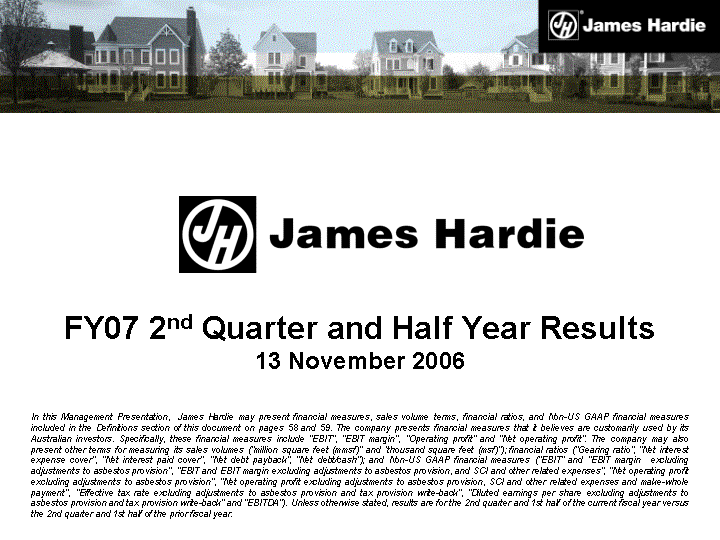
|
FY07 2nd Quarter and Half Year Results
13 November 2006
In this Management Presentation, James Hardie may present financial measures, sales volume terms, financial ratios, and Non-US GAAP financial measures
included in the Definitions section of this document on pages 58 and 59. The company presents financial measures that it believes are customarily used by its
Australian investors. Specifically, these financial measures include "EBIT", "EBIT margin", "Operating profit" and "Net operating profit". The company may also
present other terms for measuring its sales volumes ("million square feet (mmsf)" and "thousand square feet (msf)"); financial ratios ("Gearing ratio", "Net interest
expense cover", "Net interest paid cover", "Net debt payback", "Net debt/cash"); and Non-US GAAP financial measures ("EBIT" and "EBIT margin excluding
adjustments to asbestos provision", "EBIT and EBIT margin excluding adjustments to asbestos provision, and SCI and other related expenses", "Net operating profit
excluding adjustments to asbestos provision", "Net operating profit excluding adjustments to asbestos provision, SCI and other related expenses and make-whole
payment", "Effective tax rate excluding adjustments to asbestos provision and tax provision write-back", "Diluted earnings per share excluding adjustments to
asbestos provision and tax provision write-back" and "EBITDA"). Unless otherwise stated, results are for the 2nd quarter and 1st half of the current fiscal year versus
the 2nd quarter and 1st half of the prior fiscal year.
|
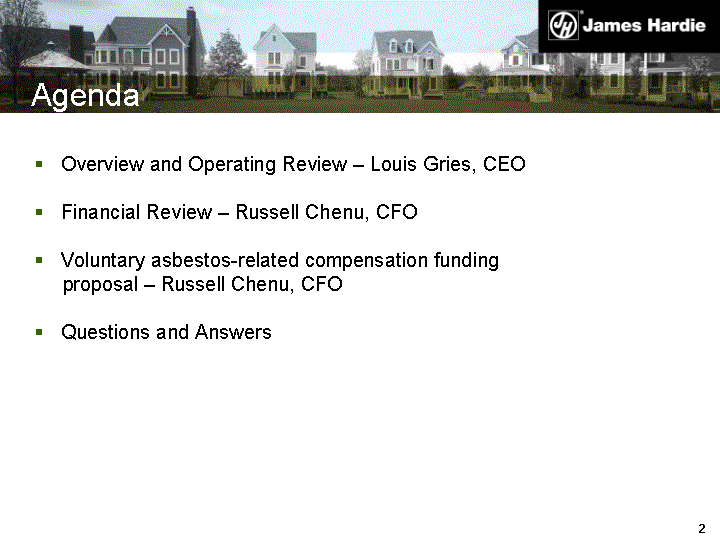
|
Overview and Operating Review - Louis Gries, CEO
Financial Review - Russell Chenu, CFO
Voluntary asbestos-related compensation funding
proposal - Russell Chenu, CFO
Questions and Answers
Agenda
|
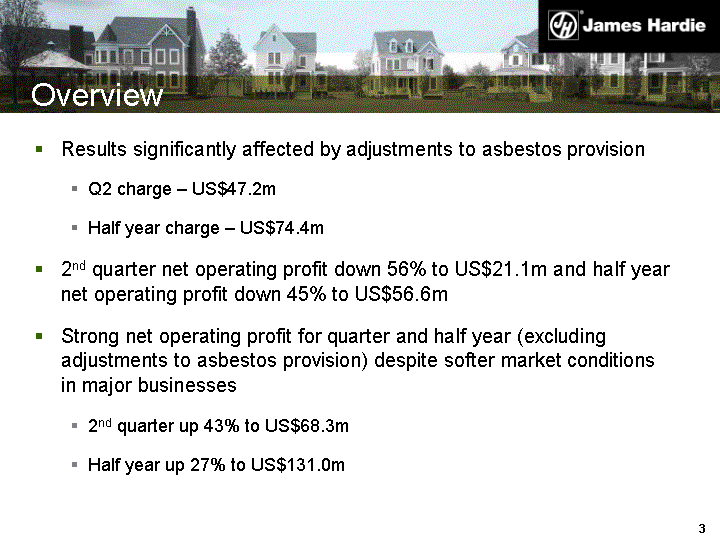
|
Overview
Results significantly affected by adjustments to asbestos provision
Q2 charge - US$47.2m
Half year charge - US$74.4m
2nd quarter net operating profit down 56% to US$21.1m and half year
net operating profit down 45% to US$56.6m
Strong net operating profit for quarter and half year (excluding
adjustments to asbestos provision) despite softer market conditions
in major businesses
2nd quarter up 43% to US$68.3m
Half year up 27% to US$131.0m
|
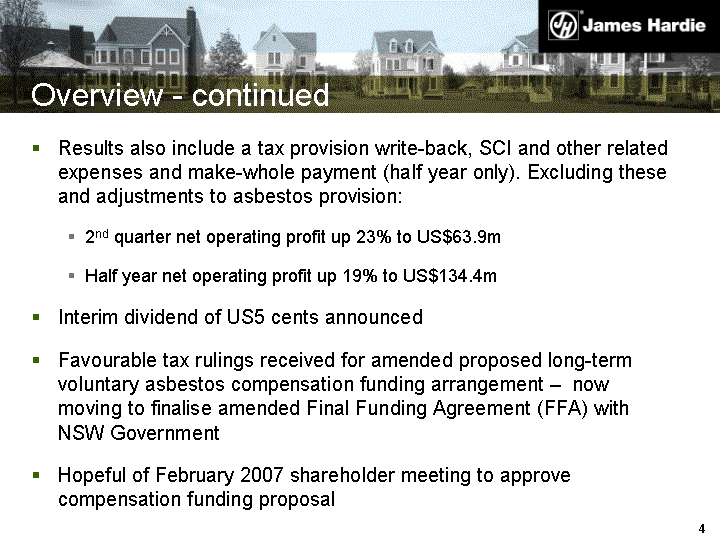
|
Overview - continued
Results also include a tax provision write-back, SCI and other related
expenses and make-whole payment (half year only). Excluding these
and adjustments to asbestos provision:
2nd quarter net operating profit up 23% to US$63.9m
Half year net operating profit up 19% to US$134.4m
Interim dividend of US5 cents announced
Favourable tax rulings received for amended proposed long-term
voluntary asbestos compensation funding arrangement - now
moving to finalise amended Final Funding Agreement (FFA) with
NSW Government
Hopeful of February 2007 shareholder meeting to approve
compensation funding proposal
|
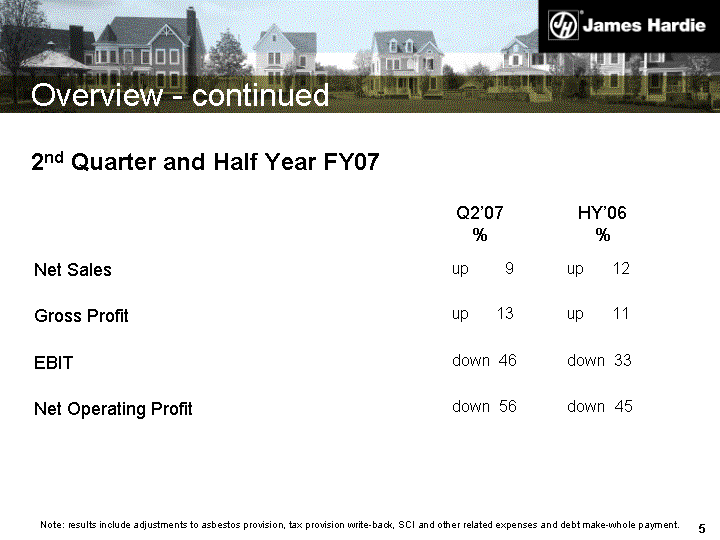
|
Overview - continued
2nd Quarter and Half Year FY07
Q2'07
% HY'06
%
Net Sales
up 9 up 12
Gross Profit up 13 up 11
EBIT down 46 down 33
Net Operating Profit down 56 down 45
Note: results include adjustments to asbestos provision, tax provision write-back, SCI and other related expenses and debt make-whole payment.
|
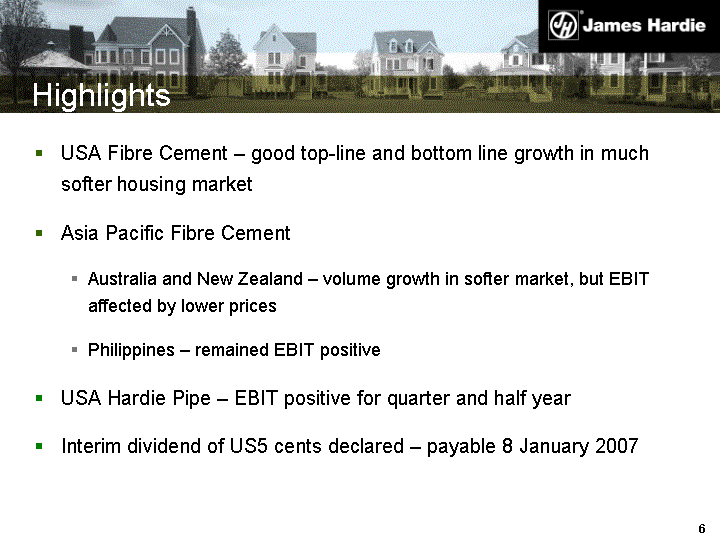
|
Highlights
USA Fibre Cement - good top-line and bottom line growth in much
softer housing market
Asia Pacific Fibre Cement
Australia and New Zealand - volume growth in softer market, but EBIT
affected by lower prices
Philippines - remained EBIT positive
USA Hardie Pipe - EBIT positive for quarter and half year
Interim dividend of US5 cents declared - payable 8 January 2007
|
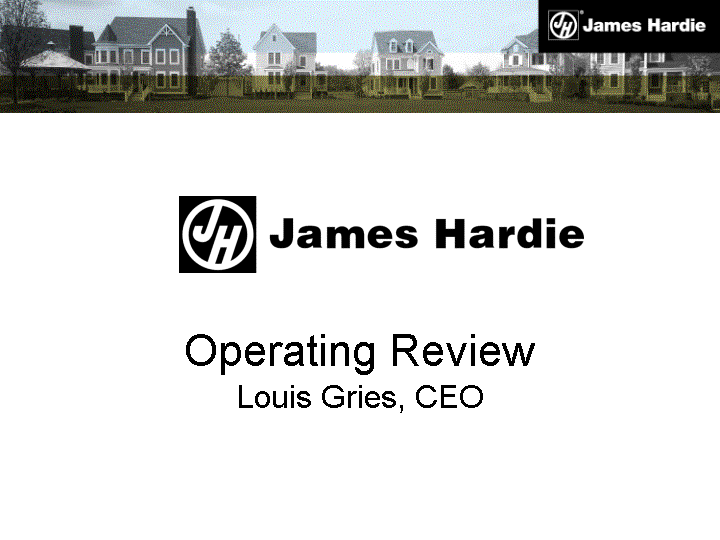
|
Operating Review
Louis Gries, CEO
|
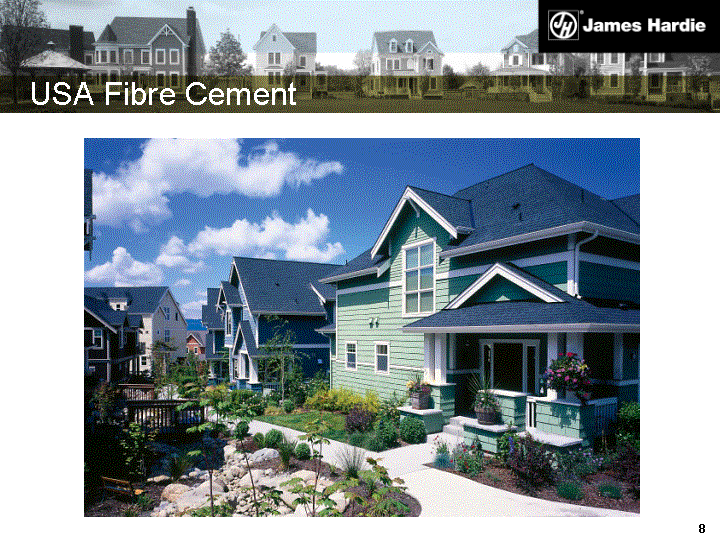
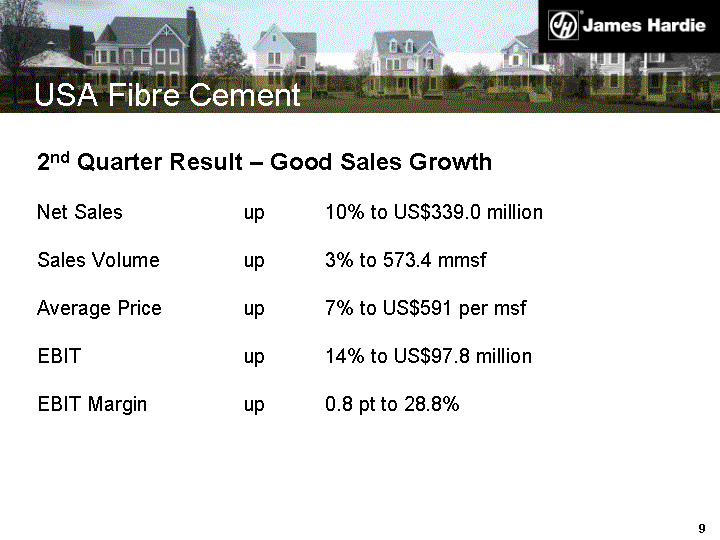
|
2nd Quarter Result - Good Sales Growth
Net Sales up 10% to US$339.0 million
Sales Volume up 3% to 573.4 mmsf
Average Price up 7% to US$591 per msf
EBIT up 14% to US$97.8 million
EBIT Margin up 0.8 pt to 28.8%
USA Fibre Cement
|
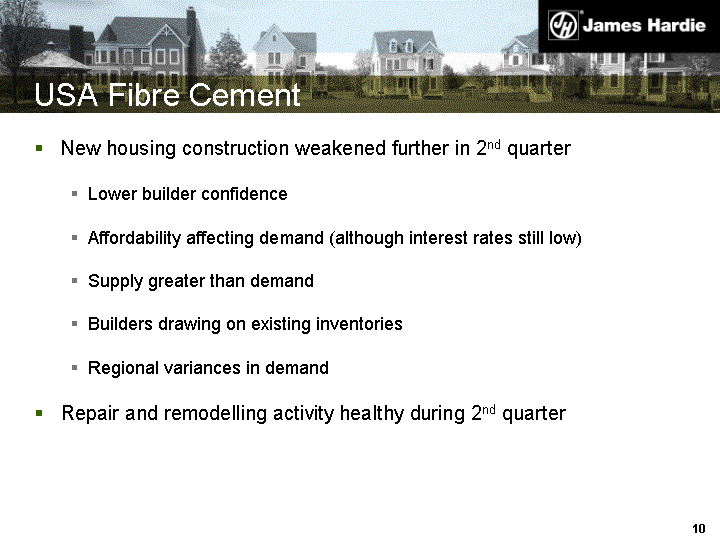
|
USA Fibre Cement
New housing construction weakened further in 2nd quarter
Lower builder confidence
Affordability affecting demand (although interest rates still low)
Supply greater than demand
Builders drawing on existing inventories
Regional variances in demand
Repair and remodelling activity healthy during 2nd quarter
|
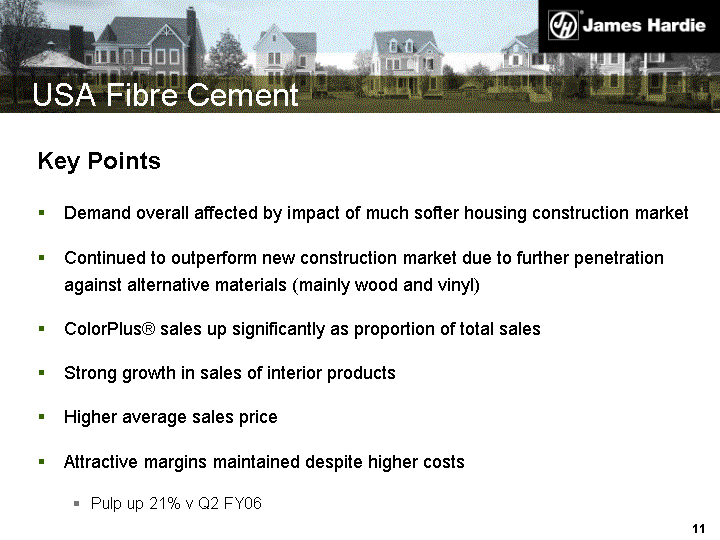
|
USA Fibre Cement
Key Points
Demand overall affected by impact of much softer housing construction market
Continued to outperform new construction market due to further penetration
against alternative materials (mainly wood and vinyl)
ColorPlus(r) sales up significantly as proportion of total sales
Strong growth in sales of interior products
Higher average sales price
Attractive margins maintained despite higher costs
Pulp up 21% v Q2 FY06
|
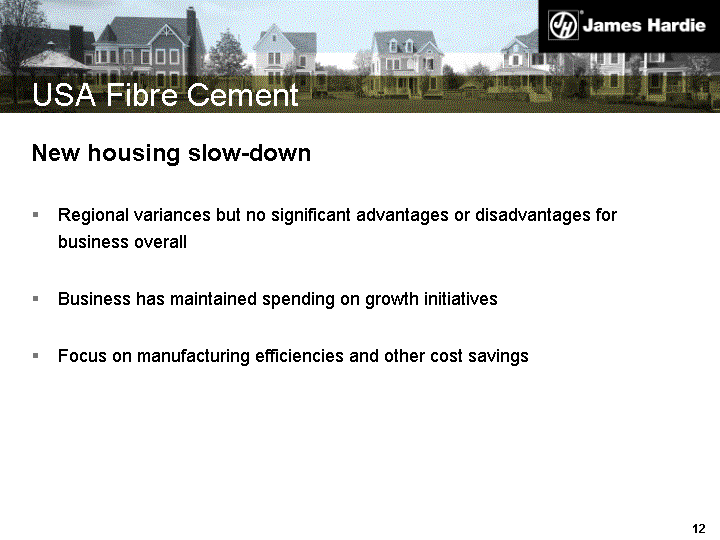
|
USA Fibre Cement
New housing slow-down
Regional variances but no significant advantages or disadvantages for
business overall
Business has maintained spending on growth initiatives
Focus on manufacturing efficiencies and other cost savings
|
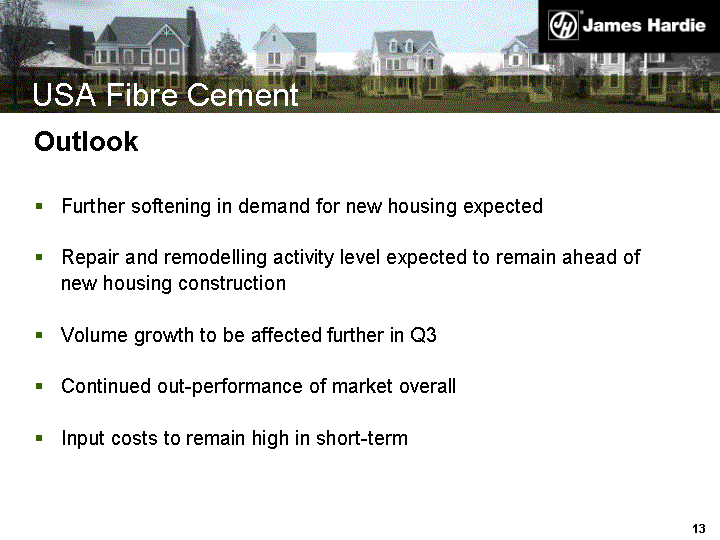
|
USA Fibre Cement
Outlook
Further softening in demand for new housing expected
Repair and remodelling activity level expected to remain ahead of
new housing construction
Volume growth to be affected further in Q3
Continued out-performance of market overall
Input costs to remain high in short-term
|
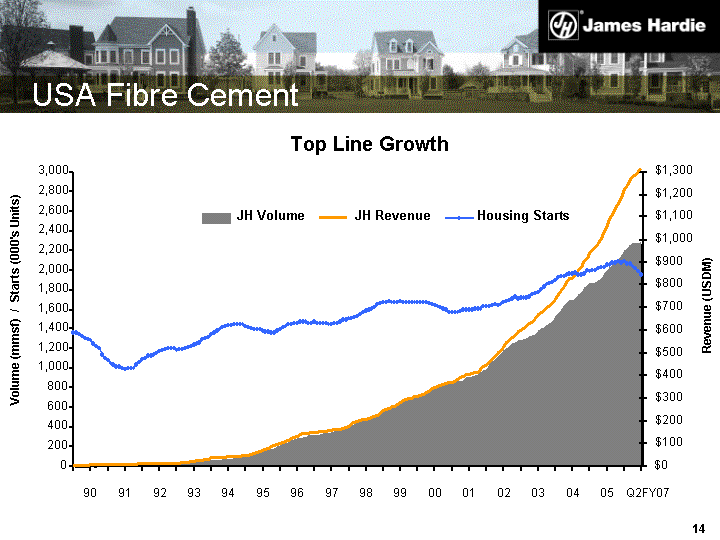
|
USA Fibre Cement
Top Line Growth
0
200
400
600
800
1,000
1,200
1,400
1,600
1,800
2,000
2,200
2,400
2,600
2,800
3,000
90
91
92
93
94
95
96
97
98
99
00
01
02
03
04
05
Q2FY07
Volume (mmsf) / Starts (000's Units)
$0
$100
$200
$300
$400
$500
$600
$700
$800
$900
$1,000
$1,100
$1,200
$1,300
Revenue (USDM)
JH Volume
JH Revenue
Housing Starts
|
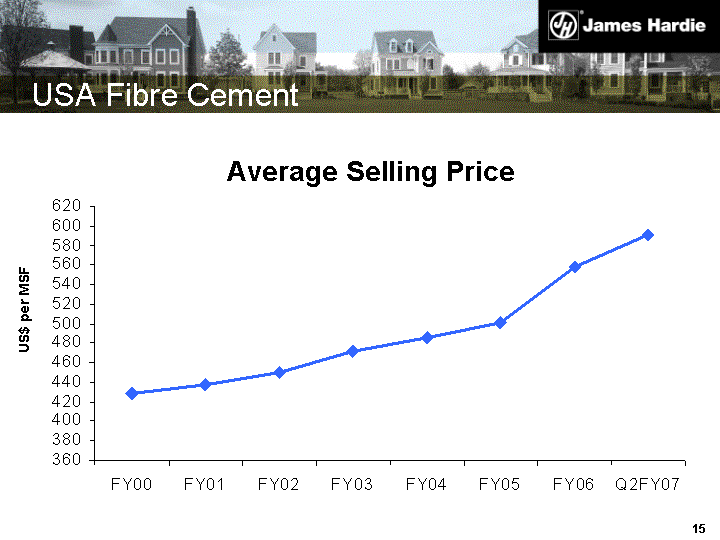
|
USA Fibre Cement
Average Selling Price
US$ per MSF
|
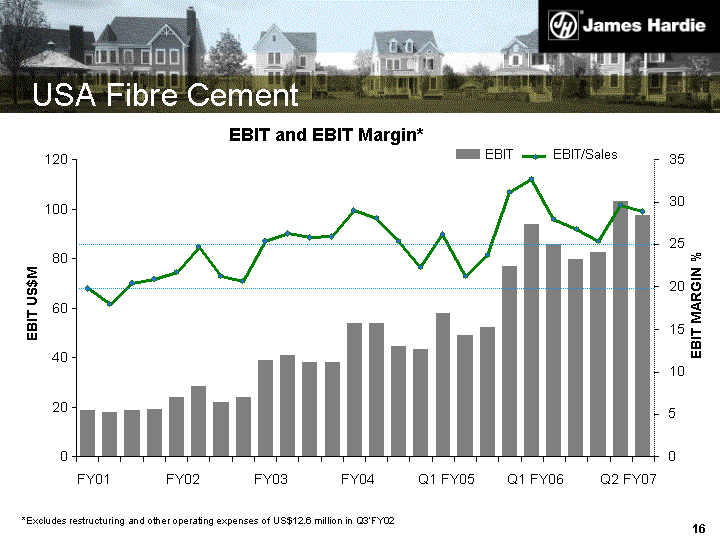
|
USA Fibre Cement
*Excludes restructuring and other operating expenses of US$12.6 million in Q3'FY02
EBIT and EBIT Margin*
0
20
40
60
80
100
120
FY01
FY02
FY03
FY04
Q1 FY05
Q1 FY06
Q2 FY07
EBIT US$M
0
5
10
15
20
25
30
35
EBIT MARGIN %
EBIT
EBIT/Sales
|
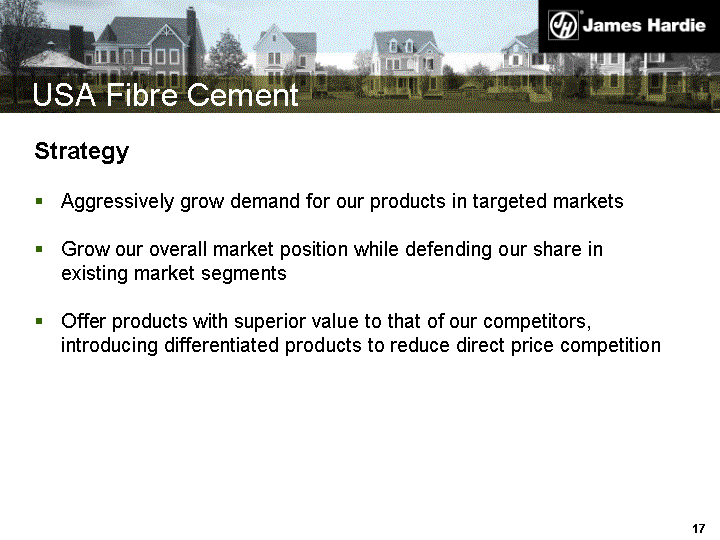
|
USA Fibre Cement
Strategy
Aggressively grow demand for our products in targeted markets
Grow our overall market position while defending our share in
existing market segments
Offer products with superior value to that of our competitors,
introducing differentiated products to reduce direct price competition
|
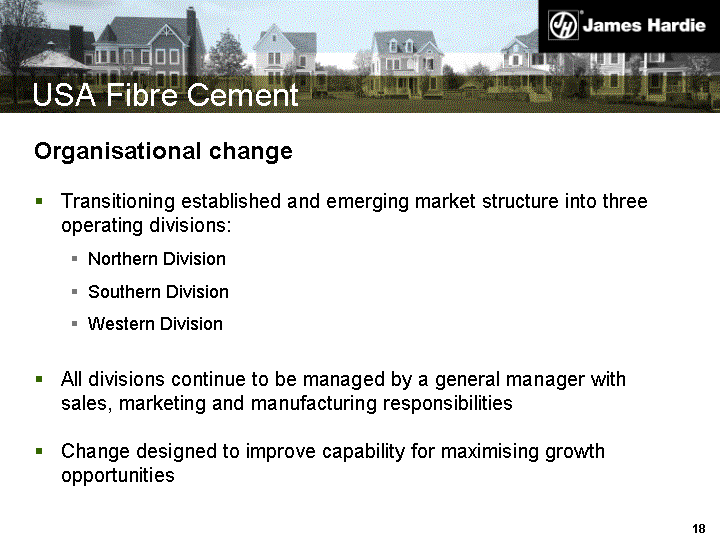
|
USA Fibre Cement
Organisational change
Transitioning established and emerging market structure into three
operating divisions:
Northern Division
Southern Division
Western Division
All divisions continue to be managed by a general manager with
sales, marketing and manufacturing responsibilities
Change designed to improve capability for maximising growth
opportunities
|
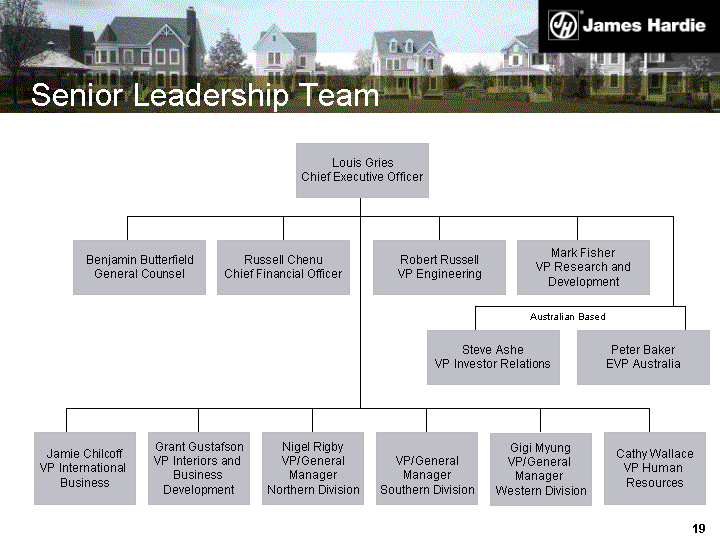
|
Senior Leadership Team
Louis Gries
Chief Executive Officer
Robert Russell
VP Engineering
Mark Fisher
VP Research and
Development
Russell Chenu
Chief Financial Officer
Benjamin Butterfield
General Counsel
Peter Baker
EVP Australia
Steve Ashe
VP Investor Relations
Grant Gustafson
VP Interiors and
Business
Development
Australian Based
Nigel Rigby
VP/General
Manager
Northern Division
VP/General
Manager
Southern Division
Gigi Myung
VP/General
Manager
Western Division
Cathy Wallace
VP Human
Resources
Jamie Chilcoff
VP International
Business
|

|
Asia Pacific Fibre Cement
|
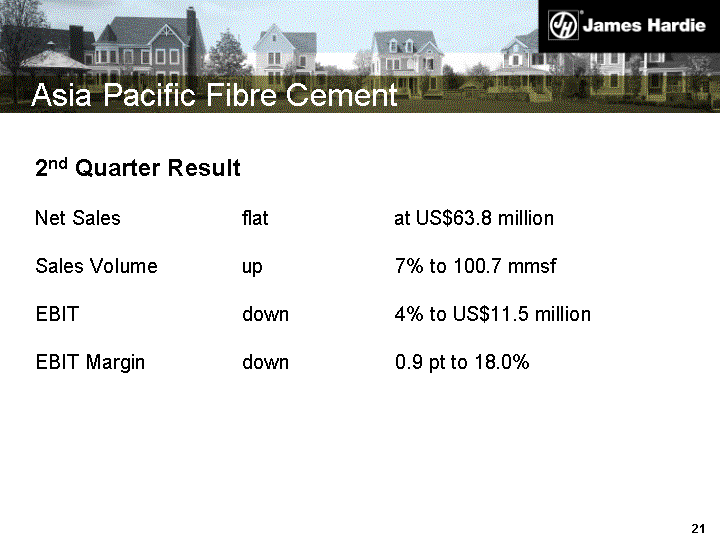
|
Asia Pacific Fibre Cement
2nd Quarter Result
Net Sales flat at US$63.8 million
Sales Volume up 7% to 100.7 mmsf
EBIT down 4% to US$11.5 million
EBIT Margin down 0.9 pt to 18.0%
|
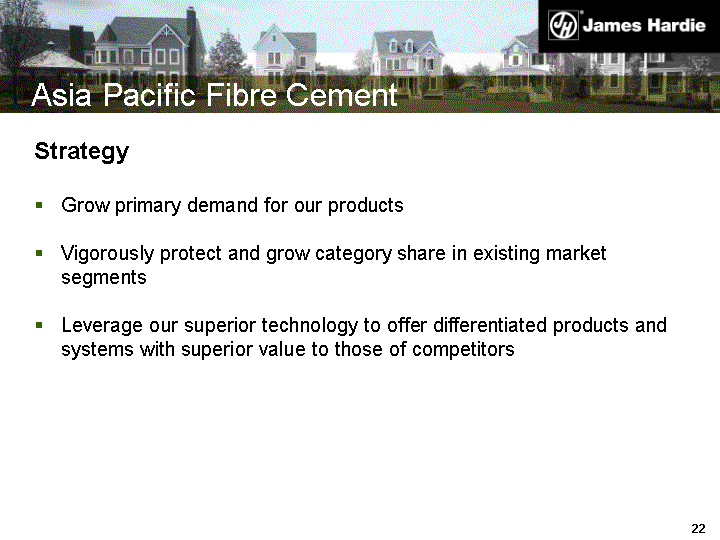
|
Strategy
Grow primary demand for our products
Vigorously protect and grow category share in existing market
segments
Leverage our superior technology to offer differentiated products and
systems with superior value to those of competitors
Asia Pacific Fibre Cement
|

|
Asia Pacific Fibre Cement
Key Points
Weaker new housing and renovations markets in Australia and New
Zealand; Philippines remained weak
Q2 sales volumes up 4% in ANZ
Increasing proportion of value-added, differentiated products in ANZ
sales mix
Commenced launch of Scyon(tm) range of premium products
ANZ EBIT down slightly - lower prices and increased manufacturing
costs, EBIT margin 19.5%
Philippines remained EBIT positive
|
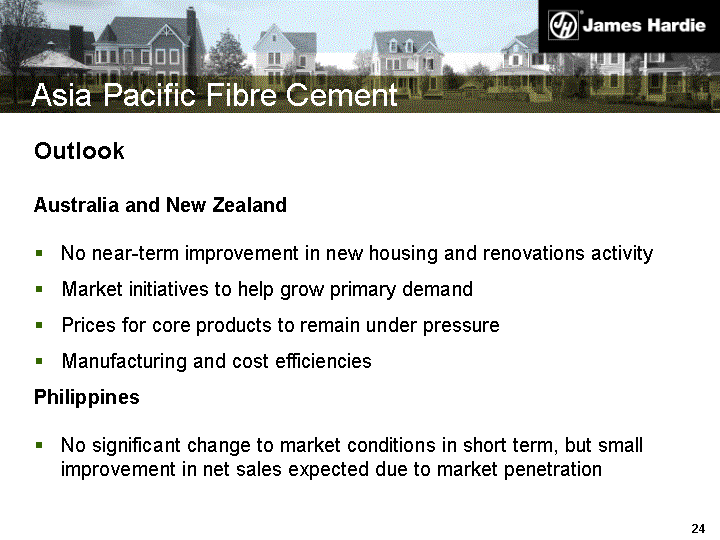
|
Asia Pacific Fibre Cement
Outlook
Australia and New Zealand
No near-term improvement in new housing and renovations activity
Market initiatives to help grow primary demand
Prices for core products to remain under pressure
Manufacturing and cost efficiencies
Philippines
No significant change to market conditions in short term, but small
improvement in net sales expected due to market penetration
|
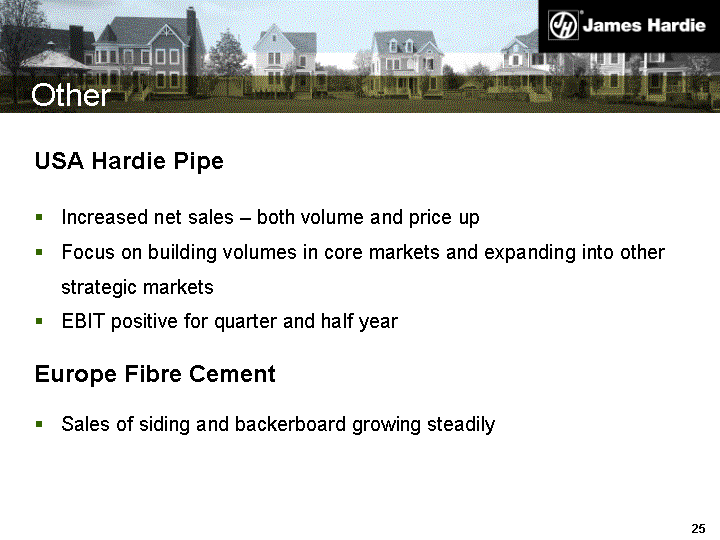
|
Other
USA Hardie Pipe
Increased net sales - both volume and price up
Focus on building volumes in core markets and expanding into other
strategic markets
EBIT positive for quarter and half year
Europe Fibre Cement
Sales of siding and backerboard growing steadily
|
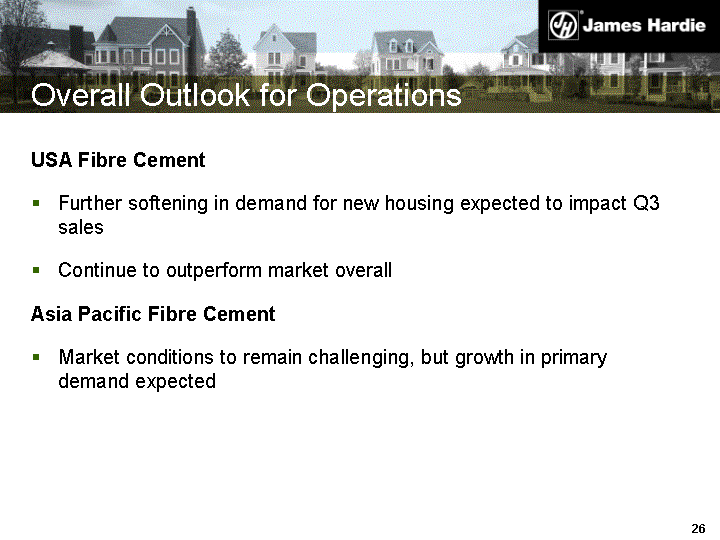
|
Overall Outlook for Operations
USA Fibre Cement
Further softening in demand for new housing expected to impact Q3
sales
Continue to outperform market overall
Asia Pacific Fibre Cement
Market conditions to remain challenging, but growth in primary
demand expected
|
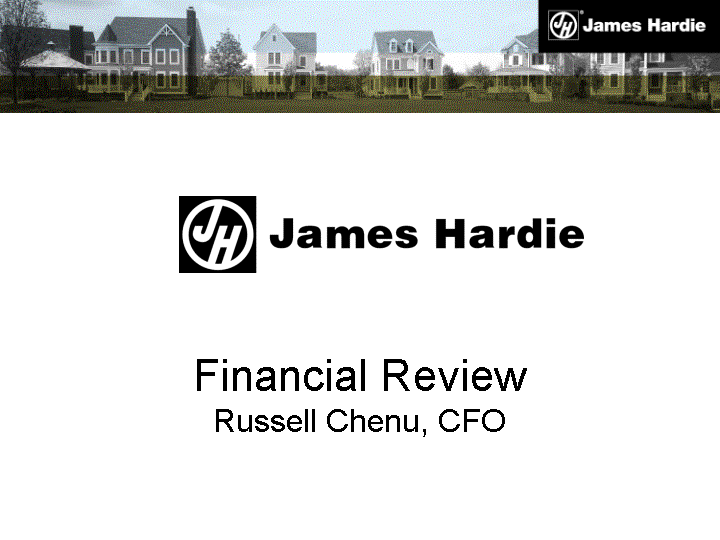
|
Financial Review
Russell Chenu, CFO
|

|
Overview
Results significantly affected by charges resulting from adjustments
to asbestos provision. These are:
Due to impact of foreign currency movements on A$ denominated
asbestos liability:
Q2 - US$5.4m
Half year - US$32.6m
Due to changes in KPMG Actuaries' actuarial assessment at
30 September 2006
US$41.8m charge
|
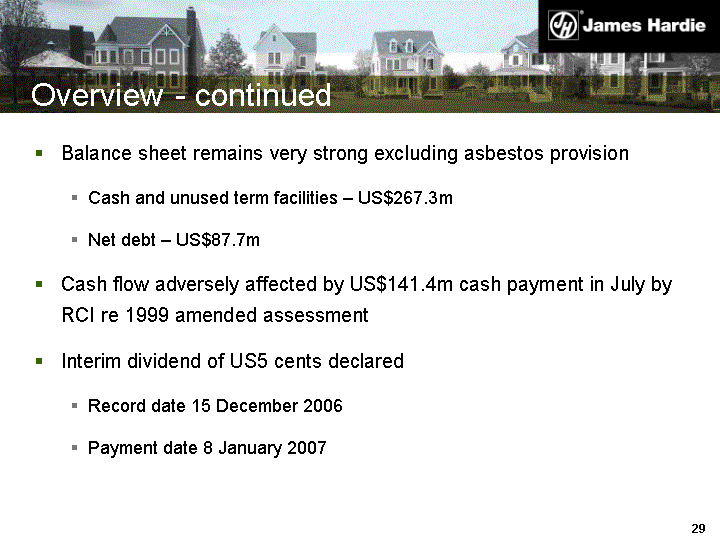
|
Overview - continued
Balance sheet remains very strong excluding asbestos provision
Cash and unused term facilities - US$267.3m
Net debt - US$87.7m
Cash flow adversely affected by US$141.4m cash payment in July by
RCI re 1999 amended assessment
Interim dividend of US5 cents declared
Record date 15 December 2006
Payment date 8 January 2007
|
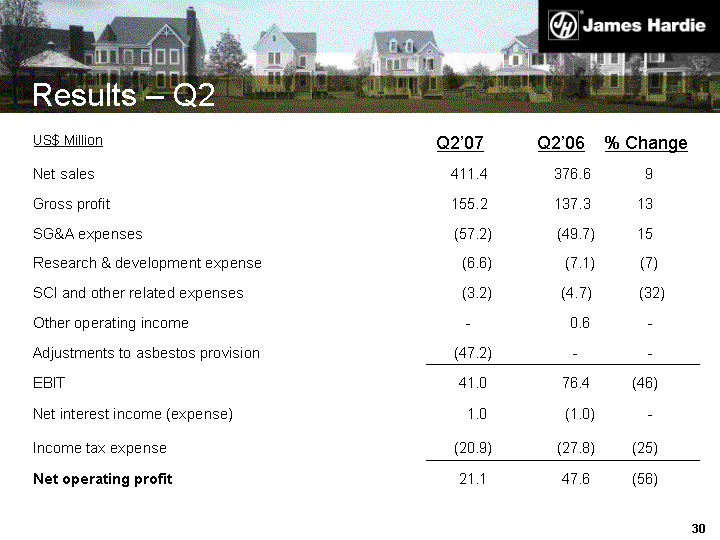
|
US$ Million
Q2'07
Q2'06
% Change
Net sales 411.4 376.6 9
Gross profit 155.2 137.3 13
SG&A expenses (57.2) (49.7) 15
Research & development expense (6.6) (7.1) (7)
SCI and other related expenses (3.2) (4.7) (32)
Other operating income - 0.6 -
Adjustments to asbestos provision (47.2) - -
EBIT 41.0 76.4 (46)
Net interest income (expense) 1.0 (1.0) -
Income tax expense (20.9) (27.8) (25)
Net operating profit 21.1 47.6 (56)
Results - Q2
|
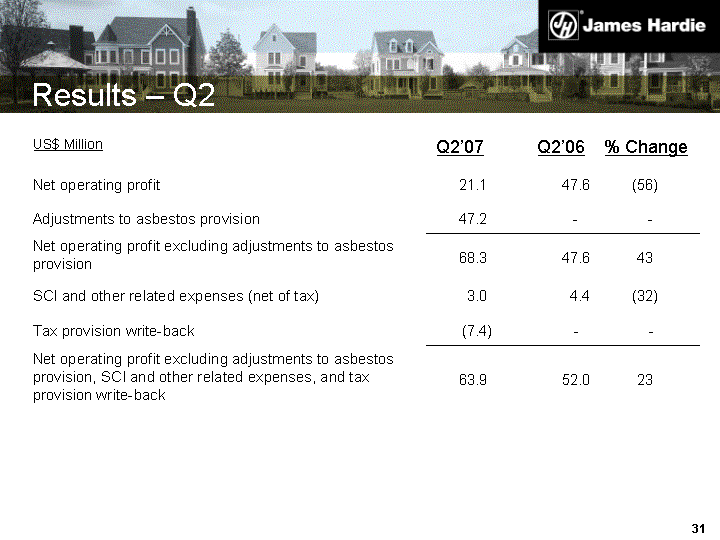
|
US$ Million
Q2'07
Q2'06
% Change
Net operating profit 21.1 47.6 (56)
Adjustments to asbestos provision 47.2 - -
Net operating profit excluding adjustments to asbestos provision 68.3 47.6 43
SCI and other related expenses (net of tax) 3.0 4.4 (32)
Tax provision write-back (7.4) - -
Net operating profit excluding adjustments to asbestos provision, SCI and other related expenses, and tax provision write-back 63.9 52.0 23
Results - Q2
|
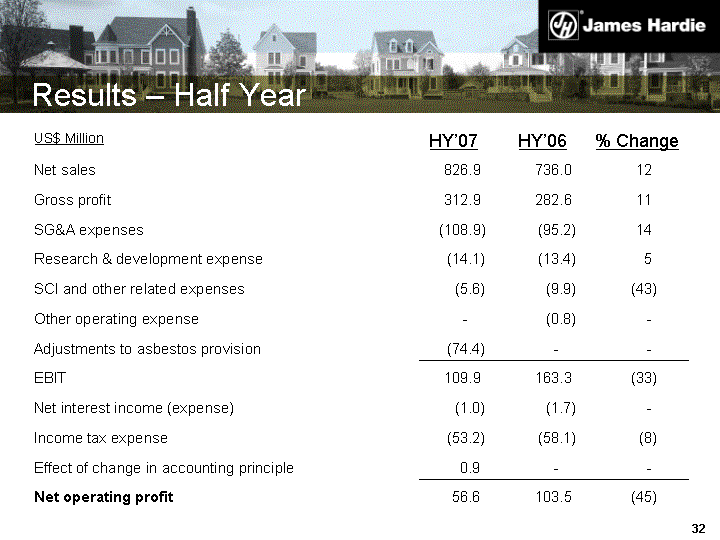
|
Results - Half Year
US$ Million
HY'07
HY'06
% Change
Net sales 826.9 736.0 12
Gross profit 312.9 282.6 11
SG&A expenses (108.9) (95.2) 14
Research & development expense (14.1) (13.4) 5
SCI and other related expenses (5.6) (9.9) (43)
Other operating expense - (0.8) -
Adjustments to asbestos provision (74.4) - -
EBIT 109.9 163.3 (33)
Net interest income (expense) (1.0) (1.7) -
Income tax expense (53.2) (58.1) (8)
Effect of change in accounting principle 0.9 - -
Net operating profit 56.6 103.5 (45)
|
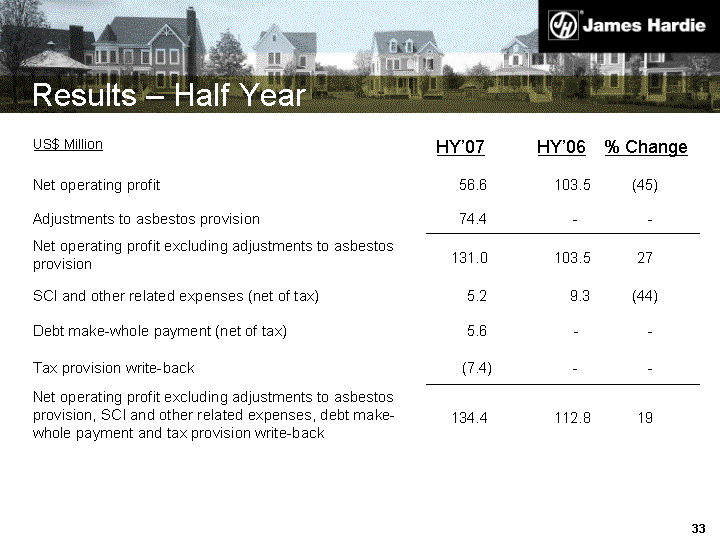
|
US$ Million
HY'07
HY'06
% Change
Net operating profit 56.6 103.5 (45)
Adjustments to asbestos provision 74.4 - -
Net operating profit excluding adjustments to asbestos provision 131.0 103.5 27
SCI and other related expenses (net of tax) 5.2 9.3 (44)
Debt make-whole payment (net of tax) 5.6 - -
Tax provision write-back (7.4) - -
Net operating profit excluding adjustments to asbestos provision, SCI and other related expenses, debt make-whole payment and tax provision write-back 134.4 112.8 19
Results - Half Year
|
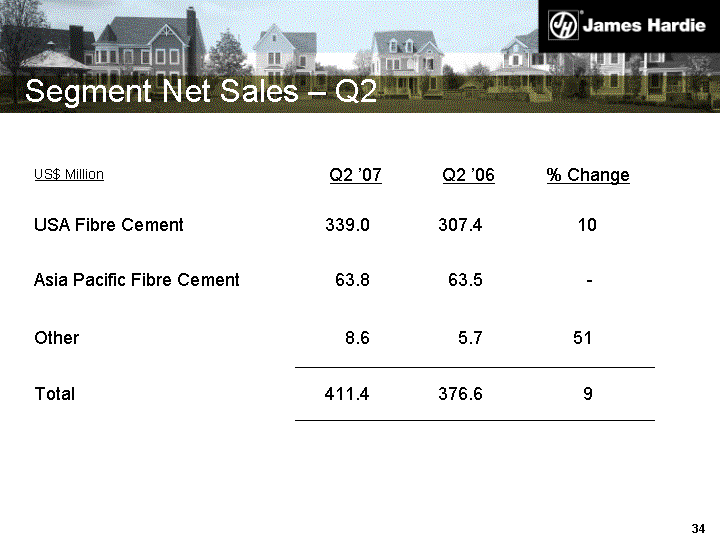
|
Segment Net Sales - Q2
US$ Million Q2 '07 Q2 '06 % Change
USA Fibre Cement 339.0 307.4 10
Asia Pacific Fibre Cement 63.8 63.5 -
Other 8.6 5.7 51
Total 411.4 376.6 9
|
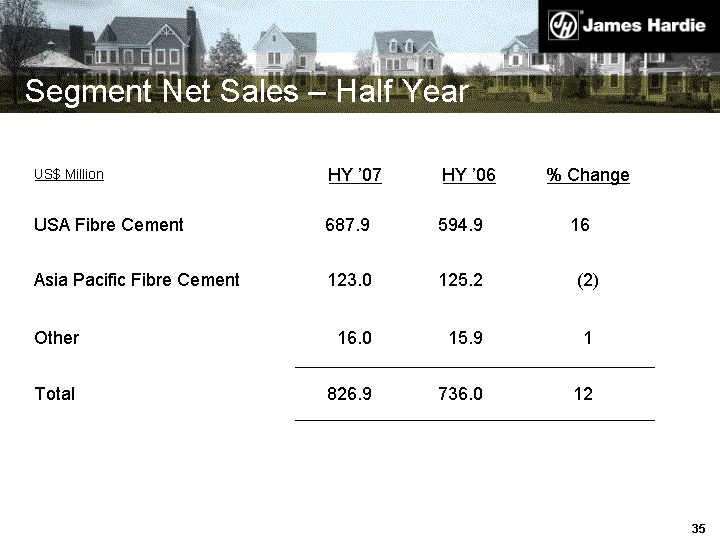
|
Segment Net Sales - Half Year
US$ Million HY '07 HY '06 % Change
USA Fibre Cement 687.9 594.9 16
Asia Pacific Fibre Cement 123.0 125.2 (2)
Other 16.0 15.9 1
Total 826.9 736.0 12
|
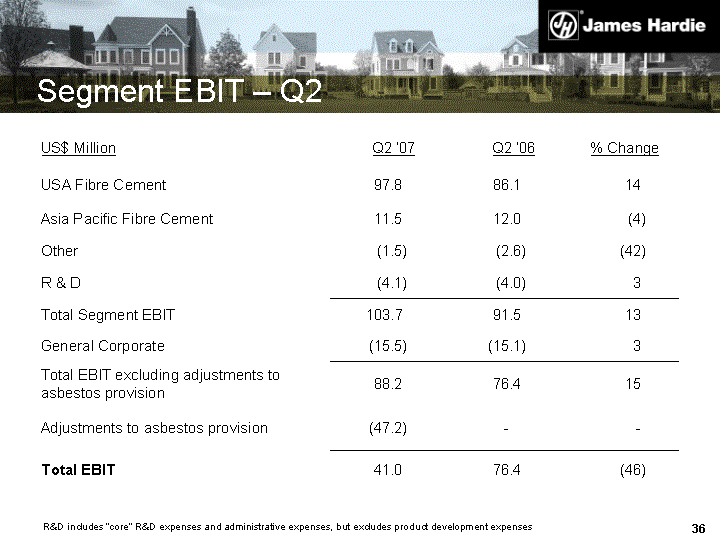
|
Segment EBIT - Q2
US$ Million Q2 '07 Q2 '06 % Change
USA Fibre Cement 97.8 86.1 14
Asia Pacific Fibre Cement 11.5 12.0 (4)
Other (1.5) (2.6) (42)
R & D (4.1) (4.0) 3
Total Segment EBIT 103.7 91.5 13
General Corporate (15.5) (15.1) 3
Total EBIT excluding adjustments to asbestos provision 88.2 76.4 15
Adjustments to asbestos provision (47.2) - -
Total EBIT 41.0 76.4 (46)
R&D includes "core" R&D expenses and administrative expenses, but excludes product development expenses
|
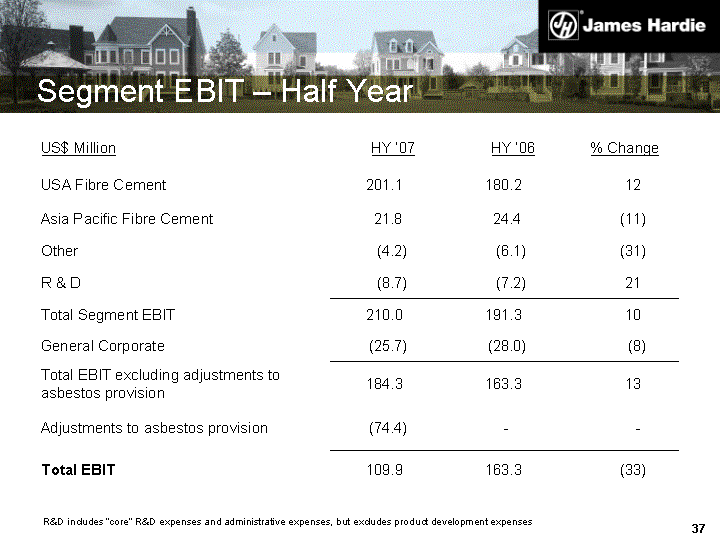
|
Segment EBIT - Half Year
US$ Million HY '07 HY '06 % Change
USA Fibre Cement 201.1 180.2 12
Asia Pacific Fibre Cement 21.8 24.4 (11)
Other (4.2) (6.1) (31)
R & D (8.7) (7.2) 21
Total Segment EBIT 210.0 191.3 10
General Corporate (25.7) (28.0) (8)
Total EBIT excluding adjustments to asbestos provision 184.3 163.3 13
Adjustments to asbestos provision (74.4) - -
Total EBIT 109.9 163.3 (33)
R&D includes "core" R&D expenses and administrative expenses, but excludes product development expenses
|
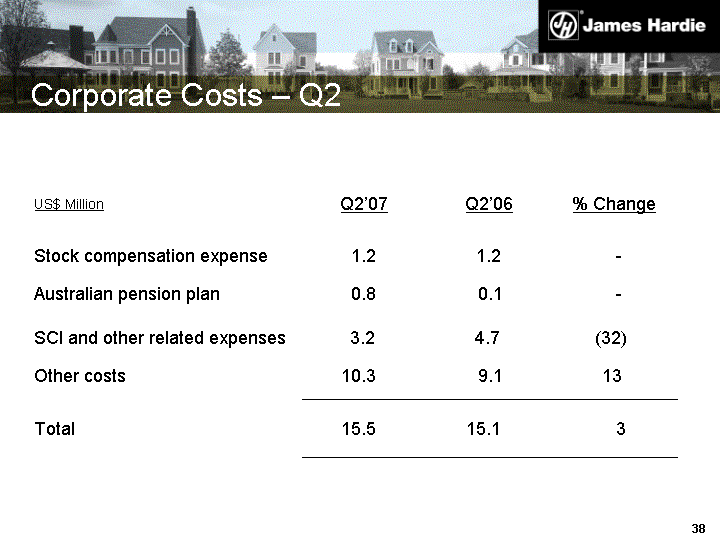
|
Corporate Costs - Q2
US$ Million Q2'07 Q2'06 % Change
Stock compensation expense 1.2 1.2 -
Australian pension plan
SCI and other related expenses 0.8
3.2 0.1
4.7 -
(32)
Other costs 10.3 9.1 13
Total 15.5 15.1 3
|
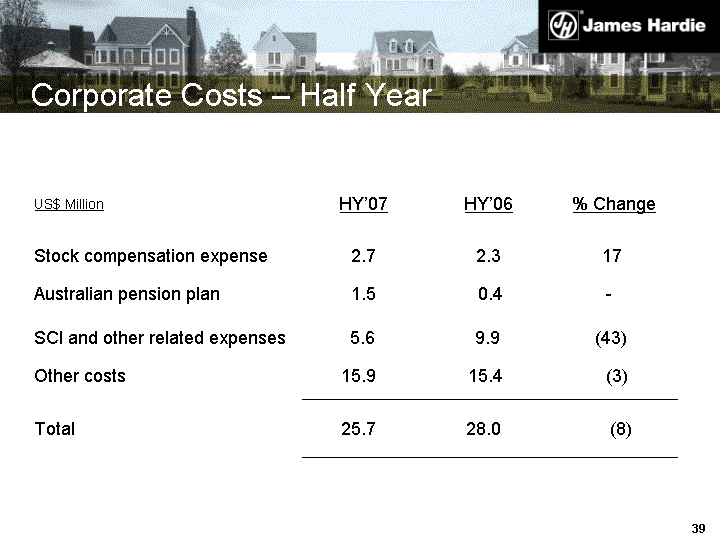
|
Corporate Costs - Half Year
US$ Million HY'07 HY'06 % Change
Stock compensation expense 2.7 2.3 17
Australian pension plan
SCI and other related expenses 1.5
5.6 0.4
9.9 -
(43)
Other costs 15.9 15.4 (3)
Total 25.7 28.0 (8)
|
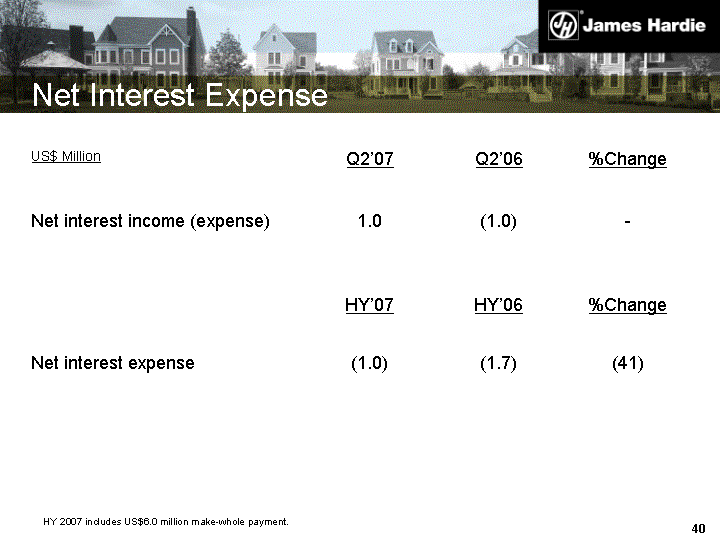
|
Net Interest Expense
US$ Million Q2'07 Q2'06 %Change
Net interest income (expense) 1.0 (1.0) -
HY'07 HY'06 %Change
Net interest expense
(1.0) (1.7) (41)
HY 2007 includes US$6.0 million make-whole payment.
|
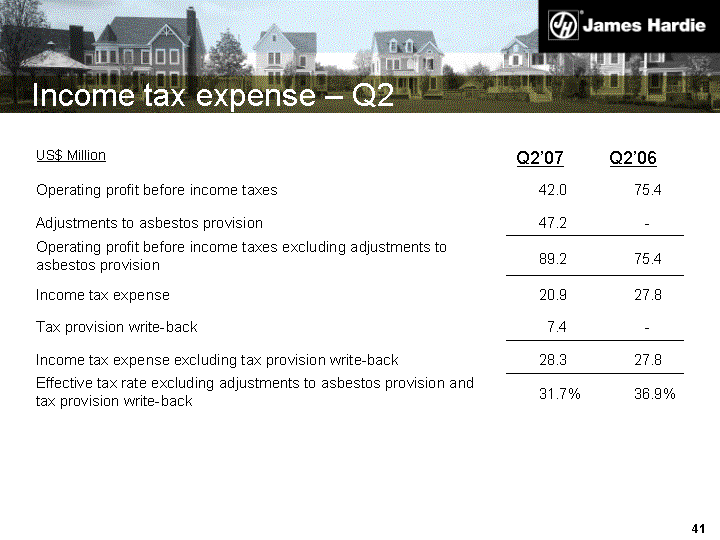
|
Income tax expense - Q2
US$ Million
Q2'07
Q2'06
Operating profit before income taxes 42.0 75.4
Adjustments to asbestos provision 47.2 -
Operating profit before income taxes excluding adjustments to asbestos provision 89.2 75.4
Income tax expense 20.9 27.8
Tax provision write-back 7.4 -
Income tax expense excluding tax provision write-back 28.3 27.8
Effective tax rate excluding adjustments to asbestos provision and
tax provision write-back 31.7% 36.9%
|

|
Income tax expense - Half Year
US$ Million
HY'07
HY'06
Operating profit before income taxes 108.9 161.6
Adjustments to asbestos provision 74.4 -
Operating profit before income taxes excluding adjustments to asbestos provision 183.3 161.6
Income tax expense 53.2 58.1
Tax provision write-back 7.4 -
Income tax expense excluding tax provision write-back 60.6 58.1
Effective tax rate 33.1% 36.0%
|
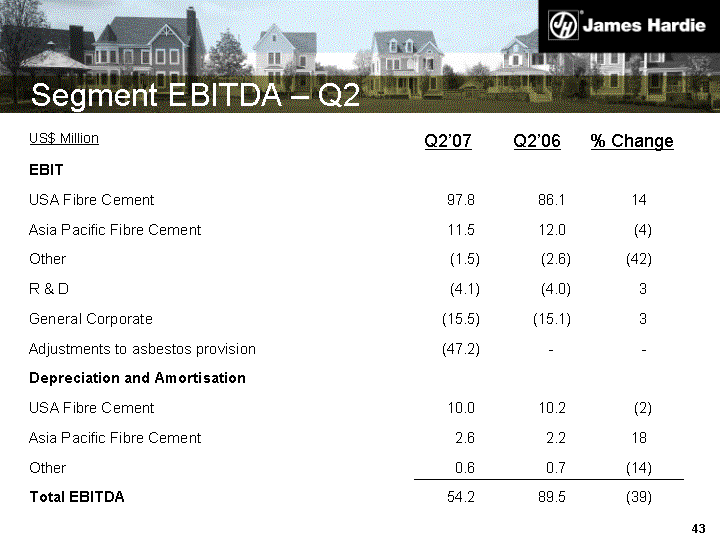
|
Segment EBITDA - Q2
US$ Million
Q2'07
Q2'06
% Change
EBIT
USA Fibre Cement 97.8 86.1 14
Asia Pacific Fibre Cement 11.5 12.0 (4)
Other (1.5) (2.6) (42)
R & D (4.1) (4.0) 3
General Corporate (15.5) (15.1) 3
Adjustments to asbestos provision (47.2) - -
Depreciation and Amortisation
USA Fibre Cement 10.0 10.2 (2)
Asia Pacific Fibre Cement 2.6 2.2 18
Other 0.6 0.7 (14)
Total EBITDA 54.2 89.5 (39)
|
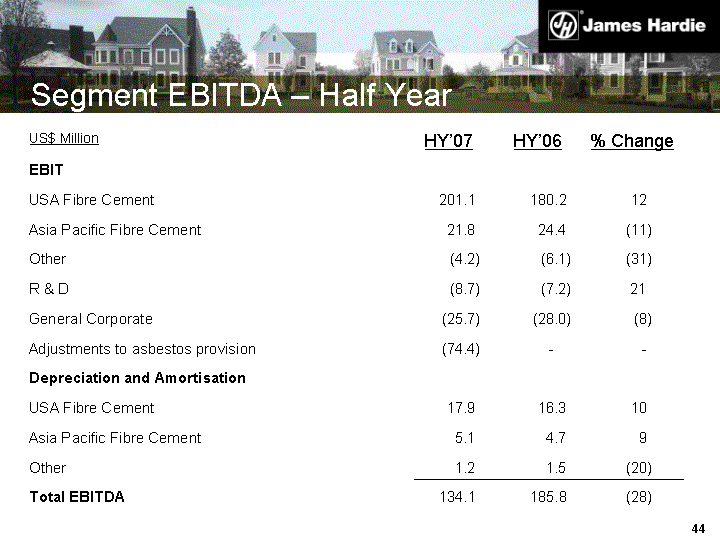
|
Segment EBITDA - Half Year
US$ Million
HY'07
HY'06
% Change
EBIT
USA Fibre Cement 201.1 180.2 12
Asia Pacific Fibre Cement 21.8 24.4 (11)
Other (4.2) (6.1) (31)
R & D (8.7) (7.2) 21
General Corporate (25.7) (28.0) (8)
Adjustments to asbestos provision (74.4) - -
Depreciation and Amortisation
USA Fibre Cement 17.9 16.3 10
Asia Pacific Fibre Cement 5.1 4.7 9
Other 1.2 1.5 (20)
Total EBITDA 134.1 185.8 (28)
|
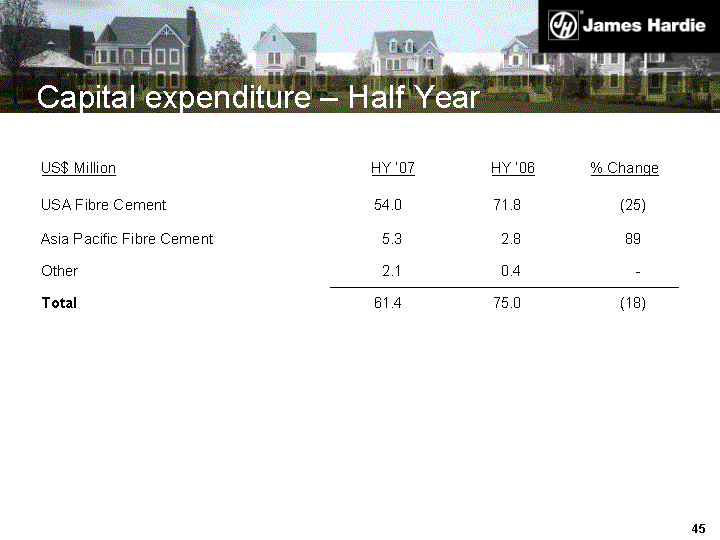
|
Capital expenditure - Half Year
US$ Million HY '07 HY '06 % Change
USA Fibre Cement 54.0 71.8 (25)
Asia Pacific Fibre Cement 5.3 2.8 89
Other 2.1 0.4 -
Total 61.4 75.0 (18)
|

|
Key Ratios
HY'07 FY'06 FY '05 FY04
EPS (Diluted)3 26.5c 44.9c 27.7c 27.2c
Dividend Paid per share 4.0c 10.0c 3.0c 5.0c
Return on Shareholders' Funds1,2 28.8% 29.6% 22.4% 27.6%
Return on Capital Employed2 32.2% 32.1% 23.6% 23.4%
EBIT/ Sales (EBIT margin) 22.3% 20.9% 16.2% 17.5%
Gearing Ratio 38.4% (1.6)% 6.8% 17.0%
Net Interest Expense Cover3 184.3x - 38.5x 17.2x
Net Interest Paid Cover 21.5x 89.0x 17.8x 14.8x
Net Debt Payback 8.8mths - 2.5 mths 0.6 years
1 Total company
2 Annualised
3 Excluding adjustments to asbestos provision, SCI and other related expenses and tax provision write-back
|
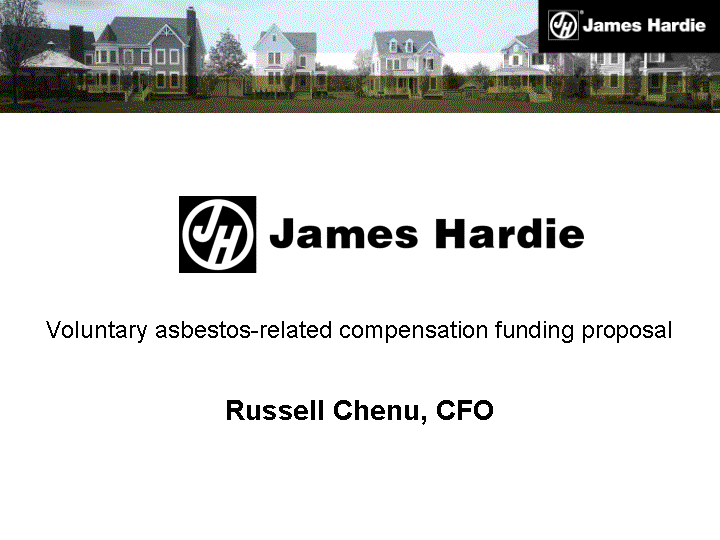
|
Voluntary asbestos-related compensation funding proposal
Russell Chenu, CFO
|

|
Voluntary Asbestos Compensation Funding Proposal
Update
Submitted private ruling applications to Australian Taxation Office (ATO) August
through October on amendments made to funding proposal in response to previous
adverse ruling on tax exempt status of proposed Special Purpose Fund
Amendments and intended tax outcome consistent with principles in Heads of
Agreement, and Final Funding Agreement signed 1 December 2005
Announced receipt of favourable taxation rulings from ATO on amended funding
proposal 9 November 2006
ATO rulings provide tax outcome for proposed Special Purpose Fund acceptable to
JHI NV
|
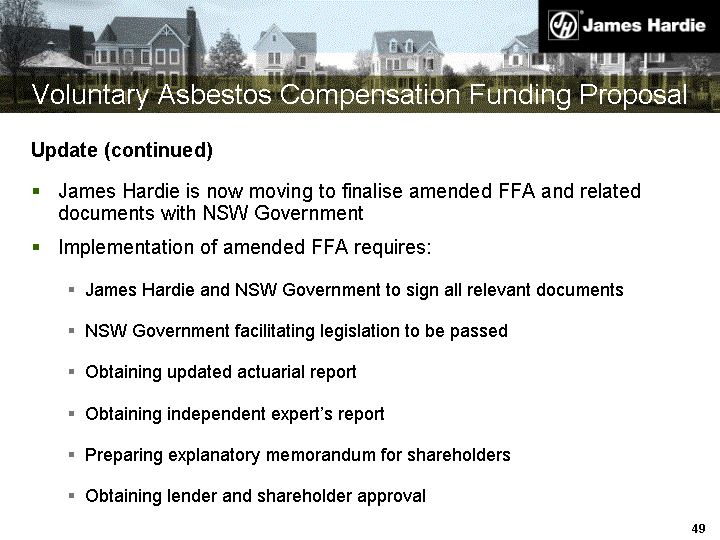
|
Voluntary Asbestos Compensation Funding Proposal
Update (continued)
James Hardie is now moving to finalise amended FFA and related
documents with NSW Government
Implementation of amended FFA requires:
James Hardie and NSW Government to sign all relevant documents
NSW Government facilitating legislation to be passed
Obtaining updated actuarial report
Obtaining independent expert's report
Preparing explanatory memorandum for shareholders
Obtaining lender and shareholder approval
|
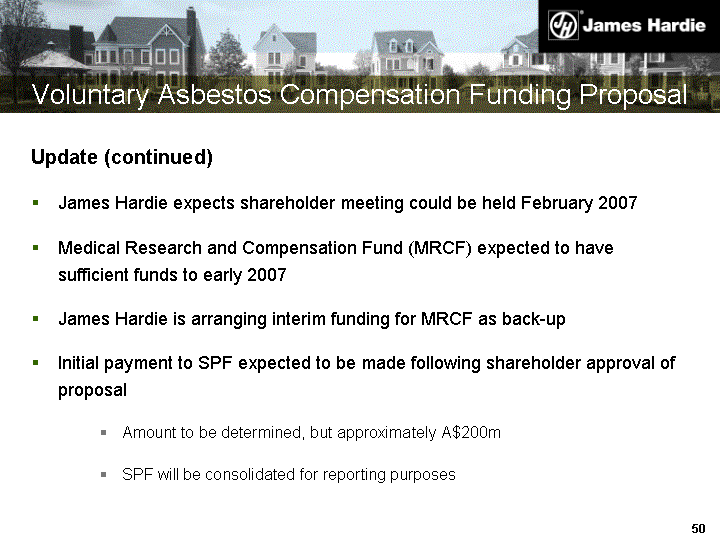
|
Voluntary Asbestos Compensation Funding Proposal
Update (continued)
James Hardie expects shareholder meeting could be held February 2007
Medical Research and Compensation Fund (MRCF) expected to have
sufficient funds to early 2007
James Hardie is arranging interim funding for MRCF as back-up
Initial payment to SPF expected to be made following shareholder approval of
proposal
Amount to be determined, but approximately A$200m
SPF will be consolidated for reporting purposes
|
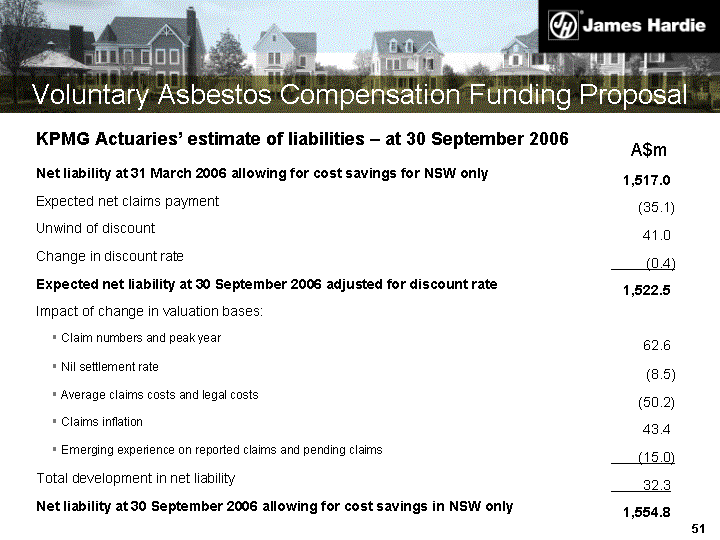
|
Voluntary Asbestos Compensation Funding Proposal
KPMG Actuaries' estimate of liabilities - at 30 September 2006
A$m
Net liability at 31 March 2006 allowing for cost savings for NSW only 1,517.0
Expected net claims payment (35.1)
Unwind of discount 41.0
Change in discount rate (0.4)
Expected net liability at 30 September 2006 adjusted for discount rate 1,522.5
Impact of change in valuation bases:
Claim numbers and peak year 62.6
Nil settlement rate (8.5)
Average claims costs and legal costs (50.2)
Claims inflation 43.4
Emerging experience on reported claims and pending claims (15.0)
Total development in net liability 32.3
Net liability at 30 September 2006 allowing for cost savings in NSW only 1,554.8
|
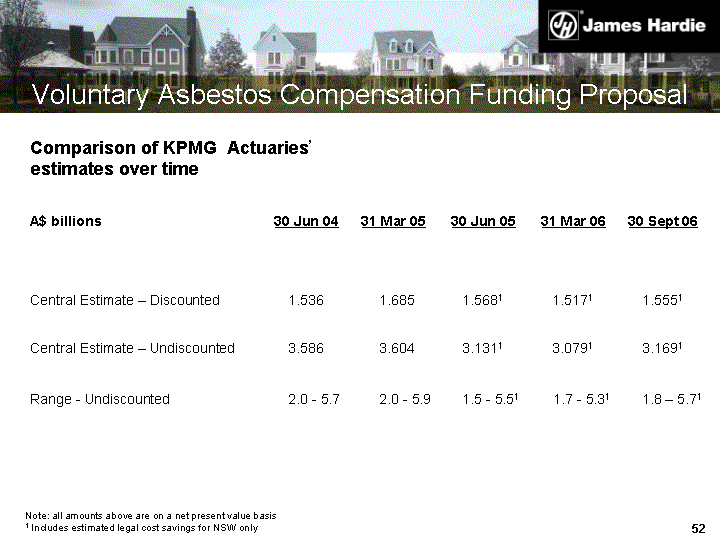
|
Voluntary Asbestos Compensation Funding Proposal
Comparison of KPMG Actuaries' estimates over time Comparison of KPMG Actuaries' estimates over time
A$ billions 30 Jun 04 31 Mar 05 30 Jun 05
31 Mar 06
30 Sept 06
Central Estimate - Discounted
1.536
1.685
1.5681
1.5171
1.5551
Central Estimate - Undiscounted 3.586 3.604 3.1311 3.0791 3.1691
Range - Undiscounted 2.0 - 5.7 2.0 - 5.9 1.5 - 5.51 1.7 - 5.31 1.8 - 5.71
Note: all amounts above are on a net present value basis
1 Includes estimated legal cost savings for NSW only
|
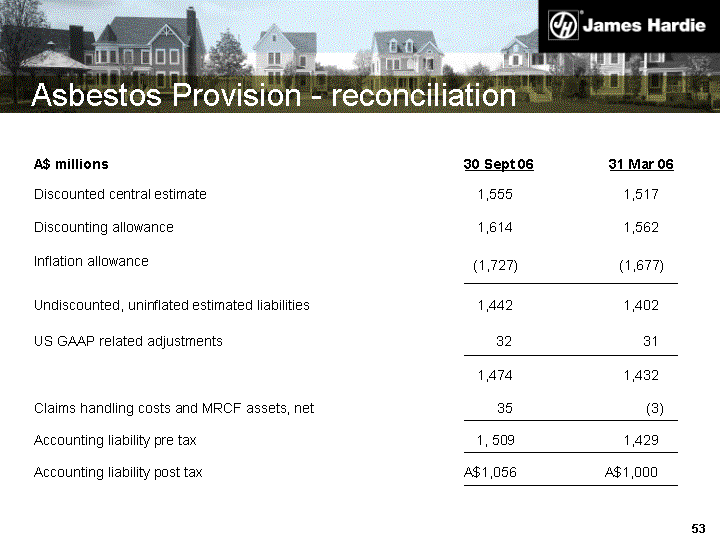
|
Asbestos Provision - reconciliation
A$ millions
30 Sept 06
31 Mar 06
Discounted central estimate 1,555 1,517
Discounting allowance 1,614 1,562
Inflation allowance (1,727) (1,677)
Undiscounted, uninflated estimated liabilities 1,442 1,402
US GAAP related adjustments 32 31
1,474 1,432
Claims handling costs and MRCF assets, net 35 (3)
Accounting liability pre tax 1, 509 1,429
Accounting liability post tax A$1,056 A$1,000
|
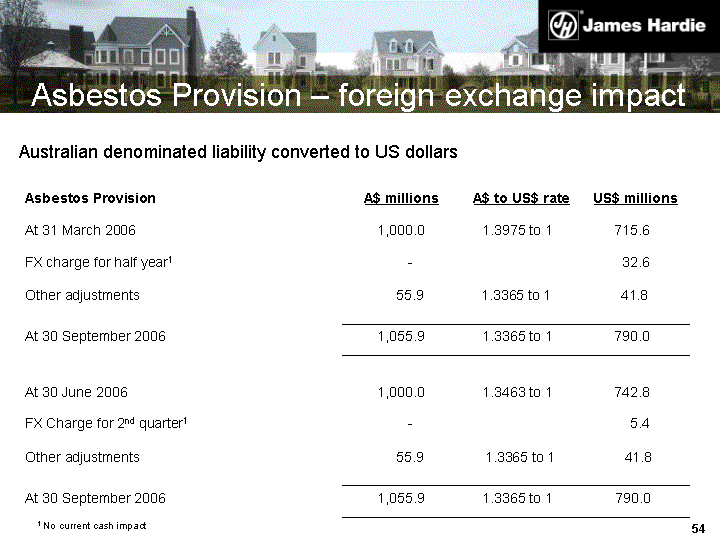
|
Asbestos Provision - foreign exchange impact
Australian denominated liability converted to US dollars
Asbestos Provision A$ millions A$ to US$ rate US$ millions
At 31 March 2006 1,000.0 1.3975 to 1 715.6
FX charge for half year1
Other adjustments
-
55.9
1.3365 to 1 32.6
41.8
At 30 September 2006 1,055.9 1.3365 to 1 790.0
At 30 June 2006 1,000.0 1.3463 to 1 742.8
FX Charge for 2nd quarter1
Other adjustments
-
55.9
1.3365 to 1 5.4
41.8
At 30 September 2006 1,055.9 1.3365 to 1 790.0
1 No current cash impact
|

|
Summary
Strong overall operating performance for quarter and half year despite soft
markets
The company's financial position remains strong
Good progress with voluntary compensation funding proposal - hope to hold
shareholder meeting in February 2007
Results subject to fluctuation in A$ : US$ exchange rate for foreseeable
future
Intend to continue reporting results including and excluding asbestos-related
charges to assist assessment of underlying performance
Expect to move from recording asbestos provision on net of tax basis to
gross basis in Q3. Insurance recoveries and future tax benefit to be
recorded as assets - US GAAP requirement
|

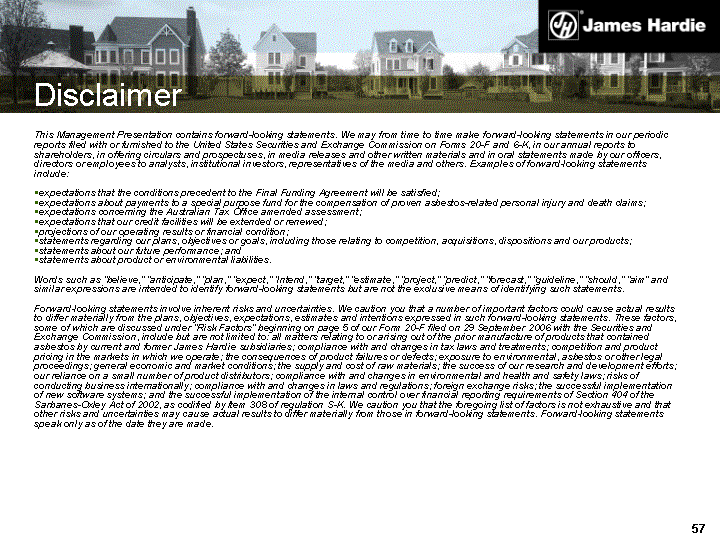
|
Disclaimer
This Management Presentation contains forward-looking statements. We may from time to time make forward-looking statements in our periodic
reports filed with or furnished to the United States Securities and Exchange Commission on Forms 20-F and 6-K, in our annual reports to
shareholders, in offering circulars and prospectuses, in media releases and other written materials and in oral statements made by our officers,
directors or employees to analysts, institutional investors, representatives of the media and others. Examples of forward-looking statements
include:
expectations that the conditions precedent to the Final Funding Agreement will be satisfied;
expectations about payments to a special purpose fund for the compensation of proven asbestos-related personal injury and death claims;
expectations concerning the Australian Tax Office amended assessment;
expectations that our credit facilities will be extended or renewed;
projections of our operating results or financial condition;
statements regarding our plans, objectives or goals, including those relating to competition, acquisitions, dispositions and our products;
statements about our future performance; and
statements about product or environmental liabilities.
Words such as "believe," "anticipate," "plan," "expect," "intend," "target," "estimate," "project," "predict," "forecast," "guideline," "should," "aim" and
similar expressions are intended to identify forward-looking statements but are not the exclusive means of identifying such statements.
Forward-looking statements involve inherent risks and uncertainties. We caution you that a number of important factors could cause actual results
to differ materially from the plans, objectives, expectations, estimates and intentions expressed in such forward-looking statements. These factors,
some of which are discussed under "Risk Factors" beginning on page 5 of our Form 20-F filed on 29 September 2006 with the Securities and
Exchange Commission, include but are not limited to: all matters relating to or arising out of the prior manufacture of products that contained
asbestos by current and former James Hardie subsidiaries; compliance with and changes in tax laws and treatments; competition and product
pricing in the markets in which we operate; the consequences of product failures or defects; exposure to environmental, asbestos or other legal
proceedings; general economic and market conditions; the supply and cost of raw materials; the success of our research and development efforts;
our reliance on a small number of product distributors; compliance with and changes in environmental and health and safety laws; risks of
conducting business internationally; compliance with and changes in laws and regulations; foreign exchange risks; the successful implementation
of new software systems; and the successful implementation of the internal control over financial reporting requirements of Section 404 of the
Sarbanes-Oxley Act of 2002, as codified by Item 308 of regulation S-K. We caution you that the foregoing list of factors is not exhaustive and that
other risks and uncertainties may cause actual results to differ materially from those in forward-looking statements. Forward-looking statements
speak only as of the date they are made.
|
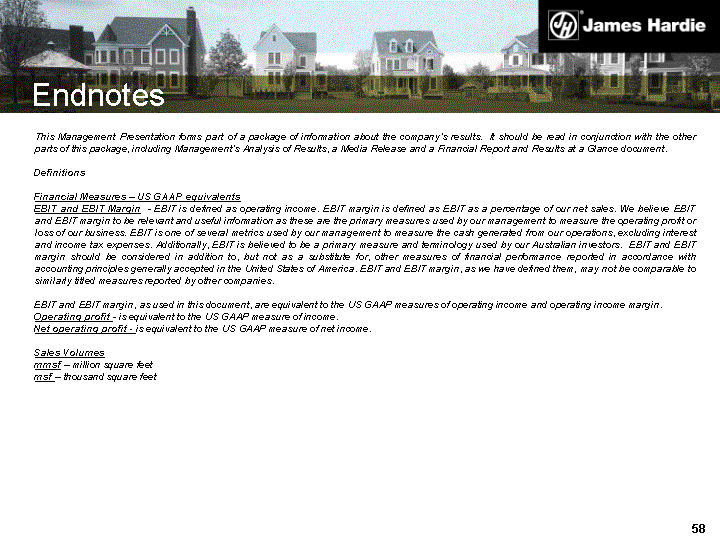
|
Endnotes
This Management Presentation forms part of a package of information about the company's results. It should be read in conjunction with the other
parts of this package, including Management's Analysis of Results, a Media Release and a Financial Report and Results at a Glance document.
Definitions
Financial Measures - US GAAP equivalents
EBIT and EBIT Margin - EBIT is defined as operating income. EBIT margin is defined as EBIT as a percentage of our net sales. We believe EBIT
and EBIT margin to be relevant and useful information as these are the primary measures used by our management to measure the operating profit or
loss of our business. EBIT is one of several metrics used by our management to measure the cash generated from our operations, excluding interest
and income tax expenses. Additionally, EBIT is believed to be a primary measure and terminology used by our Australian investors. EBIT and EBIT
margin should be considered in addition to, but not as a substitute for, other measures of financial performance reported in accordance with
accounting principles generally accepted in the United States of America. EBIT and EBIT margin, as we have defined them, may not be comparable to
similarly titled measures reported by other companies.
EBIT and EBIT margin, as used in this document, are equivalent to the US GAAP measures of operating income and operating income margin.
Operating profit - is equivalent to the US GAAP measure of income.
Net operating profit - is equivalent to the US GAAP measure of net income.
Sales Volumes
mmsf - million square feet
msf - thousand square feet
|
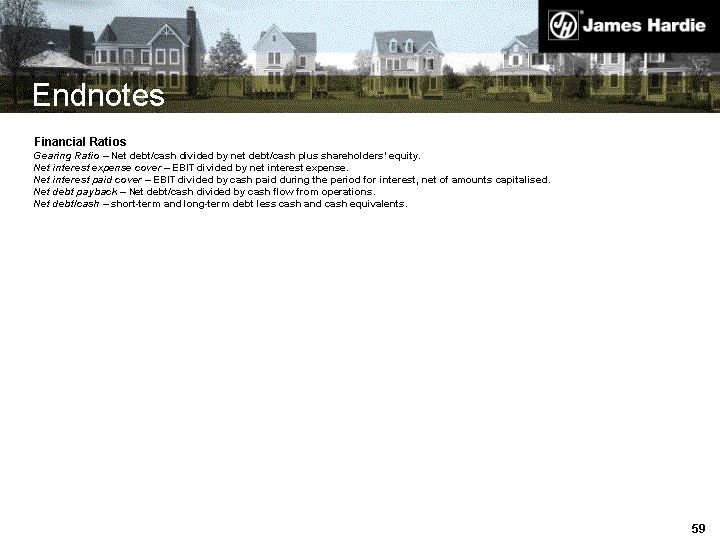
|
Endnotes
Financial Ratios
Gearing Ratio - Net debt/cash divided by net debt/cash plus shareholders' equity.
Net interest expense cover - EBIT divided by net interest expense.
Net interest paid cover - EBIT divided by cash paid during the period for interest, net of amounts capitalised.
Net debt payback - Net debt/cash divided by cash flow from operations.
Net debt/cash - short-term and long-term debt less cash and cash equivalents.
|
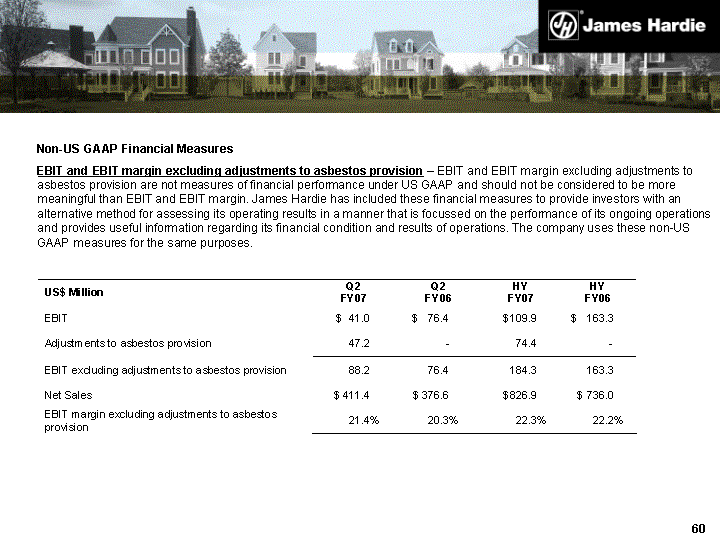
|
Non-US GAAP Financial Measures
EBIT and EBIT margin excluding adjustments to asbestos provision - EBIT and EBIT margin excluding adjustments to
asbestos provision are not measures of financial performance under US GAAP and should not be considered to be more
meaningful than EBIT and EBIT margin. James Hardie has included these financial measures to provide investors with an
alternative method for assessing its operating results in a manner that is focussed on the performance of its ongoing operations
and provides useful information regarding its financial condition and results of operations. The company uses these non-US
GAAP measures for the same purposes.
|
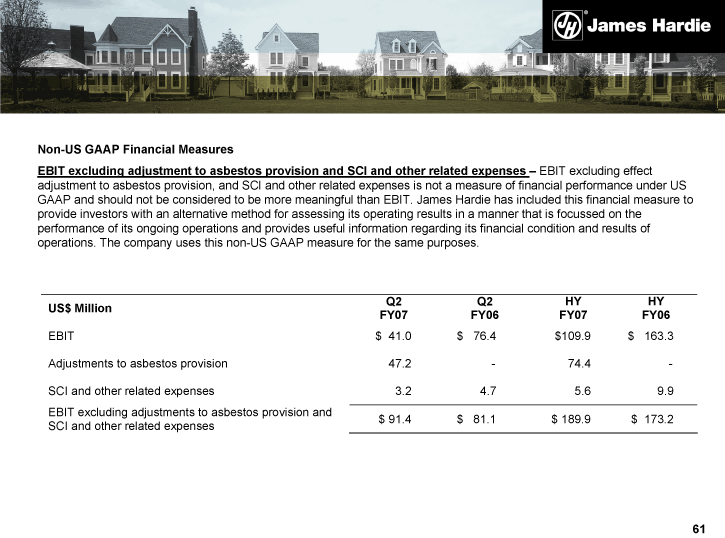
|
Non-US GAAP Financial Measures
EBIT excluding adjustment to asbestos provision and SCI and other related expenses - EBIT excluding effect
adjustment to asbestos provision, and SCI and other related expenses is not a measure of financial performance under US
GAAP and should not be considered to be more meaningful than EBIT. James Hardie has included this financial measure to
provide investors with an alternative method for assessing its operating results in a manner that is focussed on the
performance of its ongoing operations and provides useful information regarding its financial condition and results of
operations. The company uses this non-US GAAP measure for the same purposes.
|

|
Non-US GAAP Financial Measures
Net operating profit excluding adjustments to asbestos provision - Net operating profit excluding effect of foreign
exchange on asbestos provision is not a measure of financial performance under US GAAP and should not be considered
to be more meaningful than net income. The company has included this financial measure to provide investors with an
alternative method for assessing its operating results in a manner that is focussed on the performance of its ongoing
operations. The company uses this non-US GAAP measure for the same purposes.
|
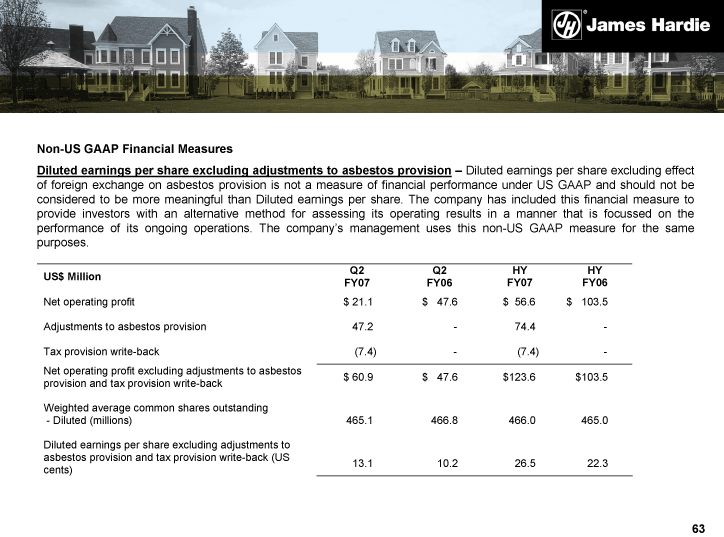
|
Non-US GAAP Financial Measures
Diluted earnings per share excluding adjustments to asbestos provision - Diluted earnings per share excluding effect
of foreign exchange on asbestos provision is not a measure of financial performance under US GAAP and should not be
considered to be more meaningful than Diluted earnings per share. The company has included this financial measure to
provide investors with an alternative method for assessing its operating results in a manner that is focussed on the
performance of its ongoing operations. The company's management uses this non-US GAAP measure for the same
purposes.
|
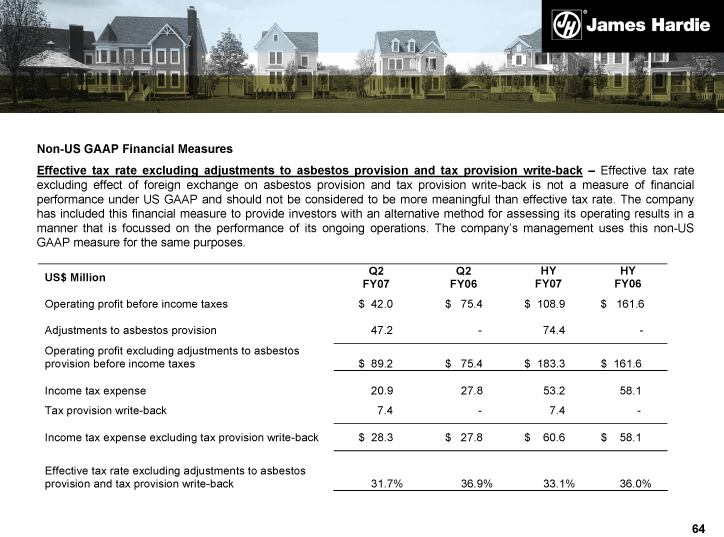
|
Non-US GAAP Financial Measures
Effective tax rate excluding adjustments to asbestos provision and tax provision write-back - Effective tax rate
excluding effect of foreign exchange on asbestos provision and tax provision write-back is not a measure of financial
performance under US GAAP and should not be considered to be more meaningful than effective tax rate. The company
has included this financial measure to provide investors with an alternative method for assessing its operating results in a
manner that is focussed on the performance of its ongoing operations. The company's management uses this non-US
GAAP measure for the same purposes.
|
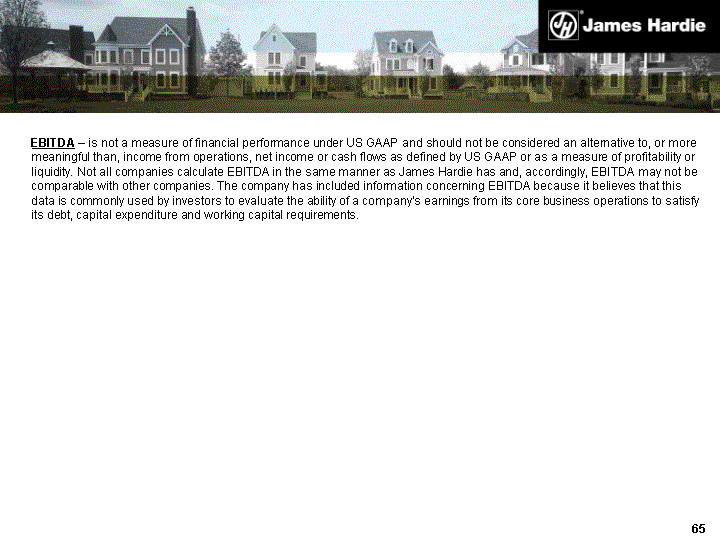
|
EBITDA - is not a measure of financial performance under US GAAP and should not be considered an alternative to, or more
meaningful than, income from operations, net income or cash flows as defined by US GAAP or as a measure of profitability or
liquidity. Not all companies calculate EBITDA in the same manner as James Hardie has and, accordingly, EBITDA may not be
comparable with other companies. The company has included information concerning EBITDA because it believes that this
data is commonly used by investors to evaluate the ability of a company's earnings from its core business operations to satisfy
its debt, capital expenditure and working capital requirements.
|
James Hardie Industries N.V.
and Subsidiaries
Condensed Consolidated Financial Statements
For the Period Ended 30 September 2006
James Hardie Industries N.V. and Subsidiaries
Index
| |
|
|
|
|
| |
|
Page |
|
Item 1. Condensed Consolidated Financial Statements (Unaudited) |
|
|
|
|
Report of Independent Registered Public Accounting Firm |
|
|
F-3 |
|
Condensed Consolidated Balance Sheets as of 30 September 2006 and
31 March 2006 |
|
|
F-4 |
|
Condensed Consolidated Statements of Income for the Three and Six Months
Ended 30 September 2006 and 2005 |
|
|
F-5 |
|
Condensed Consolidated Statements of Cash Flows for the Six Months
Ended 30 September 2006 and 2005 |
|
|
F-7 |
|
Condensed Consolidated Statements of Changes in Shareholders’ Equity for the
Six Months Ended 30 September 2006 |
|
|
F-9 |
|
Notes to Condensed Consolidated Financial Statements |
|
|
F-10 |
|
|
|
|
|
|
Item 2. Quantitative and Qualitative Disclosures About Market Risk |
|
|
F-31 |
|
F-2
Report of Independent Registered Public Accounting Firm
To the Board of Directors and Shareholders of
James Hardie Industries N.V. and Subsidiaries:
We have reviewed the accompanying condensed consolidated balance sheet of James Hardie Industries
N.V. and Subsidiaries as of 30 September 2006, and the related condensed consolidated statements of
income for each of the three-month and six-month periods ended 30 September 2006 and 2005 and the
condensed consolidated statements of cash flows for the six-month periods ended 30 September 2006
and 2005 and the condensed consolidated statement of changes in shareholders’ equity for the
six-month period ended 30 September 2006, as stated in U.S. dollars. We have not reviewed any
amounts stated in Australian dollars included in the accompanying condensed consolidated financial
statements. These interim financial statements are the responsibility of the Company’s management.
We conducted our review in accordance with the standards of the Public Company Accounting Oversight
Board (United States). A review of interim financial information consists principally of applying
analytical procedures and making inquiries of persons responsible for financial and accounting
matters. It is substantially less in scope than an audit conducted in accordance with the
standards of the Public Company Accounting Oversight Board (United States), the objective of which
is the expression of an opinion regarding the financial statements taken as a whole. Accordingly,
we do not express such an opinion.
Based on our review, we are not aware of any material modifications that should be made to the
accompanying condensed consolidated interim financial statements for them to be in conformity with
accounting principles generally accepted in the United States of America.
We previously audited in accordance with the standards of the Public Company Accounting Oversight
Board (United States), the consolidated balance sheet as of 31 March 2006, and the related
consolidated statements of income, cash flows and changes in shareholders’ equity for the year then
ended (not presented herein), and in our report dated 12 May 2006, except for Note 20, as to which
the dates were 23 June 2006, 29 June 2006 and 5 July 2006, we expressed an unqualified opinion on
those consolidated financial statements. In our opinion, the information set forth in the
accompanying condensed consolidated balance sheet information as of 31 March 2006, is fairly stated
in all material respects in relation to the consolidated balance sheet from which it has been
derived.
As discussed in Notes 7 and 9 to the condensed consolidated financial statements, the Company is
subject to certain significant contingencies, including asbestos-related claims against former
subsidiaries for which a provision in an amount representing the Company’s best estimate of the
probable outcome has been established; a Special Commission of Inquiry established by the
government of New South Wales, Australia; a Final Funding Agreement; an investigation by the
Australian Securities and Investments Commission; an offer of an indemnity to ABN 60 together with
a related commitment to provide funding to the Medical Research and Compensation Foundation; and a
significant amended tax assessment from the Australian Taxation Office.
Los Angeles, California
10 November 2006
F-3
Item 1. Financial Statements
James Hardie Industries N.V. and Subsidiaries
Condensed Consolidated Balance Sheets
(Unaudited)
| |
|
|
|
|
|
|
|
|
|
|
|
|
|
|
|
|
| |
|
Millions of |
|
|
Millions of |
|
| |
|
US Dollars |
|
|
Australian Dollars |
|
| |
|
30 September |
|
|
31 March |
|
|
30 September |
|
|
31 March |
|
| |
|
2006 |
|
|
2006 |
|
|
2006 |
|
|
2006 |
|
Assets |
|
|
|
|
|
|
|
|
|
|
|
|
|
|
|
|
Current assets: |
|
|
|
|
|
|
|
|
|
|
|
|
|
|
|
|
Cash and cash equivalents |
|
$ |
47.3 |
|
|
$ |
315.1 |
|
|
A$ |
63.2 |
|
|
A$ |
440.4 |
|
Restricted cash |
|
|
5.0 |
|
|
|
— |
|
|
|
6.7 |
|
|
|
— |
|
Accounts and notes receivable, net of allowance for
doubtful accounts of $1.5 million (A$2.0 million) and
$1.3 million (A$1.8 million) as of 30 September 2006
and 31 March 2006, respectively |
|
|
157.6 |
|
|
|
153.2 |
|
|
|
210.6 |
|
|
|
214.1 |
|
Inventories |
|
|
142.2 |
|
|
|
124.0 |
|
|
|
190.1 |
|
|
|
173.3 |
|
Prepaid expenses and other current assets |
|
|
49.3 |
|
|
|
33.8 |
|
|
|
65.9 |
|
|
|
47.2 |
|
Deferred income taxes |
|
|
24.8 |
|
|
|
30.7 |
|
|
|
33.1 |
|
|
|
42.9 |
|
|
|
|
|
|
|
|
|
|
|
|
|
|
Total current assets |
|
|
426.2 |
|
|
|
656.8 |
|
|
|
569.6 |
|
|
|
917.9 |
|
Property, plant and equipment, net |
|
|
816.1 |
|
|
|
775.6 |
|
|
|
1,090.7 |
|
|
|
1,083.9 |
|
Deferred income taxes |
|
|
5.3 |
|
|
|
4.8 |
|
|
|
7.1 |
|
|
|
6.7 |
|
Deposit with Australian Taxation Office |
|
|
141.4 |
|
|
|
— |
|
|
|
189.0 |
|
|
|
— |
|
Other assets |
|
|
7.3 |
|
|
|
8.2 |
|
|
|
9.8 |
|
|
|
11.5 |
|
|
|
|
|
|
|
|
|
|
|
|
|
|
Total assets |
|
$ |
1,396.3 |
|
|
$ |
1,445.4 |
|
|
A$ |
1,866.2 |
|
|
A$ |
2,020.0 |
|
|
|
|
|
|
|
|
|
|
|
|
|
|
Liabilities and Shareholders’ Equity |
|
|
|
|
|
|
|
|
|
|
|
|
|
|
|
|
Current liabilities: |
|
|
|
|
|
|
|
|
|
|
|
|
|
|
|
|
Accounts payable and accrued liabilities |
|
$ |
116.5 |
|
|
$ |
117.8 |
|
|
A$ |
155.7 |
|
|
A$ |
164.6 |
|
Current portion of long-term debt |
|
|
— |
|
|
|
121.7 |
|
|
|
— |
|
|
|
170.1 |
|
Short-term debt |
|
|
135.0 |
|
|
|
181.0 |
|
|
|
180.4 |
|
|
|
252.9 |
|
Accrued payroll and employee benefits |
|
|
38.5 |
|
|
|
46.3 |
|
|
|
51.5 |
|
|
|
64.7 |
|
Accrued product warranties |
|
|
8.1 |
|
|
|
11.4 |
|
|
|
10.8 |
|
|
|
15.9 |
|
Income taxes payable |
|
|
16.4 |
|
|
|
24.5 |
|
|
|
21.9 |
|
|
|
34.2 |
|
Other liabilities |
|
|
3.1 |
|
|
|
3.3 |
|
|
|
4.1 |
|
|
|
4.6 |
|
|
|
|
|
|
|
|
|
|
|
|
|
|
Total current liabilities |
|
|
317.6 |
|
|
|
506.0 |
|
|
|
424.4 |
|
|
|
707.0 |
|
Deferred income taxes |
|
|
91.6 |
|
|
|
79.8 |
|
|
|
122.4 |
|
|
|
111.5 |
|
Accrued product warranties |
|
|
7.3 |
|
|
|
4.1 |
|
|
|
9.8 |
|
|
|
5.7 |
|
Asbestos provision |
|
|
790.0 |
|
|
|
715.6 |
|
|
|
1,055.9 |
|
|
|
1,000.0 |
|
Other liabilities |
|
|
49.1 |
|
|
|
45.0 |
|
|
|
65.6 |
|
|
|
62.9 |
|
|
|
|
|
|
|
|
|
|
|
|
|
|
Total liabilities |
|
|
1,255.6 |
|
|
|
1,350.5 |
|
|
A$ |
1,678.1 |
|
|
A$ |
1,887.1 |
|
|
|
|
|
|
|
|
|
|
|
|
|
|
Commitments and contingencies (Note 7) |
|
|
|
|
|
|
|
|
|
|
|
|
|
|
|
|
Shareholders’ equity: |
|
|
|
|
|
|
|
|
|
|
|
|
|
|
|
|
Common stock, Euro 0.59 par value, 2.0 billion
shares authorised; 463,735,445 shares issued
and outstanding at 30 September 2006 and
463,306,511 shares issued and outstanding
at 31 March 2006 |
|
|
253.2 |
|
|
|
253.2 |
|
|
|
|
|
|
|
|
|
Additional paid-in capital |
|
|
161.8 |
|
|
|
158.8 |
|
|
|
|
|
|
|
|
|
Accumulated deficit |
|
|
(250.4 |
) |
|
|
(288.3 |
) |
|
|
|
|
|
|
|
|
Employee loans |
|
|
(0.3 |
) |
|
|
(0.4 |
) |
|
|
|
|
|
|
|
|
Accumulated other comprehensive loss |
|
|
(23.6 |
) |
|
|
(28.4 |
) |
|
|
|
|
|
|
|
|
|
|
|
|
|
|
|
|
|
|
|
|
|
|
|
Total shareholders’ equity |
|
|
140.7 |
|
|
|
94.9 |
|
|
|
|
|
|
|
|
|
|
|
|
|
|
|
|
|
|
|
|
|
|
|
|
Total liabilities and shareholders’ equity |
|
$ |
1,396.3 |
|
|
$ |
1,445.4 |
|
|
|
|
|
|
|
|
|
|
|
|
|
|
|
|
|
|
|
|
|
|
|
|
The accompanying notes are an integral part of these interim condensed consolidated financial statements.
F-4
James Hardie Industries N.V. and Subsidiaries
Condensed Consolidated Statements of Income
(Unaudited)
| |
|
|
|
|
|
|
|
|
|
|
|
|
|
|
|
|
| |
|
Three Months |
|
|
Six Months |
|
| |
|
Ended 30 September |
|
|
Ended 30 September |
|
| (Millions of US dollars, except per share data) |
|
2006 |
|
|
2005 |
|
|
2006 |
|
|
2005 |
|
Net sales |
|
$ |
411.4 |
|
|
$ |
376.6 |
|
|
$ |
826.9 |
|
|
$ |
736.0 |
|
Cost of goods sold |
|
|
(256.2 |
) |
|
|
(239.3 |
) |
|
|
(514.0 |
) |
|
|
(453.4 |
) |
|
|
|
|
|
|
|
|
|
|
|
|
|
Gross profit |
|
|
155.2 |
|
|
|
137.3 |
|
|
|
312.9 |
|
|
|
282.6 |
|
Selling, general and administrative expenses |
|
|
(57.2 |
) |
|
|
(49.7 |
) |
|
|
(108.9 |
) |
|
|
(95.2 |
) |
Research and development expenses |
|
|
(6.6 |
) |
|
|
(7.1 |
) |
|
|
(14.1 |
) |
|
|
(13.4 |
) |
SCI and other related expenses |
|
|
(3.2 |
) |
|
|
(4.7 |
) |
|
|
(5.6 |
) |
|
|
(9.9 |
) |
Other operating income (expense) |
|
|
— |
|
|
|
0.6 |
|
|
|
— |
|
|
|
(0.8 |
) |
Adjustments to asbestos provision |
|
|
(47.2 |
) |
|
|
— |
|
|
|
(74.4 |
) |
|
|
— |
|
|
|
|
|
|
|
|
|
|
|
|
|
|
Operating income |
|
|
41.0 |
|
|
|
76.4 |
|
|
|
109.9 |
|
|
|
163.3 |
|
Interest expense |
|
|
(0.2 |
) |
|
|
(2.3 |
) |
|
|
(5.8 |
) |
|
|
(4.0 |
) |
Interest income |
|
|
1.2 |
|
|
|
1.3 |
|
|
|
4.8 |
|
|
|
2.3 |
|
|
|
|
|
|
|
|
|
|
|
|
|
|
Income before income taxes |
|
|
42.0 |
|
|
|
75.4 |
|
|
|
108.9 |
|
|
|
161.6 |
|
Income tax expense |
|
|
(20.9 |
) |
|
|
(27.8 |
) |
|
|
(53.2 |
) |
|
|
(58.1 |
) |
|
|
|
|
|
|
|
|
|
|
|
|
|
Income before cumulative effect of change
in accounting principle |
|
|
21.1 |
|
|
|
47.6 |
|
|
|
55.7 |
|
|
|
103.5 |
|
Cumulative effect of change in accounting principle
for stock-based compensation (net of US$0.4 million
of tax for the six months ended 30 September 2006) |
|
|
— |
|
|
|
— |
|
|
|
0.9 |
|
|
|
— |
|
|
|
|
|
|
|
|
|
|
|
|
|
|
Net income |
|
$ |
21.1 |
|
|
$ |
47.6 |
|
|
$ |
56.6 |
|
|
$ |
103.5 |
|
|
|
|
|
|
|
|
|
|
|
|
|
|
Net income per share — basic |
|
$ |
0.04 |
|
|
$ |
0.10 |
|
|
$ |
0.12 |
|
|
$ |
0.22 |
|
Net income per share — diluted |
|
$ |
0.04 |
|
|
$ |
0.10 |
|
|
$ |
0.12 |
|
|
$ |
0.22 |
|
|
|
|
|
|
|
|
|
|
|
|
|
|
|
|
|
|
Weighted average common shares outstanding |
|
|
|
|
|
|
|
|
|
|
|
|
|
|
|
|
(Millions): |
|
|
|
|
|
|
|
|
|
|
|
|
|
|
|
|
Basic |
|
|
463.4 |
|
|
|
461.4 |
|
|
|
463.4 |
|
|
|
461.0 |
|
Diluted |
|
|
465.1 |
|
|
|
466.8 |
|
|
|
466.0 |
|
|
|
|
|
|
|
|
|
|
|
|
|
|
|
|
|
|
|
|
465.0 |
|
The accompanying notes are an integral part of these interim condensed consolidated financial statements.
F-5
James Hardie Industries N.V. and Subsidiaries
Condensed Consolidated Statements of Income
(Unaudited)
| |
|
|
|
|
|
|
|
|
|
|
|
|
|
|
|
|
| |
|
Three Months |
|
|
Six Months |
|
| |
|
Ended 30 September |
|
|
Ended 30 September |
|
| (Millions of Australian dollars, except per share data) |
|
2006 |
|
|
2005 |
|
|
2006 |
|
|
2005 |
|
Net sales |
|
A$ |
546.8 |
|
|
A$ |
492.9 |
|
|
A$ |
1,099.1 |
|
|
A$ |
963.3 |
|
Cost of goods sold |
|
|
(340.5 |
) |
|
|
(313.2 |
) |
|
|
(683.2 |
) |
|
|
(593.4 |
) |
|
|
|
|
|
|
|
|
|
|
|
|
|
Gross profit |
|
|
206.3 |
|
|
|
179.7 |
|
|
|
415.9 |
|
|
|
369.9 |
|
Selling, general and administrative expenses |
|
|
(76.0 |
) |
|
|
(65.0 |
) |
|
|
(144.7 |
) |
|
|
(124.6 |
) |
Research and development expenses |
|
|
(8.8 |
) |
|
|
(9.3 |
) |
|
|
(18.7 |
) |
|
|
(17.5 |
) |
SCI and other related expenses |
|
|
(4.3 |
) |
|
|
(6.2 |
) |
|
|
(7.4 |
) |
|
|
(13.0 |
) |
Other operating income (expense) |
|
|
— |
|
|
|
0.8 |
|
|
|
— |
|
|
|
(1.0 |
) |
Adjustments to asbestos provision |
|
|
(62.8 |
) |
|
|
— |
|
|
|
(98.9 |
) |
|
|
— |
|
|
|
|
|
|
|
|
|
|
|
|
|
|
Operating income |
|
|
54.4 |
|
|
|
100.0 |
|
|
|
146.2 |
|
|
|
213.8 |
|
Interest expense |
|
|
(0.3 |
) |
|
|
(3.0 |
) |
|
|
(7.7 |
) |
|
|
(5.2 |
) |
Interest income |
|
|
1.6 |
|
|
|
1.7 |
|
|
|
6.4 |
|
|
|
3.0 |
|
|
|
|
|
|
|
|
|
|
|
|
|
|
Income before income taxes |
|
|
55.7 |
|
|
|
98.7 |
|
|
|
144.9 |
|
|
|
211.6 |
|
Income tax expense |
|
|
(27.7 |
) |
|
|
(36.4 |
) |
|
|
(70.9 |
) |
|
|
(76.0 |
) |
|
|
|
|
|
|
|
|
|
|
|
|
|
Income before cumulative effect of change
in accounting principle |
|
|
28.0 |
|
|
|
62.3 |
|
|
|
74.0 |
|
|
|
135.6 |
|
Cumulative effect of change in accounting principle
for stock-based compensation (net of A$0.5 million
of tax for the six months ended 30 September 2006) |
|
|
— |
|
|
|
— |
|
|
|
1.2 |
|
|
|
— |
|
|
|
|
|
|
|
|
|
|
|
|
|
|
Net income |
|
A$ |
28.0 |
|
|
A$ |
62.3 |
|
|
A$ |
75.2 |
|
|
A$ |
135.6 |
|
|
|
|
|
|
|
|
|
|
|
|
|
|
Net income per share — basic |
|
|
A$0.06 |
|
|
|
A$0.14 |
|
|
|
A$0.16 |
|
|
|
A$0.29 |
|
Net income per share — diluted |
|
|
A$0.06 |
|
|
|
A$0.14 |
|
|
|
A$0.16 |
|
|
|
A$0.29 |
|
|
|
|
|
|
|
|
|
|
|
|
|
|
|
|
|
|
Weighted average common shares outstanding |
|
|
|
|
|
|
|
|
|
|
|
|
|
|
|
|
(Millions): |
|
|
|
|
|
|
|
|
|
|
|
|
|
|
|
|
Basic |
|
|
463.4 |
|
|
|
461.4 |
|
|
|
463.4 |
|
|
|
461.0 |
|
Diluted |
|
|
465.1 |
|
|
|
466.8 |
|
|
|
466.0 |
|
|
|
465.0 |
|
The accompanying notes are an integral part of these interim condensed consolidated financial statements.
F-6
James Hardie Industries N.V. and Subsidiaries
Condensed Consolidated Statements of Cash Flows
(Unaudited)
| |
|
|
|
|
|
|
|
|
| |
|
Six Months |
|
| |
|
Ended 30 September |
|
| (Millions of US dollars) |
|
2006 |
|
|
2005 |
|
| |
Cash Flows From Operating Activities |
|
|
|
|
|
|
|
|
Net income |
|
$ |
56.6 |
|
|
$ |
103.5 |
|
Adjustments to reconcile net income to net cash (used in)
provided by operating activities: |
|
|
|
|
|
|
|
|
Loss on disposal of subsidiaries and businesses |
|
|
— |
|
|
|
0.8 |
|
Depreciation and amortisation |
|
|
24.2 |
|
|
|
22.5 |
|
Deferred income taxes |
|
|
17.4 |
|
|
|
5.8 |
|
Prepaid pension cost |
|
|
1.5 |
|
|
|
1.3 |
|
Stock-based compensation |
|
|
1.4 |
|
|
|
1.9 |
|
Adjustments to asbestos provision |
|
|
74.4 |
|
|
|
— |
|
Cumulative effect of change in accounting principle |
|
|
(0.9 |
) |
|
|
— |
|
Deposit with Australian Taxation Office |
|
|
(141.4 |
) |
|
|
— |
|
Other |
|
|
— |
|
|
|
0.6 |
|
Changes in operating assets and liabilities: |
|
|
|
|
|
|
|
|
Restricted cash |
|
|
(5.0 |
) |
|
|
— |
|
Accounts and notes receivable |
|
|
(1.9 |
) |
|
|
(8.5 |
) |
Inventories |
|
|
(16.8 |
) |
|
|
(12.2 |
) |
Prepaid expenses and other current assets |
|
|
(16.6 |
) |
|
|
(7.2 |
) |
Accounts payable and accrued liabilities |
|
|
(1.9 |
) |
|
|
28.3 |
|
Other accrued liabilities and other liabilities |
|
|
(13.3 |
) |
|
|
9.7 |
|
|
|
|
|
|
|
|
| |
Net cash (used in) provided by operating activities |
|
|
(22.3 |
) |
|
|
146.5 |
|
|
|
|
|
|
|
|
|
|
|
|
|
|
|
|
|
Cash Flows From Investing Activities |
|
|
|
|
|
|
|
|
Purchases of property, plant and equipment |
|
|
(61.4 |
) |
|
|
(75.0 |
) |
Proceeds from disposal of subsidiaries and businesses,
net of cash divested |
|
|
— |
|
|
|
2.9 |
|
|
|
|
|
|
|
|
| |
Net cash used in investing activities |
|
|
(61.4 |
) |
|
|
(72.1 |
) |
|
|
|
|
|
|
|
|
|
|
|
|
|
|
|
|
Cash Flows From Financing Activities |
|
|
|
|
|
|
|
|
Repayments of long-term debt |
|
|
(121.7 |
) |
|
|
— |
|
Repayments of short-term debt |
|
|
(46.0 |
) |
|
|
— |
|
Proceeds from issuance of shares |
|
|
1.5 |
|
|
|
9.4 |
|
Windfall income tax benefit from stock options exercised |
|
|
0.1 |
|
|
|
1.3 |
|
Dividends paid |
|
|
(18.7 |
) |
|
|
(27.5 |
) |
Collections on loans receivable |
|
|
0.1 |
|
|
|
0.2 |
|
|
|
|
|
|
|
|
|
|
|
|
|
|
|
|
|
Net cash used in financing activities |
|
|
(184.7 |
) |
|
|
(16.6 |
) |
|
|
|
|
|
|
|
| |
Effects of exchange rate changes on cash |
|
|
0.6 |
|
|
|
(0.4 |
) |
Net (decrease) increase in cash and cash equivalents |
|
|
(267.8 |
) |
|
|
57.4 |
|
Cash and cash equivalents at beginning of period |
|
|
315.1 |
|
|
|
113.5 |
|
|
|
|
|
|
|
|
| |
Cash and cash equivalents at end of period |
|
$ |
47.3 |
|
|
$ |
170.9 |
|
|
|
|
|
|
|
|
|
|
|
|
|
|
|
|
|
Components of Cash and Cash Equivalents |
|
|
|
|
|
|
|
|
Cash at bank and on hand |
|
$ |
27.0 |
|
|
$ |
33.0 |
|
Short-term deposits |
|
|
20.3 |
|
|
|
137.9 |
|
|
|
|
|
|
|
|
Cash and cash equivalents at end of period |
|
$ |
47.3 |
|
|
$ |
170.9 |
|
|
|
|
|
|
|
|
The accompanying notes are an integral part of these interim condensed consolidated financial statements.
F-7
James Hardie Industries N.V. and Subsidiaries
Condensed Consolidated Statements of Cash Flows
(Unaudited)
| |
|
|
|
|
|
|
|
|
| |
|
Six Months |
|
| |
|
Ended 30 September |
|
| (Millions of Australian dollars) |
|
2006 |
|
|
2005 |
|
| |
Cash Flows From Operating Activities |
|
|
|
|
|
|
|
|
Net income |
|
A$ |
75.2 |
|
|
A$ |
135.6 |
|
Adjustments to reconcile net income to net cash (used in)
provided by operating activities: |
|
|
|
|
|
|
|
|
Loss on disposal of subsidiaries and businesses |
|
|
— |
|
|
|
1.0 |
|
Depreciation and amortisation |
|
|
32.2 |
|
|
|
29.4 |
|
Deferred income taxes |
|
|
23.1 |
|
|
|
7.6 |
|
Prepaid pension cost |
|
|
2.0 |
|
|
|
1.7 |
|
Stock-based compensation |
|
|
1.9 |
|
|
|
2.5 |
|
Adjustments to asbestos provision |
|
|
98.9 |
|
|
|
— |
|
Cumulative effect of change in accounting principle |
|
|
(1.2 |
) |
|
|
— |
|
Deposit with Australian Taxation Office |
|
|
(189.0 |
) |
|
|
— |
|
Other |
|
|
— |
|
|
|
0.8 |
|
Changes in operating assets and liabilities: |
|
|
|
|
|
|
|
|
Restricted cash |
|
|
(6.6 |
) |
|
|
— |
|
Accounts and notes receivable |
|
|
(2.5 |
) |
|
|
(11.1 |
) |
Inventories |
|
|
(22.3 |
) |
|
|
(16.0 |
) |
Prepaid expenses and other current assets |
|
|
(22.1 |
) |
|
|
(9.4 |
) |
Accounts payable and accrued liabilities |
|
|
(2.5 |
) |
|
|
37.0 |
|
Other accrued liabilities and other liabilities |
|
|
(17.7 |
) |
|
|
12.7 |
|
|
|
|
|
|
|
|
| |
Net cash (used in) provided by operating activities |
|
|
(30.6 |
) |
|
|
191.8 |
|
|
|
|
|
|
|
|
|
|
|
|
|
|
|
|
|
Cash Flows From Investing Activities |
|
|
|
|
|
|
|
|
Purchases of property, plant and equipment |
|
|
(81.6 |
) |
|
|
(98.2 |
) |
Proceeds from disposal of subsidiaries and businesses,
net of cash divested |
|
|
— |
|
|
|
3.8 |
|
|
|
|
|
|
|
|
| |
Net cash used in investing activities |
|
|
(81.6 |
) |
|
|
(94.4 |
) |
|
|
|
|
|
|
|
|
|
|
|
|
|
|
|
|
Cash Flows From Financing Activities |
|
|
|
|
|
|
|
|
Repayments of long-term debt |
|
|
(161.8 |
) |
|
|
— |
|
Repayments of short-term debt |
|
|
(61.1 |
) |
|
|
— |
|
Proceeds from issuance of shares |
|
|
2.0 |
|
|
|
12.3 |
|
Windfall income tax benefit from stock options exercised |
|
|
0.1 |
|
|
|
1.7 |
|
Dividends paid |
|
|
(24.9 |
) |
|
|
(36.0 |
) |
Collections on loans receivable |
|
|
0.1 |
|
|
|
0.3 |
|
|
|
|
|
|
|
|
Net cash used in financing activities |
|
|
(245.6 |
) |
|
|
(21.7 |
) |
|
|
|
|
|
|
|
Effects of exchange rate changes on cash |
|
|
(19.4 |
) |
|
|
1.8 |
|
Net (decrease) increase in cash and cash equivalents |
|
|
(377.2 |
) |
|
|
77.5 |
|
Cash and cash equivalents at beginning of period |
|
|
440.4 |
|
|
|
146.9 |
|
|
|
|
|
|
|
|
Cash and cash equivalents at end of period |
|
A$ |
63.2 |
|
|
A$ |
224.4 |
|
|
|
|
|
|
|
|
|
|
|
|
|
|
|
|
|
Components of Cash and Cash Equivalents |
|
|
|
|
|
|
|
|
Cash at bank and on hand |
|
A$ |
36.1 |
|
|
A$ |
43.3 |
|
Short-term deposits |
|
|
27.1 |
|
|
|
181.1 |
|
|
|
|
|
|
|
|
Cash and cash equivalents at end of period |
|
A$ |
63.2 |
|
|
A$ |
224.4 |
|
|
|
|
|
|
|
|
The accompanying notes are an integral part of these interim condensed consolidated financial statements.
F-8
James Hardie Industries N.V. and Subsidiaries
Condensed Consolidated Statements of Changes in Shareholders’ Equity
(Unaudited)
| |
|
|
|
|
|
|
|
|
|
|
|
|
|
|
|
|
|
|
|
|
|
|
|
|
| |
|
|
|
|
|
|
|
|
|
|
|
|
|
|
|
|
|
Accumulated |
|
|
|
|
| |
|
|
|
|
|
Additional |
|
|
|
|
|
|
|
|
|
|
Other |
|
|
|
|
| |
|
Common |
|
|
Paid-in |
|
|
Accumulated |
|
|
Employee |
|
|
Comprehensive |
|
|
|
|
| (Millions of US dollars) |
|
Stock |
|
|
Capital |
|
|
Deficit |
|
|
Loans |
|
|
(Loss) Income |
|
|
Total |
|
Balances as of 31 March 2006 |
|
$ |
253.2 |
|
|
$ |
158.8 |
|
|
$ |
(288.3 |
) |
|
$ |
(0.4 |
) |
|
$ |
(28.4 |
) |
|
$ |
94.9 |
|
Comprehensive income: |
|
|
|
|
|
|
|
|
|
|
|
|
|
|
|
|
|
|
|
|
|
|
|
|
Net income |
|
|
— |
|
|
|
— |
|
|
|
56.6 |
|
|
|
— |
|
|
|
— |
|
|
|
56.6 |
|
Other comprehensive income: |
|
|
|
|
|
|
|
|
|
|
|
|
|
|
|
|
|
|
|
|
|
|
|
|
Foreign currency translation |
|
|
— |
|
|
|
— |
|
|
|
— |
|
|
|
— |
|
|
|
4.8 |
|
|
|
4.8 |
|
|
|
|
|
|
|
|
|
|
|
|
|
|
|
|
|
|
|
|
|
|
|
|
|
Total comprehensive income |
|
|
|
|
|
|
|
|
|
|
|
|
|
|
|
|
|
|
|
|
|
|
61.4 |
|
|
|
|
|
|
|
|
|
|
|
|
|
|
|
|
|
|
|
|
|
|
|
|
|
Dividends paid |
|
|
— |
|
|
|
— |
|
|
|
(18.7 |
) |
|
|
— |
|
|
|
— |
|
|
|
(18.7 |
) |
Stock-based compensation |
|
|
— |
|
|
|
1.4 |
|
|
|
— |
|
|
|
— |
|
|
|
— |
|
|
|
1.4 |
|
Tax benefit from stock options exercised |
|
|
— |
|
|
|
0.1 |
|
|
|
— |
|
|
|
— |
|
|
|
— |
|
|
|
0.1 |
|
Employee loans repaid |
|
|
— |
|
|
|
— |
|
|
|
— |
|
|
|
0.1 |
|
|
|
— |
|
|
|
0.1 |
|
Stock options exercised |
|
|
— |
|
|
|
1.5 |
|
|
|
— |
|
|
|
— |
|
|
|
— |
|
|
|
1.5 |
|
|
|
|
|
|
|
|
|
|
|
|
|
|
|
|
|
|
|
|
Balances as of 30 September 2006 |
|
$ |
253.2 |
|
|
$ |
161.8 |
|
|
$ |
(250.4 |
) |
|
$ |
(0.3 |
) |
|
$ |
(23.6 |
) |
|
$ |
140.7 |
|
|
|
|
|
|
|
|
|
|
|
|
|
|
|
|
|
|
|
|
The accompanying notes are an integral part of these interim condensed consolidated financial statements.
F-9
James Hardie Industries N.V. and Subsidiaries
Notes to Condensed Consolidated Financial Statements
(Unaudited)
Nature of Operations
The Company manufactures and sells fibre cement building products for interior and exterior
building construction applications, primarily in the United States, Australia, New Zealand,
Philippines and Europe.
Basis of Presentation
The condensed consolidated financial statements represent the financial position, results of
operations and cash flows of James Hardie Industries N.V. (“JHI NV”) and its current wholly
owned subsidiaries, collectively referred to as either the “Company” or “James Hardie” and JHI
NV together with its subsidiaries as of the time relevant to the applicable reference, are
collectively referred to as the “James Hardie Group,” unless the context indicates otherwise.
Intercompany transactions have been eliminated in consolidation.
The consolidated financial statements included herein are unaudited; however, they contain all
normal recurring adjustments which, in the opinion of the Company’s management, are necessary
to state fairly the consolidated financial position of the Company at 30 September 2006, and
the consolidated results of operations and the consolidated cash flows for the three and six
months ended 30 September 2006 and 2005. The results of operations for the three and six
months ended 30 September 2006 are not necessarily indicative of the results to be expected
for the full year. The year-end condensed balance sheet data was derived from audited
financial statements, but does not include all disclosure required by accounting principles
generally accepted in the United States of America.
The assets, liabilities, statements of income and statements of cash flows of the Company have
been presented with accompanying Australian dollar (A$) convenience translations as the
majority of the Company’s shareholder base is Australian. These A$ convenience translations
are not prepared in accordance with accounting principles generally accepted in the United
States of America. The exchange rates used to calculate the convenience translations are as
follows:
| |
|
|
|
|
|
|
|
|
|
|
|
|
| |
|
31 March |
|
|
30 September |
| (US$1 = A$) |
|
2006 |
|
2006 |
|
2005 |
| |
Assets and liabilities |
|
|
1.3975 |
|
|
|
1.3365 |
|
|
|
1.3133 |
|
Income statement |
|
|
n/a |
|
|
|
1.3292 |
|
|
|
1.3088 |
|
Cash flows — beginning cash |
|
|
n/a |
|
|
|
1.3975 |
|
|
|
1.2946 |
|
Cash flows — ending cash |
|
|
n/a |
|
|
|
1.3365 |
|
|
|
1.3133 |
|
Cash flows — current period movements |
|
|
n/a |
|
|
|
1.3292 |
|
|
|
1.3088 |
|
The asbestos provision on the A$ unaudited consolidated statements of income and A$ unaudited
consolidated statements of cash flows is the difference in the balance sheet rate at 30
September and 31 March 2006, respectively, translated using the assets and liabilities rate at
30 September 2006.
| 2. |
|
Summary of Significant Accounting Policies |
Earnings Per Share
The Company is required to disclose basic and diluted earnings per share (“EPS”). Basic EPS is
calculated using income divided by the weighted average number of common shares outstanding
during the period. Diluted EPS is similar to basic EPS except that the weighted average number
of common shares outstanding is increased to include the number of additional common shares
calculated using the treasury method that would have been outstanding if dilutive potential
common
F-10
James Hardie Industries N.V. and Subsidiaries
Notes to Condensed Consolidated Financial Statements (Continued)
(Unaudited)
shares, such as options, had been exercised. Accordingly, basic and dilutive common shares outstanding used in determining net income per share are as follows:
| |
|
|
|
|
|
|
|
|
|
|
|
|
|
|
|
|
| |
|
Three Months |
|
|
Six Months |
|
| |
|
Ended 30 September |
|
|
Ended 30 September |
|
| (Millions of shares) |
|
2006 |
|
|
2005 |
|
|
2006 |
|
|
2005 |
|
| |
Basic common shares outstanding |
|
|
463.4 |
|
|
|
461.4 |
|
|
|
463.4 |
|
|
|
461.0 |
|
Dilutive effect of stock options |
|
|
1.7 |
|
|
|
5.4 |
|
|
|
2.6 |
|
|
|
4.0 |
|
|
|
|
|
|
|
|
|
|
|
|
|
|
Diluted common shares outstanding |
|
|
465.1 |
|
|
|
466.8 |
|
|
|
466.0 |
|
|
|
465.0 |
|
|
|
|
|
|
|
|
|
|
|
|
|
|
| |
|
|
|
|
|
|
|
|
|
|
|
|
|
|
|
|
| US dollars |
|
2006 |
|
2005 |
|
2006 |
|
2005 |
| |
Net income per share — basic |
|
$ |
0.04 |
|
|
$ |
0.10 |
|
|
$ |
0.12 |
|
|
$ |
0.22 |
|
Net income per share — diluted |
|
$ |
0.04 |
|
|
$ |
0.10 |
|
|
$ |
0.12 |
|
|
$ |
0.22 |
|
Potential common shares of 10.3 million and nil for the three months ended 30 September 2006 and
2005, respectively, and 6.5 million and nil for the six months ended 30 September 2006 and 2005,
respectively, have been excluded from the calculations of diluted common shares outstanding because
the effect of their inclusion would be anti-dilutive.
Advertising
The Company expenses the production costs of advertising the first time the advertising takes
place. Advertising expense was US$4.6 million and US$4.9 million for the three months ended 30
September 2006 and 2005, respectively, and US$8.9 million and US$9.3 million for the six months
ended 30 September 2006 and 2005, respectively.
Stock-Based Compensation
The Company implemented the provisions of Statement of Financial Accounting Standards (“SFAS”) No.
123, Accounting for Stock-Based Compensation, using the retroactive restatement method provided by
SFAS No. 148, Accounting for Stock-Based Compensation – Transition and Disclosure – an amendment
SFAS No. 123. When SFAS No. 123 was adopted, the retroactive restatement method required the
restatement of prior periods’ reported net income to give effect to the fair value based method of
accounting for awards granted, modified or settled in fiscal years beginning after 15 December
1994. Therefore, no transition adjustments are required upon the Company adopting SFAS No. 123R,
Shared-based Payments. In adopting this standard the Company has employed the modified prospective
transition method.
SFAS No. 123R requires that a company estimate forfeitures of stock options at the date of grant
rather than allowing the company to account for forfeitures as they occur. At the time the Company
adopted SFAS No. 123, it decided to account for forfeitures as they occur, primarily due to the
limited historical data to accurately estimate a forfeiture rate at the date of grant.
The Company recognised stock-based compensation expense (included in selling, general and
administrative expense) of US$1.2 million and US$0.9 million for the three months ended 30
September 2006 and 2005, respectively, and US$2.7 million and US$1.9 million for the six months
ended 30 September 2006 and 2005, respectively. This excludes the forfeiture adjustment of US$1.3
million (US$0.9 million net of tax) for the six months ended 30 September 2006, which is separately
disclosed as “Cumulative effect of change in accounting principle for stock-based compensation.”
The tax benefit related to the forfeiture adjustment was US$0.4 million for the six months ended 30
September 2006.
F-11
James Hardie Industries N.V. and Subsidiaries
Notes to Condensed Consolidated Financial Statements (Continued)
(Unaudited)
The Company analysed forfeiture rates on all of the 2001 Stock Option Plan grants for which
vesting was complete resulting in an estimated weighted average forfeiture rate of 30.7%. Based on
this calculated rate, a cumulative adjustment to stock-based compensation expense of US$1.3 million
was recorded for the six months ended 30 September 2006, upon adoption of SFAS No. 123R. The
adjustment is presented on the condensed consolidated statements of income as a cumulative effect
of change in accounting principle (net of income tax).
The portion of the forfeiture cumulative adjustment that relates to USA-based employees did cause a
reduction in the deferred tax asset previously recorded. The amount of the cumulative adjustment
related to USA-based employees was approximately US$1.0 million. Therefore, the related USA income
tax adjustment was approximately US$0.4 which was recorded to income tax expense.
Recent Accounting Pronouncements
Uncertain Tax Positions
In June 2006, the Financial Accounting Standards Board (“FASB”) issued Interpretation No. 48 (FIN
48), Accounting for Uncertainty in Income Taxes, an interpretation of Statement of Financial
Accounting Standard No. 109 (“SFAS No. 109”). FIN 48 clarifies the accounting for uncertainty in
income taxes recognised in an enterprise’s financial statements in accordance with SFAS No. 109.
Unlike SFAS No. 109, Accounting for Income Taxes, FIN 48 prescribes a recognition threshold and
measurement attribute for the financial statement recognition and measurement of a tax position
taken or expected to be taken in a tax return. Additionally, FIN 48 provides guidance on
derecognition, classification, interest and penalties, accounting in interim periods, disclosure
and transition. The Company will adopt the provisions of FIN 48 effective 1 April 2007. The
Company has not yet determined the effect of the adoption of FIN 48 on its financial position or
results of operations.
Defined Benefit and Other Postretirement Plans
In September 2006, the FASB issued SFAS No. 158, Employers’ Accounting for Defined Benefit Pension
and Other Postretirement Plans. The statement requires an employer to (a) recognise the funded
status of a benefit plan in its statement of financial position, (b) recognise as a component of
other comprehensive income, net of tax, the gains or losses and prior service costs or credits that
arise during the period but are not recognised as components of net periodic benefit cost pursuant
to SFAS No. 87, Employers’ Accounting for Pensions, or SFAS No. 106, Employers’ Accounting for
Postretirement Benefits Other than Pensions, (c) measure defined benefit plan assets and
obligations as of the date of the employer’s fiscal year end statement of financial position, and
(d) disclose in the notes to the financial statements additional information about certain effects
on net periodic benefit cost for the next fiscal year that arise from delayed recognition of the
gains or losses, prior service costs or credits and transitional asset or obligation. The Company
will adopt the provisions of SFAS No. 158 effective 31 March 2007. As of 31 March 2006, the
valuation of the unallocated unrecognised loss was US$5.2 million which is the Company’s best
estimate of the effect of adoption. On adoption of the standard, an updated valuation of this
amount will be performed and all required adjustments will be recorded.
The Process of Quantifying Financial Statement Misstatements
In September 2006, the Securities and Exchange Commission (“SEC”) staff issued Staff Accounting
Bulletin No. 108 (“SAB No. 108”) in order to address the observed diversity in quantification
practices with respect to annual financial statements. For a number of years, the
SEC staff has expressed concern over the diversity of practice surrounding how public companies
(and their auditors) quantify financial statement misstatements.
Per SAB No. 108, the SEC staff establishes an approach that requires quantification of financial
statement errors based on the effects of the error on each of the company’s financial statements
and
F-12
James Hardie Industries N.V. and Subsidiaries
Notes to Condensed Consolidated Financial Statements (Continued)
(Unaudited)
| |
|
the related financial statement disclosures. The Company does not expect the adoption of
this standard will have any impact on the consolidated financial statements. |
| |
| 3. |
|
Inventories |
| |
| |
|
Inventories consist of the following components: |
| |
|
|
|
|
|
|
|
|
| |
|
30 September |
|
|
31 March |
|
| (Millions of US dollars) |
|
2006 |
|
|
2006 |
|
Finished goods |
|
$ |
93.4 |
|
|
$ |
84.1 |
|
Work-in-process |
|
|
15.2 |
|
|
|
9.2 |
|
Raw materials and supplies |
|
|
36.5 |
|
|
|
33.0 |
|
Provision for obsolete finished goods and raw materials |
|
|
(2.9 |
) |
|
|
(2.3 |
) |
|
|
|
|
|
|
|
Total inventories |
|
$ |
142.2 |
|
|
$ |
124.0 |
|
|
|
|
|
|
|
|
| |
|
Inventories are valued at the lower of cost or market. Cost is generally determined under
the first-in, first-out method, except that the cost of raw materials and supplies is
determined using actual or average costs. Cost includes the costs of materials, labour and
applied factory overhead. |
| |
| 4. |
|
Disposal of Chile Business |
| |
| |
|
In June 2005, the Company approved a plan to dispose of its Chile Fibre Cement business to
Compania Industrial El Volcan S.A. (Volcan). The sale closed on 8 July 2005. The Company
received net proceeds of US$3.9 million and recorded a loss on disposal of US$0.8 million. |
| |
| |
|
As part of the terms of the sale of the Chile Fibre Cement business to Volcan, the Company
entered into a two-year take or pay purchase contract for fibre cement product manufactured by
Volcan. The first year of the contract amounts to a purchase commitment of approximately US$2.8
million and the second year amounts to a purchase commitment of approximately US$2.1 million.
As this contract qualifies as continuing involvement per SFAS No. 144, Accounting for the
Impairment or Disposal of Long Lived Assets, the operating results and loss on disposal of the
Chile Fibre Cement business are included in the Company’s income from operations and are
comprised of the following components: |
| |
|
|
|
|
|
|
|
|
| |
|
Three Months |
|
|
Six Months |
|
| |
|
Ended 30 September |
|
|
Ended 30 September |
|
| (Millions of US dollars) |
|
2005 |
|
|
2005 |
|
Chile Fibre Cement |
|
|
|
|
|
|
|
|
Net sales |
|
$ |
0.5 |
|
|
$ |
5.1 |
|
Cost of goods sold |
|
|
(0.4 |
) |
|
|
(3.5 |
) |
|
|
|
|
|
|
|
Gross profit |
|
|
0.1 |
|
|
|
1.6 |
|
Selling, general and administrative expenses |
|
|
(0.2 |
) |
|
|
(1.2 |
) |
Income (loss) on disposal of business |
|
|
0.6 |
|
|
|
(0.8 |
) |
|
|
|
|
|
|
|
Operating income (loss) |
|
|
0.5 |
|
|
|
(0.4 |
) |
Interest expense |
|
|
— |
|
|
|
(0.2 |
) |
|
|
|
|
|
|
|
Net income (loss) |
|
$ |
0.5 |
|
|
$ |
(0.6 |
) |
|
|
|
|
|
|
|
F-13
James Hardie Industries N.V. and Subsidiaries
Notes to Condensed Consolidated Financial Statements (Continued)
(Unaudited)
| 5. |
|
Operating Segment Information and Concentrations of Risk |
| |
| |
|
The Company has reported its operating segment information in the format that the operating
segment information is available to and evaluated by the Board of Directors. USA Fibre Cement
manufactures and sells fibre cement interior linings, exterior siding and related accessories
products in the United States. Asia Pacific Fibre Cement includes all fibre cement manufactured
in Australia, New Zealand and the Philippines and sold in Australia, New Zealand and Asia.
Research and Development represents the cost incurred by the research and development centres.
Other includes the manufacture and sale of fibre cement products in Chile (through June 2005),
the manufacture and sale of fibre cement reinforced pipes in the United States, fibre cement
operations in Europe and roofing operations in the United States. The Company sold its Chile
business in July 2005. In April 2006, the roofing plant was closed and the business ceased
operations. The Company’s operating segments are strategic operating units that are managed
separately due to their different products and/or geographical location. |
| |
| |
|
The asbestos provision and adjustments thereto are treated as a separate caption. |
| |
| |
|
Operating Segments |
| |
| |
|
The following are the Company’s operating segments and geographical information: |
| |
|
|
|
|
|
|
|
|
|
|
|
|
|
|
|
|
| |
|
Net Sales to Customers |
|
|
Net Sales to Customers |
|
| |
|
Three Months |
|
|
Six Months |
|
| |
|
Ended 30 September |
|
|
Ended 30 September |
|
| (Millions of US dollars) |
|
2006 |
|
|
2005 |
|
|
2006 |
|
|
2005 |
|
USA Fibre Cement |
|
$ |
339.0 |
|
|
$ |
307.4 |
|
|
$ |
687.9 |
|
|
$ |
594.9 |
|
Asia Pacific Fibre Cement |
|
|
63.8 |
|
|
|
63.5 |
|
|
|
123.0 |
|
|
|
125.2 |
|
Other |
|
|
8.6 |
|
|
|
5.7 |
|
|
|
16.0 |
|
|
|
15.9 |
|
|
|
|
|
|
|
|
|
|
|
|
|
|
Worldwide total |
|
$ |
411.4 |
|
|
$ |
376.6 |
|
|
$ |
826.9 |
|
|
$ |
736.0 |
|
|
|
|
|
|
|
|
|
|
|
|
|
|
| |
|
|
|
|
|
|
|
|
|
|
|
|
|
|
|
|
| |
|
Income |
|
|
Income |
|
| |
|
Before Income Taxes |
|
|
Before Income Taxes |
|
| |
|
Three Months |
|
|
Six Months |
|
| |
|
Ended 30 September |
|
|
Ended 30 September |
|
| (Millions of US dollars) |
|
2006 |
|
|
2005 |
|
|
2006 |
|
|
2005 |
|
USA Fibre Cement |
|
$ |
97.8 |
|
|
$ |
86.1 |
|
|
$ |
201.1 |
|
|
$ |
180.2 |
|
Asia Pacific Fibre Cement |
|
|
11.5 |
|
|
|
12.0 |
|
|
|
21.8 |
|
|
|
24.4 |
|
Research and Development |
|
|
(4.1 |
) |
|
|
(4.0 |
) |
|
|
(8.7 |
) |
|
|
(7.2 |
) |
Other |
|
|
(1.5 |
) |
|
|
(2.6 |
) |
|
|
(4.2 |
) |
|
|
(6.1 |
) |
|
|
|
|
|
|
|
|
|
|
|
|
|
Segments total |
|
|
103.7 |
|
|
|
91.5 |
|
|
|
210.0 |
|
|
|
191.3 |
|
General Corporate |
|
|
(15.5 |
) |
|
|
(15.1 |
) |
|
|
(25.7 |
) |
|
|
(28.0 |
) |
Adjustments to asbestos provision |
|
|
(47.2 |
) |
|
|
— |
|
|
|
(74.4 |
) |
|
|
— |
|
|
|
|
|
|
|
|
|
|
|
|
|
|
Total operating income |
|
|
41.0 |
|
|
|
76.4 |
|
|
|
109.9 |
|
|
|
163.3 |
|
Net interest income (expense) |
|
|
1.0 |
|
|
|
(1.0 |
) |
|
|
(1.0 |
) |
|
|
(1.7 |
) |
|
|
|
|
|
|
|
|
|
|
|
|
|
Worldwide total |
|
$ |
42.0 |
|
|
$ |
75.4 |
|
|
$ |
108.9 |
|
|
$ |
161.6 |
|
|
|
|
|
|
|
|
|
|
|
|
|
|
F-14
James Hardie Industries N.V. and Subsidiaries
Notes to Condensed Consolidated Financial Statements (Continued)
(Unaudited)
| |
|
|
|
|
|
|
|
|
| |
|
Total Identifiable Assets |
|
| |
|
30 September |
|
|
31 March |
|
| (Millions of US dollars) |
|
2006 |
|
|
2006 |
|
USA Fibre Cement |
|
$ |
881.3 |
|
|
$ |
826.0 |
|
Asia Pacific Fibre Cement |
|
|
188.2 |
|
|
|
170.4 |
|
Other |
|
|
56.5 |
|
|
|
54.8 |
|
|
|
|
|
|
|
|
Segments total |
|
|
1,126.0 |
|
|
|
1,051.2 |
|
General Corporate |
|
|
270.3 |
|
|
|
394.2 |
|
|
|
|
|
|
|
|
Worldwide total |
|
$ |
1,396.3 |
|
|
$ |
1,445.4 |
|
|
|
|
|
|
|
|
Geographic Areas
| |
|
|
|
|
|
|
|
|
|
|
|
|
|
|
|
|
| |
|
Net Sales to Customers |
|
|
Net Sales to Customers |
|
| |
|
Three Months |
|
|
Six Months |
|
| |
|
Ended 30 September |
|
|
Ended 30 September |
|
| (Millions of US dollars) |
|
2006 |
|
|
2005 |
|
|
2006 |
|
|
2005 |
|
USA |
|
$ |
344.5 |
|
|
$ |
310.9 |
|
|
$ |
698.2 |
|
|
$ |
602.1 |
|
Australia |
|
|
43.3 |
|
|
|
43.6 |
|
|
|
84.3 |
|
|
|
86.1 |
|
New Zealand |
|
|
13.5 |
|
|
|
14.2 |
|
|
|
25.9 |
|
|
|
27.8 |
|
Other Countries |
|
|
10.1 |
|
|
|
7.9 |
|
|
|
18.5 |
|
|
|
20.0 |
|
|
|
|
|
|
|
|
|
|
|
|
|
|
Worldwide total |
|
$ |
411.4 |
|
|
$ |
376.6 |
|
|
$ |
826.9 |
|
|
$ |
736.0 |
|
|
|
|
|
|
|
|
|
|
|
|
|
|
| |
|
|
|
|
|
|
|
|
| |
|
Total Identifiable Assets |
|
| |
|
30 September |
|
|
31 March |
|
| (Millions of US dollars) |
|
2006 |
|
|
2006 |
|
USA |
|
$ |
925.4 |
|
|
$ |
870.3 |
|
Australia |
|
|
121.3 |
|
|
|
108.5 |
|
New Zealand |
|
|
20.8 |
|
|
|
18.7 |
|
Other Countries |
|
|
58.5 |
|
|
|
53.7 |
|
|
|
|
|
|
|
|
Segments total |
|
|
1,126.0 |
|
|
|
1,051.2 |
|
General Corporate |
|
|
270.3 |
|
|
|
394.2 |
|
|
|
|
|
|
|
|
Worldwide total |
|
$ |
1,396.3 |
|
|
$ |
1,445.4 |
|
|
|
|
|
|
|
|
| 6. |
|
Accumulated Other Comprehensive Loss |
| |
| |
|
Accumulated other comprehensive loss as reported in the condensed consolidated balance sheets
is comprised entirely of foreign currency translation adjustments of US$23.6 million and
US$28.4 million at 30 September 2006 and 31 March 2006, respectively. |
| |
| 7. |
|
Commitments and Contingencies |
| |
| |
|
Commitment to provide funding on a long-term basis in respect of asbestos-related liabilities
of former subsidiaries |
| |
| |
|
On 1 December 2005, the Company announced that it, the NSW Government and a wholly owned
Australian subsidiary of the Company (James Hardie 117 Pty Ltd (formerly LGTDD Pty Ltd),
described below as the “Performing Subsidiary”) had entered into a conditional
agreement (the “Final
Funding Agreement”) to provide long-term funding to a special purpose fund (“SPF”) that will
provide compensation for Australian asbestos-related personal injury claims against certain
former James |
F-15
James Hardie Industries N.V. and Subsidiaries
Notes to Condensed Consolidated Financial Statements (Continued)
(Unaudited)
Hardie companies (being Amaca Pty Ltd (“Amaca”), Amaba Pty Ltd (“Amaba”) and ABN
60 000 009 263 Pty Ltd (“ABN 60”)) (the “Former James Hardie Companies”).
Key events occurring since 2001 that led to the signing of the Final Funding Agreement (“FFA”)
are summarised in the Company’s Annual Report on Form 20-F for the year ended 31 March 2006 as
further updated below.
The FFA is subject to a number of conditions precedent, including the receipt of an independent
expert’s report confirming that the funding proposal is in the best interests of the Company
and its enterprise as a whole, approval of the Company’s shareholders and lenders, and
confirmation satisfactory to the Company’s Board of Directors, acting reasonably, that the
contributions to be made by JHI NV and the Performing Subsidiary under the FFA will be tax
deductible and confirmation as to the expected tax consequences arising to the SPF and others
from implementing the arrangements (or that alternative arrangements will exist which are
satisfactory to the Company’s Board of Directors).
In summary, the FFA provides for the following key steps to occur if the conditions precedent
to that agreement are satisfied or waived in writing by the parties:
| |
— |
|
the establishment of the SPF to provide compensation to Australian asbestos-related
personal injury claimants with proven claims against the Former James Hardie
Companies; |
| |
| |
— |
|
initial funding of approximately A$154 million provided by the Performing
Subsidiary to the SPF, calculated on the basis of an actuarial report prepared by KPMG
Actuaries Pty Ltd (“KPMG Actuaries”) as of 31 March 2006. That report provided an
estimate of the discounted net present value of all present and future Australian
asbestos-related personal injury claims against the Former James Hardie Companies of
A$1.52 billion (US$1.14 billion); |
| |
| |
— |
|
subject to the cap described below, an annual contribution in advance to top up the
funds in the SPF to equal the actuarially calculated estimate of expected Australian
asbestos-related personal injury claims against the Former James Hardie Companies for
the following three years, to be revised annually (so as to create a rolling cash
“buffer” in the SPF); |
| |
| |
— |
|
a cap on the annual payments made by the Performing Subsidiary to the SPF,
initially set at 35% of the Company’s free cash flow (defined as cash from operations
in accordance with US GAAP in force at the date of the FFA) for the immediately
preceding financial year, with provisions for the percentage to decline over time
depending upon the Company’s financial performance (and therefore the contributions
already made to the SPF) and the claims outlook; |
| |
| |
— |
|
an initial term of approximately 40 years, at the end of which time the parties may
either agree upon a final payment to be made by the Company in satisfaction of any
further funding obligations, or have the term automatically extended for further
periods of 10 years until such agreement is reached or the relevant asbestos-related
liabilities cease to arise; |
| |
| |
— |
|
the entry by the parties and/or others into agreements ancillary to or connected
with the FFA (the “Related Agreements”); |
| |
| |
— |
|
no cap on individual payments to asbestos claimants; |
| |
| |
— |
|
the Performing Subsidiary’s payment obligations are guaranteed by James Hardie
Industries N.V.; |
| |
| |
— |
|
the SPF’s claims to the funding payments required under the FFA will be
subordinated to the claims of the Company’s lenders; and |
F-16
James Hardie Industries N.V. and Subsidiaries
Notes to Condensed Consolidated Financial Statements (Continued)
(Unaudited)
| |
— |
|
the compensation arrangements will extend to members of the Baryulgil community for
asbestos-related claims arising from the activities of a former subsidiary of ABN 60,
as described below. |
The Company has made significant progress towards satisfying the tax related conditions
precedent described above.
The Company’s ability to obtain a tax deduction has been confirmed by the Australian Taxation
Office (“ATO”) in a form binding on the Australian Federal Commissioner of Taxation
(“Commissioner”) for the term of the FFA. The private ruling issued by the ATO provides
deductibility over a five year period from the date of contribution, whereas the condition
precedent in the FFA provides for deductibility of contributions in the year incurred. The
Company has indicated to the NSW Government that it is prepared to accept this basis of
deductibility of the funding payments, if the tax condition relating to the tax exempt status
of the SPF can be satisfactorily resolved.
On 9 November 2006, James Hardie announced that it, the SPF and others had received private
binding rulings relating to the expected tax consequences arising to the SPF and others that
the company believes will deliver an acceptable outcome for the proposed SPF. The rulings have
also been welcomed by both the New South Wales (“NSW”) Government and the Australian Council of
Trade Unions (ACTU), with whom James Hardie settled the terms of the FFA and related
agreements.
The Company is now seeking to finalise an amended FFA and related agreements with the NSW
Government so that all relevant documents can be signed as soon as possible and the Company can
seek lender and shareholder approval. In order to do so, James Hardie and the NSW Government
need to execute an amended FFA in a form which reflects the changes which were the subject of
the ruling applications. In recent weeks the NSW Government and James Hardie have worked
together to obtain these rulings. Thoughout this process, James Hardie has provided the NSW
Government with copies of submissions provided to the ATO, including relevant draft agreements,
and copies of the private rulings.
In addition to entering into the FFA, one or more of the Company, the Performing Subsidiary,
the SPF and the NSW Government have entered into a number of Related Agreements, including a
trust deed (for a trust known as the Asbestos Injuries Compensation Fund), which we refer to as
the Trust Deed, for the establishment of the SPF; a deed of guarantee under which James Hardie
Industries N.V. provides the guarantee described above; intercreditor deeds to achieve the
subordination arrangements described above; and deeds of release in connection with the
releases from civil liability described below.
As part of those discussions, it is likely that the agreed amount set out in the FFA as the
initial funding payment will be recalculated so as to take into account updated claims data and
the effect of delays in implementing the FFA.
The Company considers that the principal outstanding conditions which remain to be fulfilled
before the FFA becomes effective are those relating to the approval of the FFA by the Company’s
shareholders and lenders.
James Hardie and other relevant parties are well advanced in their work to secure lender
approval, obtain an independent experts’ report and prepare the Explanatory Memorandum for
shareholders.
In addition, in order to implement the amended FFA, certain conditions precedent will need to
be satisfied, including the NSW Parliament passing facilitating legislation. The resolution of
these issues involves uncertainty and there can be no assurance that the obtaining of the ATO
rulings will lead to a finalisation of the amended FFA that is required to resolve the
position, or that the NSW
F-17
James Hardie Industries N.V. and Subsidiaries
Notes to Condensed Consolidated Financial Statements (Continued)
(Unaudited)
Parliament will pass such facilitating legislation. It is possible
that further amendments to the FFA and related agreements or to such facilitating legislation
may be sought or necessary in order to
achieve an arrangement which is fully acceptable to the NSW Government as well as James Hardie.
However, James Hardie believes (and understands that the NSW Government agrees) that the
obtaining of the ATO rulings is an important milestone towards implementing the funding
proposal.
It is anticipated that an extraordinary general meeting of shareholders to approve the
implementation of the amended FFA could be convened within 10 weeks of James Hardie and the NSW
Government executing the amended FFA. Given the close proximity to the Christmas and New Year
holiday period and the difficulty of convening shareholder meetings during this period, the
Company expects this meeting could be held in February 2007.
The recording of the asbestos provision is in accordance with US accounting standards because
it is probable that the Company will make payments to fund asbestos-related claims on a
long-term basis. The amount of the asbestos provision of US$790.0 million (A$1.06 billion) at
30 September 2006 is the Company’s best estimate of the probable outcome. This estimate is
based on the terms of the FFA, which includes an actuarial estimate prepared by KPMG Actuaries
as of 30 September 2006 of the projected future cash outflows, undiscounted and uninflated.
Even if the conditions to the Company’s funding obligations under the FFA are not fulfilled,
the Company has determined that it is nevertheless likely that it will make payments in respect
of certain claimants who were injured by asbestos-containing products manufactured by certain
former Australian subsidiary companies. The Company’s Joint Board has made it clear that, in a
manner consistent with its obligations to shareholders and other stakeholders in the Company,
it intends to proceed with fair and equitable actions to provide funding which can be applied
towards compensating the injured parties. Any such alternative settlement may be subject to
conditions precedent and would require lender and shareholder approval. However, if the Company
proceeds with an alternative settlement without the assurance that the intended tax
consequences would arise, it is likely, as a function of economic reality, that the Company
will have less funds to support payments in respect of asbestos claims. While the Company
continues to hope that the conditions precedent to the FFA will be fulfilled, it has determined
that its intention to continue to proceed responsibly in either event makes it appropriate for
the Company to record the asbestos provision in the amounts set forth in the condensed
consolidated financial statements.
Actuarial
Study; Claims Estimate
The Company commissioned an updated actuarial study of potential asbestos-related liabilities
as of 30 September 2006. Based on the results of these studies, it is estimated that the
discounted value of the central estimate for claims against the Former James Hardie Companies
was approximately A$1.52 billion (US$1.14 billion). The undiscounted value of the central
estimate of the asbestos-related liabilities of Amaca and Amaba as determined by KPMG Actuaries
was approximately A$3.08 billion (US$2.3 billion). Actual liabilities of those companies for
such claims could vary, perhaps materially, from the central estimate described above. This
central estimate is calculated in accordance with Australian Actuarial Standards, which differ
from accounting principles generally accepted in the United States of America.
At 30 September 2006, the estimates underlying the asbestos provision have been revised to
reflect the most recent actuarial estimate prepared by KPMG Actuaries and to adjust for
payments made to claimants during the half year. This has resulted in an increase in the
provision as set out in the table below:
F-18
James Hardie Industries N.V. and Subsidiaries
Notes to Condensed Consolidated Financial Statements (Continued)
(Unaudited)
| |
|
|
|
|
|
|
|
|
| |
|
Three Months |
| |
|
Ended 30 September |
| |
|
US$ millions |
|
A$ millions |
At 30 June 2006 |
|
$ |
742.8 |
|
|
|
A$1,000.0 |
|
Effect of foreign exchange for the second quarter |
|
|
5.4 |
|
|
|
— |
|
Other adjustments to provision(1) |
|
|
41.8 |
|
|
|
55.9 |
|
| |
|
|
At 30 September 2006 |
|
$ |
790.0 |
|
|
|
A$1,055.9 |
|
| |
|
|
| |
|
|
|
|
|
|
|
|
| |
|
Six Months |
| |
|
Ended 30 September |
| |
|
US$ millions |
|
A$ millions |
At 31 March 2006 |
|
$ |
715.6 |
|
|
|
A$1,000.0 |
|
Effect of foreign exchange for the half year |
|
|
32.6 |
|
|
|
— |
|
Other adjustments to provision(1) |
|
|
41.8 |
|
|
|
55.9 |
|
| |
|
|
At 30 September 2006 |
|
$ |
790.0 |
|
|
|
A$1,055.9 |
|
| |
|
|
|
|
|
| (1) |
|
Other adjustments to provision converted at spot rate at 30 September 2006. |
In estimating the potential financial exposure, KPMG Actuaries made assumptions related to the
total number of claims which were reasonably estimated to be asserted through 2071, the typical
cost of settlement (which is sensitive to, among other factors, the industry in which the
plaintiff claims exposure, the alleged disease type and the jurisdiction in which the action is
being brought), the legal costs incurred in the litigation of such claims, the rate of receipt
of claims, the settlement strategy in dealing with outstanding claims and the timing of
settlements.
Further, KPMG Actuaries has relied on the data and information provided by the Medical Research
and Compensation Foundation (“Foundation”) and Amaca Claim Services, Amaca Pty Ltd (under NSW
External Administration) (“ACS”) and assumed that it is accurate and complete in all material
respects. The actuaries have not verified the information independently nor established the
accuracy or completeness of the data and information provided or used for the preparation of
the report.
Due to inherent uncertainties in the legal and medical environment, the number and timing of
future claim notifications and settlements, the recoverability of claims against insurance
contracts, and estimates of future trends in average claim awards, as well as the extent to
which the above named entities will contribute to the overall settlements, the actual amount of
liability could differ materially from that which is currently projected.
A sensitivity analysis has been performed to determine how the actuarial estimates would change
if certain assumptions (i.e., the rate of inflation and superimposed inflation, the average
costs of claims and legal fees, and the projected numbers of claims) were different from the
assumptions used to determine the central estimates. This analysis shows that the discounted
central estimates could be in a range of A$1.0 billion (US$0.7 billion) to A$2.4 billion
(US$1.8 billion) (undiscounted estimates of A$1.8 billion (US$1.3 billion) to A$5.7 billion
(US$4.3 billion) as of 30 September 2006). It should be noted that the actual cost of the
liabilities could be outside of that range depending on the results of actual experience
relative to the assumptions made.
The potential range of costs as estimated by KPMG Actuaries is affected by a number of
variables such as nil settlement rates (where no settlement is payable by the Former James
Hardie Companies because the claim settlement is borne by other asbestos defendants (other than
the Former James Hardie subsidiaries) which are held liable), peak year of claims, past history
of claims numbers, average settlement rates, past history of Australian asbestos-related
medical injuries, current number of claims, average defence and plaintiff legal costs, base
wage inflation and
F-19
James Hardie Industries N.V. and Subsidiaries
Notes to Condensed Consolidated Financial Statements (Continued)
(Unaudited)
superimposed inflation. The potential range of losses disclosed includes
both asserted and
unasserted claims. While no assurances can be provided, if the FFA is approved by all of the
necessary parties, including the Company’s Board of Directors, shareholders and lenders, the
Company expects to be able to partially recover losses from various insurance carriers. As of
30 September 2006, KPMG Actuaries’ undiscounted central estimate of asbestos-related
liabilities was A$3.2 billion (US$2.4 billion). This undiscounted central estimate is net of
expected insurance recoveries of A$503.5 million (US$376.7 million) after making a general
credit risk allowance for bad debt insurance carriers and an allowance for A$66.7 million
(US$49.9 million) of “by claim” or subrogation recoveries from other third parties.
Currently, the timing of any potential payments is uncertain because the conditions precedent
to the FFA have not yet been satisfied. In addition, the Company has not yet incurred any
settlement costs pursuant to its offer to provide the Foundation with interim funding, because
the Foundation continues to meet all claims of Amaca and Amaba.
Claims Data
The following table, provided by KPMG Actuaries, shows the number of claims pending as of 30
September 2006 and 31 March 2006:
| |
|
|
|
|
|
|
|
|
| |
|
30 September |
|
31 March |
| |
|
2006 |
|
2006(1) |
| |
|
|
Australia |
|
|
503 |
|
|
|
556 |
|
New Zealand |
|
|
— |
|
|
|
— |
|
Unknown — Court Not Identified(1) |
|
|
17 |
|
|
|
20 |
|
USA |
|
|
— |
|
|
|
1 |
|
|
|
|
| (1) |
|
Information only includes claims data for the 11 months ended 28 February 2006.
Claims data for the 12 months ended 31 March 2006 was not available at the time our financial
statements were prepared. |
For the six months ended 30 September 2006 and twelve months ended 31 March 2006 the following
tables, provided by KPMG Actuaries, show the claims filed, the number of claims dismissed,
settled or otherwise resolved for each period, and the average settlement amount per claim.
| |
|
|
|
|
|
|
|
|
| |
|
Six Months |
|
Twelve Months |
| |
|
Ended |
|
Ended |
| |
|
30 September |
|
31 March |
| Australia |
|
2006 |
|
2006(1) |
| |
Number of claims filed |
|
|
218 |
|
|
|
346 |
|
Number of claims dismissed |
|
|
73 |
|
|
|
97 |
|
Number of claims settled or otherwise resolved |
|
|
206 |
|
|
|
405 |
|
Average settlement amount per settled claim |
|
A$ |
146,177 |
|
|
A$ |
151,883 |
|
Average settlement amount per settled claim |
|
US$ |
109,373 |
|
|
US$ |
114,322 |
|
F-20
James Hardie Industries N.V. and Subsidiaries
Notes to Condensed Consolidated Financial Statements (Continued)
(Unaudited)
| |
|
|
|
|
|
|
|
|
| |
|
Six Months |
|
Twelve Months |
| |
|
Ended |
|
Ended |
| |
|
30 September |
|
31 March |
| Unknown — Court Not Identified |
|
2006 |
|
2006(1) |
| |
Number of claims filed |
|
|
— |
|
|
|
6 |
|
Number of claims dismissed |
|
|
2 |
|
|
|
10 |
|
Number of claims settled or otherwise resolved |
|
|
2 |
|
|
|
12 |
|
Average settlement amount per settled claim |
|
A$ |
7,356 |
|
|
A$ |
198,892 |
|
Average settlement amount per settled claim |
|
US$ |
5,504 |
|
|
US$ |
149,706 |
|
| |
|
|
|
|
|
|
|
|
| |
|
Six Months |
|
Twelve Months |
| |
|
Ended |
|
Ended |
| |
|
30 September |
|
31 March |
| USA |
|
2006 |
|
2006(1) |
| |
Number of claims filed |
|
|
— |
|
|
|
— |
|
Number of claims dismissed |
|
|
1 |
|
|
|
— |
|
Number of claims settled or otherwise resolved |
|
|
— |
|
|
|
— |
|
Average settlement amount per settled claim |
|
A$ |
— |
|
|
A$ |
— |
|
Average settlement amount per settled claim |
|
US$ |
— |
|
|
US$ |
— |
|
The following table, provided by KPMG Actuaries, shows the activity related to the numbers
of open claims, new claims, and closed claims during each of the past five years and the
average settlement per settled claim and case closed.
| |
|
|
|
|
|
|
|
|
|
|
|
|
|
|
|
|
|
|
|
|
| |
|
As of |
|
As of |
| |
|
30 September |
|
31 March |
| |
|
2006 |
|
2006(1) |
|
2005 |
|
2004 |
|
2003 |
| |
Number of open claims at beginning of period |
|
|
586 |
|
|
|
749 |
|
|
|
743 |
|
|
|
814 |
|
|
|
671 |
|
Number of new claims |
|
|
218 |
|
|
|
352 |
|
|
|
496 |
|
|
|
380 |
|
|
|
409 |
|
Number of closed claims |
|
|
284 |
|
|
|
524 |
|
|
|
490 |
|
|
|
451 |
|
|
|
266 |
|
Number of open claims at period-end |
|
|
520 |
|
|
|
577 |
|
|
|
749 |
|
|
|
743 |
|
|
|
814 |
|
Average settlement amount per settled claim |
|
A$ |
144,843 |
|
|
A$ |
153,236 |
|
|
A$ |
157,223 |
|
|
A$ |
167,450 |
|
|
A$ |
201,200 |
|
Average settlement amount per case closed |
|
A$ |
106,082 |
|
|
A$ |
121,945 |
|
|
A$ |
129,949 |
|
|
A$ |
117,327 |
|
|
A$ |
177,752 |
|
| |
Average settlement amount per settled claim |
|
US$ |
108,375 |
|
|
US$ |
115,341 |
|
|
US$ |
116,298 |
|
|
US$ |
116,127 |
|
|
US$ |
112,974 |
|
Average settlement amount per case closed |
|
US$ |
79,373 |
|
|
US$ |
91,788 |
|
|
US$ |
96,123 |
|
|
US$ |
81,366 |
|
|
US$ |
99,808 |
|
|
|
|
| (1) |
|
Information only includes claims data for the 11 months ended 28 February
2006. Claims data for the 12 months ended 31 March 2006 was not available at the time our
financial statements were prepared. |
The Company has not had any responsibility or involvement in the management of claims against
ABN 60 since the time ABN 60 left the James Hardie Group in 2003. Since February 2001, when
Amaca and Amaba were separated from the James Hardie Group, neither the Company nor any of
its current subsidiaries has had any responsibility or involvement in the management of claims
against those entities. Prior to that date, the principal entity potentially involved in
relation to such claims was ABN 60, which has not been a member of the James Hardie Group since
March 2003. However, the FFA and associated New South Wales legislation contemplates that the
SPF will have both the responsibility for and management of claims against the Former James
Hardie Companies, and that the Company will have the right to appoint a majority of the
directors of the SPF unless a special default or insolvency event arises.
F-21
James Hardie Industries N.V. and Subsidiaries
Notes to Condensed Consolidated Financial Statements (Continued)
(Unaudited)
| |
|
On 26 October 2004, the Company, the Foundation and KPMG Actuaries entered into an
agreement under which the Company would be entitled to obtain a copy of the actuarial report
prepared by KPMG Actuaries in relation to the claims liabilities of the Foundation and Amaba
and Amaca, and would be entitled to publicly release the final version of such reports. Under
the terms of the FFA, but subject to it being implemented, the Company has obtained similar
rights of access to actuarial information produced for the SPF by the actuary to be appointed
by the SPF (the “Approved Actuary”). The Company’s future disclosures with respect to claims
statistics is subject to it obtaining such information from the Approved Actuary. The Company
has had no general right (and has not obtained any right under the FFA) to audit or otherwise
require independent verification of such information or the methodologies to be adopted by the
Approved Actuary. As a result, the Company cannot make any representations or warranties as to
the accuracy or completeness of the actuarial information disclosed herein or that may be
disclosed in the future. |
| |
| |
|
SCI and Other Related Expenses |
| |
| |
|
The Company has incurred substantial costs associated with the Special Commission of Inquiry
(“SCI”) and may incur material costs in the future related to the SCI or subsequent legal
proceedings. The following are the components of SCI and other related expenses: |
| |
|
|
|
|
|
|
|
|
|
|
|
|
|
|
|
|
| |
|
Three Months |
|
|
Six Months |
|
| |
|
Ended 30 September |
|
|
Ended 30 September |
|
| (Millions of US dollars) |
|
2006 |
|
|
2005 |
|
|
2006 |
|
|
2005 |
|
| |
|
|
ASIC investigation |
|
$ |
0.2 |
|
|
$ |
— |
|
|
$ |
0.3 |
|
|
$ |
0.2 |
|
Resolution advisory fees |
|
|
1.5 |
|
|
|
3.3 |
|
|
|
2.9 |
|
|
|
5.7 |
|
Funding advice |
|
|
0.2 |
|
|
|
1.4 |
|
|
|
0.4 |
|
|
|
4.0 |
|
Other |
|
|
1.3 |
|
|
|
— |
|
|
|
2.0 |
|
|
|
— |
|
|
|
|
|
|
|
|
|
|
|
|
|
|
Total SCI and other related expenses |
|
$ |
3.2 |
|
|
$ |
4.7 |
|
|
$ |
5.6 |
|
|
$ |
9.9 |
|
|
|
|
|
|
|
|
|
|
|
|
|
|
| |
|
Australian Securities and Investments Commission Investigation (“ASIC”)
ASIC has announced that it is conducting an investigation into the events examined by the SCI,
without limiting itself to the evidence compiled by the SCI. ASIC has served notices to produce
relevant documents upon the Company and various directors and officers of the Company and upon
certain of the Company’s advisers and auditors at the time of the separation and restructure
transactions described in the Company’s annual report at 31 March 2006. ASIC has also served
notices requiring the Company and ABN 60 to produce certain computerised information and
requiring certain current and former directors and officers of ABN 60 or the Company to present
themselves for examination by ASIC delegates. So far as the Company is aware, individuals who
have been required to attend such examinations have done so. To date, ASIC has announced that
it is investigating various matters, but it has not specified the particulars of alleged
contraventions under investigation, nor has it announced that it has reached any conclusion
that any person or entity has contravened any relevant law. |
| |
| |
|
To assist ASIC’s investigation, the Australian Federal Government enacted legislation to
abrogate the legal professional privilege which would otherwise have attached to certain
documents relevant to matters under investigation or to any future civil proceedings to be
taken. The legislation is set out in the James Hardie (Investigations and Proceedings) Act
2004. |
| |
| |
|
The Company may incur liability to cover the costs of current or former directors, officers or
employees of the James Hardie Group to the extent that those costs are covered by indemnity
arrangements granted by the Company to those persons. To date, claims have been received from
certain current or former officers in relation to the ASIC investigation, and in relation to
the examination of these officers by ASIC delegates, the amount of which cannot be assessed at
present. In relation to these claims and any others that may arise, the Company may be
reimbursed in whole or in part under directors’ and officers’ insurance policies maintained by
the Company. |
F-22
James Hardie Industries N.V. and Subsidiaries
Notes to Condensed Consolidated Financial Statements (Continued)
(Unaudited)
| |
|
Financial Position of the Foundation |
| |
| |
|
On the basis of the then current cash and financial position of the Foundation’s subsidiaries
(Amaca and Amaba) and following the Company’s entry into the Heads of Agreement, the
applications previously made to the Supreme Court of NSW by the Foundation for the appointment
of a provisional liquidator to the Foundation’s subsidiaries were dismissed with the
Foundations consent. Such applications have now been rendered unnecessary by the passage of the
civil liability release legislation described above. |
| |
| |
|
The potential for Amaba, Amaca or ABN 60 to be placed into insolvency has been further reduced
by legislation passed in NSW (the James Hardie Former Subsidiaries (Winding Up and
Administration) Act 2005), parts of which came into force on 2 December 2005 and which will,
when fully effective, replace the James Hardie Former Subsidiaries (Special Provisions) Act
2005. That legislation maintains the status quo of Amaca, Amaba and ABN 60, including by
providing for a statutory form of administration for those entities so as to prevent them being
placed into administration or liquidation under the provisions of the Australian Corporations
Act which would usually apply to an insolvent Australian company. The legislation also sought
to ensure that the directors of those entities would not seek to remove the assets or the
register of shares in those entities outside New South Wales. |
| |
| |
|
James Hardie has offered to provide interim funding to Amaca in the event that Amaca’s finances
are otherwise exhausted before the FFA is implemented in full. The commercial terms of such
funding have been settled and it is expected that James Hardie will enter into interim funding
documentation during November 2006. |
| |
| |
|
The Company believes it is possible that future costs related to the Company’s implementation
of the FFA may be material. |
| |
| |
|
Environmental and Legal |
| |
| |
|
The operations of the Company, like those of other companies engaged in similar businesses, are
subject to a number of federal, state and local laws and regulations on air and water quality,
waste handling and disposal. The Company’s policy is to accrue for environmental costs when it
is determined that it is probable that an obligation exists and the amount can be reasonably
estimated. In the opinion of management, based on information presently known except as set
forth above, the ultimate liability for such matters should not have a material adverse effect
on either the Company’s consolidated financial position, results of operations or cash flows. |
| |
| |
|
The Company is involved from time to time in various legal proceedings and administrative
actions incidental or related to the normal conduct of its business. Although it is impossible
to predict the outcome of any pending legal proceeding, management believes that such
proceedings and actions should not, except as it relates to asbestos as described above,
individually or in the aggregate, have a material adverse effect on its consolidated financial
position, statement of income or cash flows. |
| |
| 8. |
|
Short and Long-Term Debt |
| |
| |
|
The Company’s credit facilities currently consists of 364-day facilities in the amount of
US$110.0 million, of which US$55.0 million matures in June 2007 and US$55.0 million matures in
December 2007. The Company is in the process of completing the extension of the June 2007
maturity to December 2007. The Company also has term facilities in the amount of US$245.0
million, of which US$110.0 million matures in December 2006 and US$135.0 million matures in
March 2007. The Company is in the process of completing the extension of the December 2006
maturity to March 2007. For both facilities, interest is calculated at the commencement of each
draw-down period based on the US$ London Interbank Offered Rate (“LIBOR”) plus the margins of
individual lenders,
and is payable at the end of each draw-down period. During the three months ended 30 September
2006 and 2005, the Company paid US$0.2 million and US$0.3 million, respectively, and US$0.4
million and US$0.3 million for the six months ended 30 September
|
F-23
James Hardie Industries N.V. and Subsidiaries
Notes to Condensed Consolidated Financial Statements (Continued)
(Unaudited)
| |
|
2006 and 2005, respectively,
in commitment fees. At 30 September 2006, there was US$135.0 million drawn under the combined
facilities and US$220.0 million was available. |
| |
| |
|
The Company anticipates being able to meet its payment obligations from: |
| |
|
|
- existing cash and unutilised committed facilities; |
| |
| |
|
|
- net operating cash flow during the current year; |
| |
| |
|
|
- an extension of the term of existing credit facilities; and |
| |
| |
|
|
- the addition of proposed new funding facilities. |
| |
|
Upon satisfaction of the conditions precedent to the full implementation of the FFA, including
lender approval, the maturity date of the US$245.0 million term facilities will be
automatically extended until June 2010. However, if the conditions precedent to the full
implementation of the FFA are not satisfied, the Company may not be able to renew its credit
facilities on substantially similar terms, or at all; it may have to pay additional fees and
expenses that it might not have to pay under normal circumstances; and it may have to agree to
terms that could increase the cost of its debt structure. |
| |
| |
|
Additionally, in March 2006, RCI Pty Ltd (“RCI”), a wholly owned subsidiary of the Company,
received an amended assessment from the ATO. RCI is appealing this amended assessment. On 5
July 2006, pursuant to an agreement negotiated with the ATO and in accordance with the ATO
Receivable Policy, the Company made a payment of A$189.0 million (US$141.4 million) being 50%
of the amended assessment, and guaranteed the remaining unpaid 50% of the amended assessment,
pending the outcome of the appeal of the amended assessment. The Company also agreed to pay
general interest charges accruing on the unpaid balance of the amended assessment in arrears on
a quarterly basis. Even if the Company is ultimately successful in its appeal and the cash
deposit is refunded, this procedural requirement to post a cash deposit was material and
adversely affected the Company’s financial position and liquidity. See Note 9 below for
additional information. |
| |
| |
|
At 30 September 2006, management believes that the Company was in compliance with all
restrictive covenants contained in its credit facility agreements. Under the most restrictive
of these covenants, the Company is required to maintain certain ratios of debt to equity and
net worth and levels of earnings before interest and taxes and has limits on how much it can
spend on an annual basis in relation to asbestos payments to either Amaca, Amaba or ABN 60. |
| |
| |
|
Long-term debt comprised US$ non-collateralised notes which formed part of a seven tranche
private placement facility which provided for maximum borrowings of US$165.0 million. Principal
repayments were due in seven installments that commenced on 5 November 2004 and was to end on 5
November 2013. The tranches had fixed interest rates of 6.86%, 6.92%, 6.99%, 7.05%, 7.12%,
7.24% and 7.42%. Interest was payable 5 May and 5 November each year. |
| |
| |
|
As a result of recording the asbestos provision at 31 March 2006, and the Supervisory Board’s
approval on 12 May 2006 of the recording of this provision, the Company would not have been in
compliance with certain of the restrictive covenants in respect of the US$ non-collateralised
notes. However, under the terms of the non-collateralised notes agreement, prepayment of these
notes was permitted, and on 28 April 2006 the Company issued a notice to all noteholders to
prepay in full all outstanding notes on 8 May 2006. On that date, the US$ non-collateralised
notes were prepaid in full, incurring a make-whole payment of US$6.0 million. This make-whole
payment is included in interest expense in the condensed consolidated statements of income. |
F-24
James Hardie Industries N.V. and Subsidiaries
Notes to Condensed Consolidated Financial Statements (Continued)
(Unaudited)
| 9. |
|
Amended ATO Assessment |
| |
| |
|
As discussed above, in March 2006, RCI received an amended assessment from the ATO in respect
of RCI’s income tax return for the year ended 31 March 1999. The amended assessment relates to
the amount of net capital gains arising as a result of an internal corporate restructure
carried out in 1998 and has been issued pursuant to the discretion granted to the Commissioner
of Taxation under Part IVA of the Income Tax Assessment Act 1936. The original amended
assessment issued to RCI was for a total of A$412.0 million. However, after a subsequent
remission of general interest charges by the ATO, the total was revised to A$378.0 million and
is comprised of the following: |
| |
|
|
|
|
|
|
|
|
| (Millions of dollars) |
|
US$ |
|
|
A$ |
|
| |
Primary tax after allowable credits |
|
$ |
128.7 |
|
|
A$ |
172.0 |
|
Penalties (1) |
|
|
32.2 |
|
|
|
43.0 |
|
General interest charges |
|
|
121.9 |
|
|
|
163.0 |
|
|
|
|
|
|
|
|
Total amended assessment |
|
$ |
282.8 |
|
|
A$ |
378.0 |
|
|
|
|
|
|
|
|
|
|
|
| (1) |
|
Represents 25% of primary tax |
| |
|
In late 2005, the Tax Laws Amendment (Improvements to Self Assessment Act (No. 2)) 2005 of
Australia (the “ROSA” Act) went into effect. Prior to the ROSA Act becoming law, the ATO had
the power to amend earlier tax assessments to give effect to a determination under the general
anti- avoidance provisions of the tax legislation, Part IVA, within six years after the date on
which tax became due and payable under the earlier assessment. The ROSA Act changed this period
from six to four years. Unlike the other changes made by the ROSA Act to the ATO’s powers to
amend earlier assessments (which apply only to the 2005 and later tax years), the changes to
Part IVA operated immediately from royal assent on 15 December 2005. The amended assessment
was issued to RCI to give effect to a Part IVA determination after the ROSA Act became law, but
was issued after the four year period had expired (although just before the old six year period
had expired). On 30 June 2006, Tax Laws Amendments (2006 Measures No. 3) 2006 of Australia
(“TLA No. 3”) was enacted. TLA No. 3 retrospectively ensures that the relevant Part IVA changes
only take effect from the 2005 and later tax years. The consequence of TLA No. 3 is that the
amended assessment is not invalid. |
| |
| |
|
On 23 June 2006, following negotiation with the ATO regarding payment options for the amended
assessment, the Company was advised by the ATO that, in accordance with the ATO Receivable
policy, it is able to make a payment of 50% of the A$378.0 million (US$282.8 million), being
A$189.0 million (US$ 141.4 million), and provide a guarantee from James Hardie Industries N.V.
in favour of the ATO for the remaining unpaid 50% of the amended assessment, pending outcome of
the appeal of the amended assessment. Following enactment of TLA No. 3, payment of 50% of the
amended assessment became due and was paid on 5 July 2006. The Company also agreed to pay
general interest charges accruing on the unpaid balance of the amended assessment in arrears on
a quarterly basis. The first payment of accrued general interest charges was due 15 October
2006, in respect of the quarter ended 30 September 2006. |
| |
| |
|
RCI strongly disputes the amended assessment and is pursuing all avenues of objection and
appeal to contest the ATO’s position in this matter. The ATO has confirmed that RCI has a
reasonably arguable position that the amount of net capital gains arising as a result of the
corporate restructure carried out in 1998 has been reported correctly in the fiscal year 1999
tax return and that Part IVA does not apply. As a result, the ATO reduced the amount of penalty
from an automatic 50% of primary tax that would otherwise apply in these circumstances, to 25%
of primary tax. In Australia, a reasonably arguable position means that the tax position is
about as likely to be correct as it is not correct. The Company and RCI received legal and tax
advice at the time of the transaction, during the ATO enquiries and following receipt of the
amended assessment. The Company believes that the
|
F-25
James Hardie Industries N.V. and Subsidiaries
Notes to Condensed Consolidated Financial Statements (Continued)
(Unaudited)
| |
|
tax position reported in RCI’s tax return for
the 1999 fiscal year will be upheld on appeal. Accordingly, at this time, the Company is unable
to determine with any certainty whether any amount will
ultimately become payable by RCI. Therefore, the Company believes that the probable
requirements under SFAS No. 5, Accounting for Contingencies, for recording a liability have not
been met and therefore it has not recorded any liability at 30 September 2006 for the remainder
of the amended assessment. |
| |
| |
|
The Company expects that amounts paid on 5 July 2006 (or any later time) would be recovered by
RCI (with interest) at the time RCI is successful in its appeal against the amended assessment.
As a result, the Company has treated the payment on 5 July 2006 as a deposit and it is the
Company’s intention to treat any payments to be made at a later date as a deposit. |
| |
| |
|
The general interest charges (GIC) of A$163.0 million (US$121.9 million) are an allowable
expense for corporate tax in Australia. As such the Company will claim an allowable deduction
in the same amount on its income tax return for the year ended 31 March 2006 to be filed with
the ATO. However, a deferred tax asset in relation to this amount has not been recognised in
the condensed consolidated financial statements at 30 September 2006 because the Company
believes the GIC will be reversed once the appeal against the amended assessment has been
settled in RCI’s favour. |
| |
| |
|
During the three month period ended 30 September 2006, the Company recorded an A$9.9 million
(US$7.4 million) tax benefit from the expiration of the relevant statute of limitation related
to an uncertain income tax position. |
| |
| 10. |
|
Stock-Based Compensation |
| |
| |
|
At 30 September 2006, the Company had the following stock-based compensation plans: the
Executive Share Purchase Plan; the Managing Board Transitional Stock Option Plan; the 2001
Equity Incentive Plan; one Stock Appreciation Rights Plan; the Supervisory Board Share Plan
2006 and the Long-Term Incentive Plan. As of 30 September 2006, the Company has no units
outstanding under the following stock-based compensation plans: Peter Donald Macdonald Share
Option Plan; Peter Donald Macdonald Share Option Plan 2001; Peter Donald Macdonald Share Option
Plan 2002; and Key Management Shadow Stock Incentive Plan. |
| |
| |
|
The Company accounts for stock options using the fair value provisions of SFAS No. 123R, which
requires the Company to value stock options issued based upon an option-pricing model and
recognise this value as compensation expense over the periods in which the options vest. |
| |
| |
|
The Company estimates the fair value of each option grant on the date of grant using the
Black-Scholes option-pricing model. Compensation expense arising from stock option grants as
determined using the Black-Scholes model was US$1.2 million and US$0.9 million for
the three months ended 30 September 2006 and 2005, respectively, and US$2.7 million and US$1.9
million for the six months ended 30 September 2006 and 2005, respectively. As of 30 September
2006, the unrecorded deferred stock-based compensation balance related to stock options was
US$6.7 million after estimated forfeitures and will be recognised over an estimated weighted
average amortisation period of 1.5 years. |
| |
| |
|
Managing Board Transitional Stock Option Plan |
| |
| |
|
The Managing Board Transitional Stock Option Plan provides an incentive to the members of the
Managing Board. The maximum number of ordinary shares that may be issued and outstanding or
subject to outstanding options under this plan shall not exceed 1,380,000 shares. At 30
September 2006, there were 1,320,000 options outstanding under this plan. |
| |
| |
|
On 22 November 2005, the Company granted options to purchase 1,320,000 shares of the Company’s
common stock at an exercise price per share equal to A$8.53 to the Managing Directors
|
F-26
James Hardie Industries N.V. and Subsidiaries
Notes to Condensed Consolidated Financial Statements (Continued)
(Unaudited)
| |
|
under the
Managing Board Transitional Stock Option Plan. As set out in the plan rules, the exercise price
and the number of shares available on exercise may be adjusted on the occurrence of certain
events, including new issues, share splits, rights issues and capital reconstructions. 50% of
these options become exercisable on the first business day on or after 22 November 2008, if the
total
shareholder returns (“TSR”) (essentially its dividend yield and common stock performance) from
22 November 2005 to that date were at least equal to the median TSR for the companies
comprising the Company’s peer group, as set out in the plan. In addition, for each 1% increment
that the Company’s TSR is above the median TSR an additional 2% of the options become
exercisable. If any options remain unvested on the last business day of each six month period
following 22 November 2008 and 22 November 2010, the Company will reapply the vesting criteria
to those options on that business day. |
| |
| |
|
2001 Equity Incentive Plan |
| |
| |
|
On 19 October 2001 (the grant date), JHI NV granted a total of 5,468,829 stock options under
the JHI NV 2001 Equity Incentive Plan (the “2001 Equity Incentive Plan”) to key US executives
in exchange for their previously granted Key Management Equity Incentive Plan (“KMEIP”) shadow
shares that were originally granted in November 2000 and 1999 by JHIL. These options may be
exercised in five equal tranches (20% each year) starting with the first anniversary of the
original shadow share grant. |
| |
|
|
|
|
|
|
|
|
|
|
|
|
| |
|
|
|
|
|
October 2001 |
|
|
| |
|
Original |
|
Number |
|
Option |
| Original Shadow |
|
Exercise |
|
of Options |
|
Expiration |
| Share Grant Date |
|
Price |
|
Granted |
|
Date |
| |
November 1999 |
|
A$ |
3.82 |
|
|
|
1,968,544 |
|
|
November 2009 |
November 2000 |
|
A$ |
3.78 |
|
|
|
3,500,285 |
|
|
November 2010 |
| |
|
As set out in the plan rules, the exercise prices and the number of shares available on
exercise may be adjusted on the occurrence of certain events, including new issues, share
splits, rights issues and capital reconstructions. Consequently, the exercise price was reduced
by A$0.21, A$0.38 and A$0.10 for the November 2003, November 2002 and December 2001 returns of
capital, respectively. |
| |
| |
|
Under the 2001 Equity Incentive Plan, additional grants have been made at fair market value to
management and other employees of the Company, as follows: |
| |
|
|
|
|
|
|
|
|
|
|
|
|
| |
|
Original |
|
Number |
|
Option |
| Share Grant |
|
Exercise |
|
of Options |
|
Expiration |
| Date |
|
Price |
|
Granted |
|
Date |
| |
December 2001 |
|
A$ |
5.65 |
|
|
|
4,248,417 |
|
|
December 2011 |
December 2002 |
|
A$ |
6.66 |
|
|
|
4,037,000 |
|
|
December 2012 |
December 2003 |
|
A$ |
7.05 |
|
|
|
6,179,583 |
|
|
December 2013 |
December 2004 |
|
A$ |
5.99 |
|
|
|
5,391,100 |
|
|
December 2014 |
February 2005 |
|
A$ |
6.30 |
|
|
|
273,000 |
|
|
February 2015 |
December 2005 |
|
A$ |
8.90 |
|
|
|
5,224,100 |
|
|
December 2015 |
March 2006 |
|
A$ |
9.50 |
|
|
|
40,200 |
|
|
March 2016 |
| |
|
Each option confers the right to subscribe for one ordinary share in the capital of JHI
NV. The options may be exercised as follows: 25% after the first year; 25% after the second
year; and 50% after the third year. All unexercised options expire 10 years from the date of
issue or 90 days after the employee ceases to be employed by the Company. Also, as set out in
the plan rules, the |
F-27
James Hardie Industries N.V. and Subsidiaries
Notes to Condensed Consolidated Financial Statements (Continued)
(Unaudited)
| |
|
exercise prices and the number of shares available on exercise may be
adjusted on the occurrence of certain events, including new issues, share splits, rights issues
and capital reconstructions. |
| |
| |
|
Consequently, the exercise price on the December 2002 and December 2001 option grants were
reduced by A$0.21 for the November 2003 return of capital and the December 2001 option grant
was reduced by A$0.38 for the November 2002 return of capital. |
| |
| |
|
The Company is authorised to issue 45,077,100 shares under the 2001 Equity Incentive Plan. The
following table summarises the shares available for grant under this plan: |
| |
|
|
|
|
|
|
|
|
| |
|
30 September |
|
|
31 March |
|
| Shares Available for Grant |
|
2006 |
|
|
2006 |
|
| |
Shares available at 1 April |
|
|
19,776,233 |
|
|
|
24,340,258 |
|
Awards granted |
|
|
— |
|
|
|
(5,264,300 |
) |
Options forfeited |
|
|
751,625 |
|
|
|
700,275 |
|
|
|
|
|
|
|
|
Shares available at end of period |
|
|
20,527,858 |
|
|
|
19,776,233 |
|
|
|
|
|
|
|
|
| |
|
The following table shows the movement in all of the Company’s outstanding options: |
| |
|
|
|
|
|
|
|
|
|
|
|
|
|
|
|
|
| |
|
|
|
|
|
30 September |
|
|
|
|
|
31 March |
| (In Australian dollars) |
|
|
|
|
|
2006 |
|
|
|
|
|
2006 |
| |
|
|
|
|
|
Weighted |
|
|
|
|
|
Weighted |
| |
|
|
|
|
|
Average |
|
|
|
|
|
Average |
| |
|
Number |
|
Exercise |
|
Number |
|
Exercise |
| |
|
of Shares |
|
Price |
|
of Shares |
|
Price |
| |
Outstanding at beginning of period |
|
|
19,513,257 |
|
|
A$ |
6.99 |
|
|
|
20,128,610 |
|
|
A$ |
5.75 |
|
Granted |
|
|
— |
|
|
|
— |
|
|
|
6,584,300 |
|
|
|
8.83 |
|
Exercised |
|
|
(428,934 |
) |
|
|
5.99 |
|
|
|
(3,925,378 |
) |
|
|
4.79 |
|
Forfeited |
|
|
(751,625 |
) |
|
|
7.21 |
|
|
|
(3,274,275 |
) |
|
|
5.68 |
|
| |
|
|
Outstanding at end of period |
|
|
18,332,698 |
|
|
A$ |
7.01 |
|
|
|
19,513,257 |
|
|
A$ |
6.99 |
|
| |
|
|
|
|
|
|
|
|
|
|
|
|
|
|
|
|
|
|
|
Options exercisable at end of period |
|
|
6,830,338 |
|
|
A$ |
5.84 |
|
|
|
7,234,897 |
|
|
A$ |
5.82 |
|
| |
|
|
| |
|
The total intrinsic value of stock options exercised for the three months ended 30
September 2006 and 2005 was A$0.6 million and A$3.2 million, respectively, and A$0.7 million
and A$7.2 million for the six months ended 30 September 2006 and 2005, respectively. Windfall
tax benefits realised in the United States from exercised stock options and included in
financing activities in the condensed consolidated statements of cash flows was US$0.1 million
and US$1.3 million for the six months ended 30 September 2006 and 2005, respectively. |
F-28
James Hardie Industries N.V. and Subsidiaries
Notes to Condensed Consolidated Financial Statements (Continued)
(Unaudited)
| |
|
|
|
|
|
|
|
|
|
|
|
|
|
|
|
|
|
|
|
|
| (In Australian dollars) |
Options Outstanding |
|
Options Exercisable |
| |
|
|
|
|
|
Weighted |
|
|
|
|
|
|
| |
|
|
|
|
|
Average |
|
|
|
|
|
|
| |
|
Number |
|
Remaining |
|
Weighted |
|
Number |
|
Weighted |
| |
|
Outstanding |
|
Contractual |
|
Average |
|
Exercisable |
|
Average |
| Range of |
|
at 30 September |
|
Life (in |
|
Exercise |
|
at 30 September |
|
Exercise |
| Exercise Price |
|
2006 |
|
Years) |
|
Price |
|
2006 |
|
Price |
| |
|
|
A$3.09 |
|
|
773,750 |
|
|
|
4.1 |
|
|
A$ |
3.09 |
|
|
|
773,750 |
|
|
A$ |
3.09 |
|
3.13 |
|
|
257,113 |
|
|
|
3.1 |
|
|
|
3.13 |
|
|
|
257,113 |
|
|
|
3.13 |
|
5.06 |
|
|
997,590 |
|
|
|
5.1 |
|
|
|
5.06 |
|
|
|
997,590 |
|
|
|
5.06 |
|
5.99 |
|
|
4,176,350 |
|
|
|
8.2 |
|
|
|
5.99 |
|
|
|
956,900 |
|
|
|
5.99 |
|
6.30 |
|
|
273,000 |
|
|
|
8.4 |
|
|
|
6.30 |
|
|
|
68,250 |
|
|
|
6.30 |
|
6.45 |
|
|
1,917,500 |
|
|
|
6.2 |
|
|
|
6.45 |
|
|
|
1,917,500 |
|
|
|
6.45 |
|
7.05 |
|
|
3,704,720 |
|
|
|
7.2 |
|
|
|
7.05 |
|
|
|
1,842,360 |
|
|
|
7.05 |
|
8.53 |
|
|
1,320,000 |
|
|
|
9.1 |
|
|
|
8.53 |
|
|
|
— |
|
|
|
— |
|
8.90 |
|
|
4,872,475 |
|
|
|
9.2 |
|
|
|
8.90 |
|
|
|
16,875 |
|
|
|
8.90 |
|
9.50 |
|
|
40,200 |
|
|
|
9.4 |
|
|
|
9.50 |
|
|
|
— |
|
|
|
— |
|
| |
|
|
A$3.09 to A$9.50 |
|
|
18,332,698 |
|
|
|
7.7 |
|
|
A$ |
7.01 |
|
|
|
6,830,338 |
|
|
A$ |
5.84 |
|
| |
|
|
| |
|
Options exercisable at 30 September 2006 had an aggregate intrinsic value of A$13.8
million and a weighted average remaining contractual term of 7.7 years. |
| |
| |
|
Supervisory Board Share Plan |
| |
| |
|
At the 2002 Annual General Meeting, the shareholders approved a Supervisory Board Share Plan
(“SBSP”), which required that all non-executive directors on the Joint Board and Supervisory
Board receive shares of the Company’s common stock as payment for a portion of their director
fees. The SBSP required that the directors take at least US$10,000 of their fees in shares and
allowed directors to receive additional shares in lieu of fees in their discretion. Shares
issued under the US$10,000 compulsory component of the SBSP are subject to a two-year escrow
that requires members of the Supervisory Board to retain those shares for at least two years
following issue. The issue price for the shares is the market value at the time of issue. No
loans will be entered into by the Company in relation to the grant of shares pursuant to the
SBSP. |
| |
| |
|
Supervisory Board Share Plan 2006 |
| |
| |
|
At the 2006 Annual General Meeting, the Company’s shareholders approved the replacement of its
Supervisory Board Share Plan (“SBSP”) with a new plan called the Supervisory Board Share Plan
2006 (“SBSP 2006”). Participation by members of the Supervisory Board in the SBSP 2006 is not
mandatory. The SBSP 2006 allows the Company to issue new shares or acquire shares on the market
on behalf of the participant. The total remuneration of a Supervisory Board member will take
into account any participation in the SBSP 2006 and shares under the SBSP 2006 will be issued
no later than three years after the passing of the resolution approving the SBSP 2006. |
| |
| |
|
Long-Term Incentive Plan |
| |
| |
|
At the 2006 Annual General Meeting, the Company’s shareholders approved the establishment of a
Long-Term Incentive Plan (“LTIP”) to provide incentives to members of the Company’s Managing
Board and to certain members of its management (“Executives”). The shareholders also approved,
in accordance with certain LTIP rules, the issue of certain options or other rights over, or
interest in, ordinary fully-paid shares in the Company (“Shares”), the issue and/or transfer of
Shares under them, and the grant of cash awards to members of our Managing Board and to
Executives. At the same meeting, the shareholders approved participation in the LTIP and issue
of options to Messrs |
F-29
James Hardie Industries N.V. and Subsidiaries
Notes to Condensed Consolidated Financial Statements (Continued)
(Unaudited)
Gries, Chenu and Butterfield to a maximum of 1,000,000 options, 155,000 options and
263,000 options, respectively.
Stock Appreciation Rights Plan
On 14 December 2004, 527,000 stock appreciation rights were granted under the terms and
conditions of the JHI NV Stock Appreciation Rights Incentive Plan. All of these stock
appreciation rights were outstanding as of 31 March 2005. In April 2005, 27,000 stock
appreciation rights were cancelled. The remaining 500,000 stock appreciation rights were
outstanding at 30 September 2006 and will vest 50% December 2006 and 50% December 2007 and will
be settled in cash. These rights have been accounted for as stock appreciation rights under
SFAS No. 123R and, accordingly, compensation expense of nil and US$0.1 million was recognised
in the three months ended 30 September 2006 and 2005, respectively, and compensation income of
US$0.2 million and US$0.4 million was recognised in the six months ended 30 September 2006 and
2005, respectively.
Peter Donald Macdonald Share Option Plans
The Company granted Mr Macdonald options to purchase 1,200,000 shares, 624,000 shares and
1,950,000 shares under the Peter Donald Macdonald Share Option Plan, Peter Donald Macdonald
Share Option Plan 2001 and Peter Donald Macdonald Share Option Plan 2002, respectively. In
April 2005, Mr Macdonald exercised all 1,250,000 options granted under the Peter Donald
Macdonald Share Option Plan. Such shares had an original exercise price of A$3.87 per share.
However, the exercise price was reduced by A$0.21, A$0.38 and A$0.10 for the November 2003,
November 2002 and December 2001 returns of capital, respectively. All 624,000 shares and
1,950,000 shares in the other two plans expired in April 2005 and October 2005, respectively,
as the performance hurdles were not met.
F-30
Item 2. Quantitative and Qualitative Disclosures About Market Risk
James Hardie Industries N.V. and Subsidiaries
In this report, James Hardie Industries N.V. and its subsidiaries are collectively referred to
as “we,” “us,” or “our,” and the terms “US$”, “A$”, “NZ$”, “PHP”, refer to United States
dollars, Australian dollars, New Zealand dollars and Philippine pesos, respectively.
We have operations in foreign countries and, as a result, are exposed to foreign currency
exchange rate risk inherent in purchases, sales, assets and liabilities denominated in
currencies other than the U.S. dollar. We also are exposed to interest rate risk associated
with our long-term debt and to changes in prices of commodities we use in production.
Our policy is to enter into derivative instruments solely to mitigate risks in our business and
not for trading or speculative purposes.
Foreign Currency Exchange Rate Risk
We have significant operations outside of the United States and, as a result, are exposed to
changes in exchange rates which affect our financial position, results of operations and cash
flows.
In addition, if conditions precedent to the Final Funding Agreement are met and we are required
to make payments to the SPF, those payments will be required to be made in Australian dollars
which, because the majority of our revenues are produced in U.S. dollars, would expose the
Company to risks associated with fluctuations in the U.S. dollar/Australian dollar exchange
rate.
For the six months ended 30 September 2006, the following currencies comprised the following
percentages of our net sales, cost of goods sold, expenses and liabilities:
| |
|
|
|
|
|
|
|
|
|
|
|
|
|
|
|
|
| |
|
US$ |
|
|
A$ |
|
|
NZ$ |
|
|
Other (1) |
|
| |
Net sales |
|
|
84.4 |
% |
|
|
10.2 |
% |
|
|
3.1 |
% |
|
|
2.3 |
% |
Cost of goods sold |
|
|
84.0 |
% |
|
|
10.8 |
% |
|
|
2.8 |
% |
|
|
2.4 |
% |
Expenses(2) |
|
|
53.3 |
% |
|
|
40.8 |
% |
|
|
1.6 |
% |
|
|
4.3 |
% |
Liabilities (excluding borrowings)(2) |
|
|
31.9 |
% |
|
|
65.7 |
% |
|
|
1.5 |
% |
|
|
0.9 |
% |
|
|
|
| (1) |
|
Comprises Philippine pesos and Euros. |
| |
| (2) |
|
Includes A$1.0 billion of asbestos provision which is
denominated in Australian dollars
and initially recorded in the fourth quarter of fiscal year 2006. |
We purchase raw materials and fixed assets and sell some finished product for amounts
denominated in currencies other than the functional currency of the business in which the
related transaction is generated. In order to protect against foreign exchange rate movements,
we may enter into forward exchange contracts timed to mature when settlement of the underlying
transaction is due to occur. At 30 September 2006, there were no such material contracts
outstanding.
Interest Rate Risk
We have market risk from changes in interest rates, primarily related to our borrowings. At 30
September 2006, all of the Company’s borrowings were variable-rate. From time to time, we may
enter into interest rate swap contracts in an effort to mitigate interest rate risk. As of 30
September 2006, the Company had no interest rate swap contracts outstanding.
Commodity Price Risk
The Company is exposed to changes in prices of commodities used in its operations, primarily
associated with energy, fuel and raw materials such as pulp and cement. Pulp has historically
demonstrated more price sensitivity than other raw materials that we use in our manufacturing
process. In addition, energy, fuel, and cement prices rose in fiscal year 2006 and continued to
rise in the first six months of fiscal year 2007. Pulp prices are at their highest level for
many years. We
F-31
Item 2. Quantitative and Qualitative Disclosures About Market Risk
James Hardie Industries N.V. and Subsidiaries
expect that pulp, energy, fuel and cement prices will continue to fluctuate in
the near future. To minimize the additional working capital requirements caused by rising
prices related to these commodities, the Company may seek to enter into contracts with
suppliers for the purchase of these commodities that could fix the Company’s prices over the
longer-term. However, if such commodity prices do not continue to rise, the Company’s cost of
sales may be negatively impacted due to the fixed pricing over the longer-term.
F-32
James Hardie Industries N.V. and Subsidiaries
This Financial Report forms part of a package of information about the Company’s results. It
should be read in conjunction with the other parts of this package, including the Media
Release, Management Presentation and Management’s Analysis of Results.
Disclaimer
This Financial Report of results contains forward-looking statements. James Hardie may from
time to time make forward-looking statements in its periodic reports filed with or furnished to
the United States Securities and Exchange Commission on Forms 20-F and 6-K, in the annual
reports to shareholders, in offering circulars and prospectuses, in media releases and other
written materials and in oral statements made by the Company’s officers, directors or employees
to analysts, institutional investors, representatives of the media and others. Examples of
forward-looking statements include:
| |
|
|
-
|
|
expectations that the conditions precedent to the Final Funding Agreement will be
satisfied; |
|
|
|
-
|
|
expectations about payments to a special purpose fund for the compensation of
proven asbestos-related personal injury and death claims; |
|
|
|
-
|
|
expectations concerning the Australian Taxation Office amended assessment; |
|
|
|
-
|
|
expectations that the Company’s credit facilities will be extended or renewed; |
|
|
|
-
|
|
projections of the Company’s results of operations or financial condition; |
|
|
|
-
|
|
statements regarding the Company’s plans, objectives or goals, including those
relating to competition, acquisitions, dispositions and the Company’s products; |
|
|
|
-
|
|
statements about the Company’s future performance; and |
|
|
|
-
|
|
statements about product or environmental liabilities. |
Words such as “believe,” “anticipate,” “plan,” “expect,” “intend,” “target,” “estimate,”
“project,” “predict,” “forecast,” “guideline,” “should,” “aim” and similar expressions are
intended to identify forward-looking statements but are not the exclusive means of identifying
such statements.
Forward-looking statements involve inherent risks and uncertainties. The Company cautions that
a number of important factors could cause actual results to differ materially from the plans,
objectives, expectations, estimates and intentions expressed in such forward-looking
statements. These factors include, but are not limited to, the risk factors discussed under
“Risk Factors” beginning on page 5 of the Form 20-F filed on 29 September 2006, and: all
matters relating to or arising out of the prior manufacture of products that contained asbestos
by current and former James Hardie subsidiaries; compliance with and changes in tax laws and
treatments; competition and product pricing in the markets in which the Company operates; the
consequences of product failures or defects; exposure to environmental, asbestos or other legal
proceedings; general economic and market conditions; the supply and cost of raw materials; the
success of research and development efforts; reliance on a small number of product
distributors; compliance with and changes in environmental and health and safety laws; risks of
conducting business internationally; compliance with and changes in laws and regulations;
foreign exchange risks; the successful implementation of new software systems; and our
successful implementation of the internal control over financial reporting requirements of
Section 404 of the Sarbanes-Oxley Act of 2002, as codified by Item 308 of Regulation S-K. The
Company cautions that the foregoing list of factors is not exhaustive and that other risks and
uncertainties may cause actual results to differ materially from those in forward-looking
statements. Forward-looking statements speak only as of the date they are made.
F-33



































































